- Search Please fill out this field.
- Manage Your Subscription
- Give a Gift Subscription
- Sweepstakes
- Adventure Travel

How to Travel to Machu Picchu
Don’t get lost when you visit the Lost City of the Incas.
:max_bytes(150000):strip_icc():format(webp)/Stefanie-Waldek-7eed18a8c9734cb28c5d887eb583f816.jpg)
Chris Marinaccio/Travel + Leisure
Every year, millions of people visit the imposing and mysterious Incan citadel of Machu Picchu in Peru. But getting to the massive agricultural terraces, intricate stone constructions, and epic hilltop views of this UNESCO World Heritage site isn't cheap, and it involves some trickier-than-usual logistics. Here's how to expertly navigate your way to Peru's most famous destination, plus our top tips for enjoying your visits to the nearby cities of Cusco and Aguas Calientes on your way.
Reasons to Visit
Machu Picchu is one of the world's most dreamed-about destinations . Mystery is at the center of Machu Picchu's appeal, as the city holds many secrets about the ancient Incan Empire. Knowledge-seekers will find plenty of interesting tidbits to mull over about the city's archaeological significance and the various scientific and religious practices of the Incans who built the magnificent site.
Alongside this adventure through time, a trip to Machu Picchu offers an opportunity to experience Peruvian culture and gastronomy . If you stay a while, you can even make trips to many of the country's other historical wonders, like the perplexing and enormous images etched into the hills of the Nazca Valley , the origins of which are not entirely understood. Throw in a few dishes of tangy ceviche, a rainbow-striped mountain , a desert oasis that looks more like a painting than a real place, and many pisco sours to wash it all down, and you've got a fantastic trip in one of the world's most naturally beautiful countries .
Best Time to Visit
Machu Picchu is open year-round. October through April is the official rainy season, but it can rain at any time. And while peak season is July and August, you should always expect crowds. Sundays can be the most crowded, because that's when people who live in the Cusco province are allowed into the site for free, in addition to the daily visitor limit.
Morning? Afternoon? There is no perfect time to visit Machu Picchu. These days, the site is crowded at all hours and the weather is unpredictable. However, during the rainy season, the mornings are most likely to be foggy. Depending on your disposition, fog ruins the view or adds a patina of mystery to it. Afternoons can be slightly less crowded as day-trippers return to the train station for their trip back to Cusco.
How to Get Acclimated to the Altitude
The last thing you need on your day in Machu Picchu is a case of altitude sickness . Wherever you're coming from is probably much, much lower than Cusco (over 11,000 feet) or Machu Picchu (just shy of 8,000 feet). Give yourself plenty of time to get to your destination, so you can adjust gradually and avoid common symptoms like nausea, headaches, dizziness, fatigue, and shortness of breath.
Unless you've booked a trip to Machu Picchu that requires an overnight stay in Cusco, we recommend immediately taking the train from Cusco to Aguas Calientes (officially called Machu Picchu Pueblo), the town nearest Machu Picchu. Spend a night or two getting used to the relatively low elevation of Aguas Calientes, at about 6,700 feet, then explore Machu Picchu before returning to Cusco. You can also spend time elsewhere in the Sacred Valley, which, by nature, is lower in elevation than the surrounding mountains. Avoid alcohol and physical exertion while acclimatizing and drink as much water or coca tea as you can stand to help your body slowly adjust to the thinner air.
How to Get There
If Machu Picchu is your goal, you will have to fly into the capital of Lima and then catch a connecting flight to Cusco. From there, the easiest way to get from Cusco to Machu Picchu is to take the train to Aguas Calientes, a scenic 3.5-hour trip each way along tracks that run right along the Urubamba River in the Sacred Valley, with dramatic canyon walls on either side. However, note that the so-called Cusco train station is actually in the nearby town of Poroy. It's a cheap taxi ride, but give yourself at least an hour to get from central Cusco to the train station. Traffic in Cusco can be brutal and seemingly never-ending road work makes things even more congested.
Taking the Train
Rory Fuller/Travel + Leisure
There are three train companies to choose from: Inca Rail , Peru Rail , and the Belmond Hiram Bingham train . The Hiram Bingham service is on a gorgeous train gleaming with brass and polished wood and includes a white tablecloth meal with wine during your journey. It's also much more expensive than Inca Rail or Peru Rail, both of which offer comfortable passage on different types of trains — including ones designed with panoramic windows for an additional fee. Whichever train you choose, book as far in advance as possible. Tickets sell out weeks ahead in some months.
If train tickets from Cusco are sold out, all is not lost. Try to buy another train ticket to Aguas Calientes that departs from the town of Ollantaytambo in the Sacred Valley, or vice versa. Taxis and minivans between Ollantaytambo and Cusco (just over an hour each way) are plentiful. If you have the time, plan an overnight in Ollantaytambo to check out the town, which still features many Incan-built streets and buildings, as well as the archaeological site of the same name. Arrive as early as possible at the site to enjoy the sunrise light and beat the tour buses.
You can also stay overnight in Urubamba, a 20-minute drive from Ollantaytambo, which has a bevy of luxury and boutique hotels such as Tambo del Inka, a Luxury Collection Resort & Spa ; Sol y Luna, Relais & Châteaux ; and Aranwa Sacred Valley Hotel & Wellness .
How to Get Tickets
Even when you buy your ticket in advance, guides are required at Machu Picchu, whether you're on an organized tour or traveling independently. Hire one outside the gates, or make a booking in Aguas Calientes.
To control overtourism at Machu Picchu, the Peruvian government has set up a ticketing system , split up into five different circuits. Tickets must be purchased in advance and cost approximately $42 for adults and $20 for students and minors. When you book online, you will be able to see exactly how many tickets are available for that day. On the day of your visit, you will choose between one of the five circuits. The stricter controls help to protect the site from the effects of too many visitors. Before you book, carefully look at the circuits and see which landmarks they include.
You'll need a separate ticket to climb Huayna Picchu (Circuit 4 + Wayna Picchu Mountain). The view looking down on the Incan ruins is a highlight for many but be aware that some sections of this strenuous trail are very narrow and steep. You'll have the choice of starting your climb between 7 a.m. and 10 a.m. Go at 10 a.m.; there's a better chance any clouds will have lifted by then.
You can also climb to the peak of Machu Picchu, but this too requires a separate ticket (Macchupicchu Mountain + Circuit 3) and good knees. The trail is almost entirely stairs. You'll have the choice of starting your climb between 7 a.m. and 9 a.m. Although it was open in the past, you will also need a separate ticket to make the short walk to the Inca Bridge (Circuit 1 or 2 + Inka Bridge). It's less than an hour round trip along a mostly flat trail to check out a precarious trail, now closed, which the Incas built along a rock face. The newest route, as of 2021, to Huchyu Picchu (Circuit 4 + Huchuypicchu Mountain) is also available with a separate ticket. It's shorter and easier than the other mountain hikes and you'll get a unique perspective of the ancient city.
The Inca Trail and Other Treks
Chris Marinaccio/Travel + Leisure
The other way to get from Cusco to Machu Picchu is to walk as part of an organized multiday Machu Picchu trek along the Inca Trail, a section of one of the hundreds of Incan roads built as the empire expanded. It might sound intimidating, but thousands of people make this trek every year. Dozens of tour operators offer Inca Trail hikes to Machu Picchu, with varying durations and levels of comfort (though all require camping). Note that the Inca Trail leading to Machu Picchu is closed for the entire month of February every year for maintenance.
For a different kind of Peru experience, some tour operators combine a visit to the iconic site with other activities or less-trodden routes to equally impressive sights in the Peruvian highlands. For example, the Inca Jungle Tour combines hiking, biking, rafting, and zip-lining on your way to Machu Picchu, and luxury tour operator andBeyond offers several Machu Picchu itineraries.
You can also drive (most of the way) to Machu Picchu from Cusco to the town of Hydroelectrica (there's a hydroelectric plant there). From there it's a three-hour hike up to Aguas Calientes and then on to Machu Picchu. Many tour companies in Cusco offer this route as a one- or two-day trip using private vans. Some of the most popular alternative routes include Salkantay Mountain, the second city of Choquequirao, and the Lares region.
Salkantay Mountain
For those who prefer a less crowded experience or want to see and experience other aspects of Peru on their way to Machu Picchu, there are many hiking alternatives: the second most popular way to hike to Machu Picchu is around massive Salkantay Mountain, one of the most imposing peaks in the Peruvian Andes at 20,569 feet. Many tour companies offer Salkantay Treks, but Apus Peru, an established and well-regarded Cusco tour company with a focus on sustainable and responsible tourism, offers an express trek , which shaves a day off the normal itinerary for those who want to push their physical limits on their way to Machu Picchu.
Choquequirao
Travelers interested in archaeology should consider the Choquequirao trek with a Machu Picchu extension. This itinerary includes spectacular (but very tough) hiking in the steep Apurimac Canyon and exploration of the Choquequirao archaeological site before arriving in Aguas Calientes and then exploring Machu Picchu.
The Lares Adventure from Mountain Lodges of Peru offers a great combination of Andean hiking and cultural encounters within Quechua communities before arriving in Aguas Calientes to explore the citadel. Other tour companies offer treks through the Lares region, but only this itinerary includes luxury accommodations in their own lodges and full service along the way.
Best Hotels and Resorts
Unfortunately, there are no ancient Incan hotels you can stay in when you arrive at Machu Picchu, and even those who arrive by the Inca Trail usually do so with camping tents. The closest you can get is the Belmond Sanctuary Lodge , which gives you easy access to the site, but you'll be far away from the dining and shopping of Aguas Calientes — either a strenuous 90-minute climb down the mountain or a harrowing 30-minute drive.
Where to Stay in Aguas Calientes
For a luxury stay in Aguas Calientes, you have two main options: the elegant Inkaterra Machu Picchu Pueblo , located near the train station, and design-forward Sumaq Machu Picchu Hotel , a boutique property near the foot of Machu Picchu Mountain. But there are dozens of mid-range options, too, plus super-affordable hostels for backpackers like Nativus Hostel , which also has private rooms.
Where to Stay in Cusco
Cusco has more than its share of large, full-service hotels including Inkaterra La Casona , an 11-suite hotel in a 16th-century mansion; Belmond Hotel Monasterio in a former Jesuit seminary; the museum-like JW Marriott El Convento Cusco ; and the stately Palacio del Inka, A Luxury Collection Hotel . If a contemporary boutique is more your style, try El Mercado or Atiq Boutique Hotel .
Best Restaurants
When you're in Machu Picchu, there's a casual cafe and bar with a lovely deck just outside the entrance gates, but the Belmond Sanctuary Lodge's buffet lunch is your only sit-down-restaurant option. It's very good, if pricey. You can always pack your own lunch to eat when you get to Machu Picchu, though, and look forward to a celebratory meal when you make it back to Aguas Calientes or Cusco.
Where to Eat and Drink in Aguas Calientes
As a whole, Aguas Calientes isn't exactly on the cutting edge of Peruvian cuisine. But walk down Av. Pachacutec and you'll find low-key eateries and bars, some serving a selection of Peru's growing crop of craft beers. There are also high-end restaurants inside the two luxury hotels, Inkaterra and Sumaq, which are open to non-guests. More low-key traveler favorites include Restaurante Indio Feliz , serving up French-Peruvian dishes, and Mapacho Craft Beer Restaurant , where you can pair local specialties with craft beer from all over the country.
Where to Eat and Drink in Cusco
Significantly larger than Aguas Calientes, Cusco is one place where you should have no problem finding great restaurants. Cicciolina is a classic tapas bar that feels like a local hangout, serving international and Andean dishes out of an open kitchen. Kion, from the growing Cusco Restaurants group , is a stylish place to enjoy Cantonese cuisine. The decor is Chinese vintage, the flavors are subtle, and the atmosphere is festive.
Chicha is the first restaurant in Cusco from Peruvian superstar chef Gaston Acurio of Astrid & Gastón fame. Located on the second floor of a Colonial building, the restaurant offers haute Andean cuisine (alpaca carpaccio, quinoa with duck) in an airy and well-lit space. After dinner, you can head to Cholos pub near the main plaza, which keeps around a dozen different Peruvian craft beers on tap. Peruvian owner Rodrigo Cardenas is passionate and knowledgeable about all of them.
Best Things to Do in Machu Picchu
When you arrive at the citadel, you'll have to follow the route outlined on your ticket so you may want to study up on some of the city's most exciting sites before you decide. Among the most important are the Sacred Stone, an astronomical clock that corresponds with the spring and autumnal equinoxes, and the Temple of the Sun, which is a great example of the Incans' impressive masonry skills.
During your visit, make sure you have some spare cash (small bills and coins) in your pocket because you will need them to access the only bathroom at the site entrance. You will also need your passport to get into Machu Picchu, which means that to use the bathroom or grab food you should have your passport ready. Hang onto your ticket because you'll need it to get back in. It may seem like a hassle, but you'll be glad you have it on you because just outside the entrance gates, there's a barely marked station where you can get the novelty Machu Picchu stamp in your passport.
On your way to Machu Picchu, you'll also find several interesting attractions in Aguas Calientes and Cusco.
Things to Do in Aguas Calientes
The town takes its name from the thermal springs, which are open to the public for a small fee. You'll also find plenty of souvenir shops at the major market near the train station. While Machu Picchu is the main attraction, of course, you can also visit the Mariposario de Machupicchu butterfly sanctuary .
Things to Do in Cusco
Cusco's pre-Columbian buildings have given this city UNESCO World Heritage status , and its cobblestoned streets, great hotels, museums, nearby archaeological sites, and relaxed atmosphere make it worth spending at least a couple of days here.
Cusco is filled with historic sites both from the Incan and colonial times: don't miss the impressive Coricancha (also spelled Koricancha or Qorikancha), an Incan temple-turned-Spanish church; the Sacsayhuaman Incan ruins; and the Cusco Cathedral. Wander through the streets of the hip San Blas neighborhood, people-watch on the Plazas de Armas, and shop at the San Pedro Market.
Accessibility
Travelers in wheelchairs can access the Peruvian world wonder with the help of tour companies like Wheel the World , which designed the first-ever wheelchair-accessible tour of Machu Picchu. You can contact the company to learn more about their services and their custom wheelchairs that are specially made to travel over the many steps and uneven terrain of the ancient city.
Listen to Travel + Leisure 's "Let's Go Together" podcast for more inspiring stories and adventures celebrating inclusivity in travel!
Packing Tips
Whether you're planning a multiday trek or a quick in-and-out day trip, you should be prepared to dress for mountain conditions . Bring water and a rain jacket, even if it looks like a beautiful sunny day. Speaking of the sun, remember that the ozone layer over Peru is compromised, and that, combined with the elevation, makes the sun extremely strong here, so wear a hat and use plenty of high SPF sunscreen. Keep insect repellant handy as well.
Don't bring drones, umbrellas, walking sticks, or trekking poles since they're all prohibited at Machu Picchu. Travelers who require sticks or poles for mobility can bring them in but only with protective rubber tips over the ends.
:max_bytes(150000):strip_icc():format(webp)/Karen-Catchpole-high-res-Karen-Catchpole-2000-96bc4a9557d44827be95624f221ea866.jpeg)
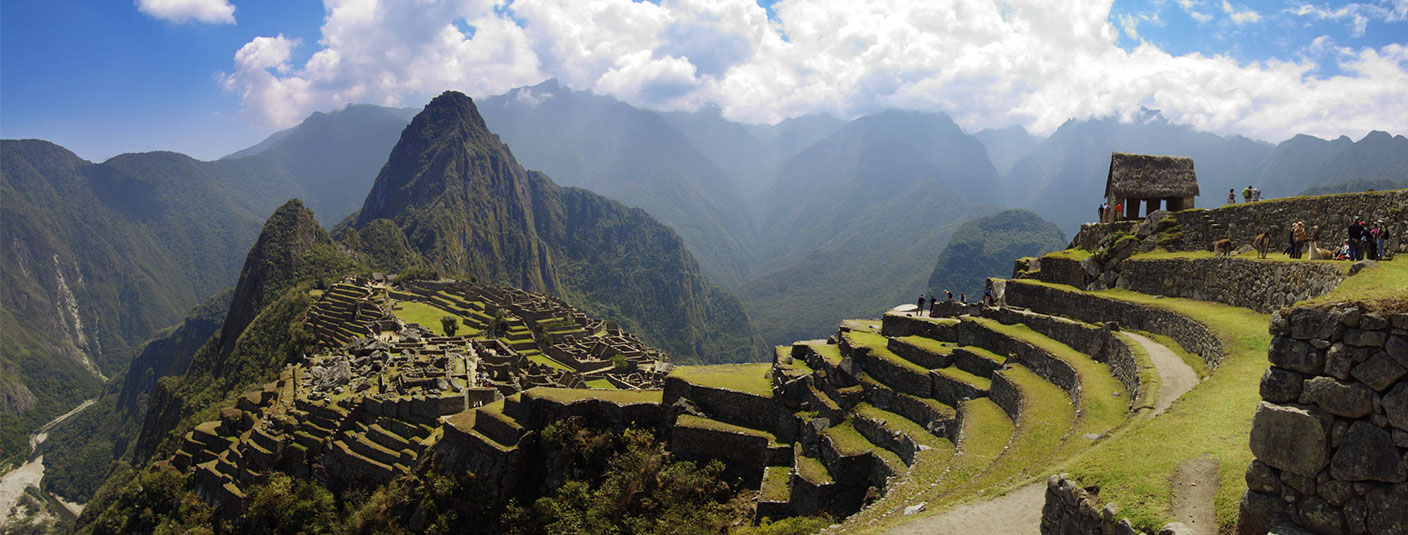
Machu Picchu
Machu Picchu is the Lost City of the Incas and inspires awe at first sight, especially if you journey there on the Inca Trail . Browse our destination guide below for essential travel details and top attractions to check out on your visit.
Only a few places in the world possess the kind of natural beauty and historic charisma that can capture the hearts and minds of visitors in an instant. Machu Picchu is one of them. Morning or afternoon, rain or shine, crowded or not - the sight of the stone temples and endless terraces set amid green-clad granite mountains never disappoints.
Forgotten after the fall of the Inca Empire and rediscovered 400 years later, Machu Picchu remains shrouded in mystery. Some questions may never be answered, but the former Inca city remains as irrefutable evidence of their highly advanced stonemasonry.
Whether by train or on your own two feet along the Inca Trail, getting to Machu Picchu is part of the adventure. Most visitors spend at least one night in Aguas Calientes, the small town at the base of the mountain from the Inca ruins. We recommend exploring the UNESCO Historic Sanctuary of Machu Picchu and New World Wonder with an expert guide, so you don’t overlook the brilliant engineering features and asserted significance built into the design of sacred temples.
Climate & Weather
Machu Picchu is at the intersection of the Andes and the Amazon, where the mild subtropical climate has warm days and cooler nights. Humidity is also higher than in Cusco and the Sacred Valley.
Dry Season and Rainy Season
Weather at Machu Picchu changes quickly and is unpredictable throughout the year. Similar to other high altitude destinations in Peru, the region has a dry and rainy season, but these conditions changes in the weather aren’t as clearly defined. The dry winter season for Machu Picchu is from April to October, and the wet summer season is from November to March. Remember, the northern and southern hemispheres experience opposite seasons.
Average Temperatures
Daytime: 68°F - 80°F (20°C - 27°C) Nighttime: 50°F - 64°F (10°C - 18°C)
Best Time to Visit
- The peak season for Machu Picchu is June, July, and August. These months coincide with the region’s dry season when sunny conditions are most probable and considered by many the best time to go to Machu Picchu. Hotels, entry tickets, and other services fill up quickly, so make your reservations well in advance.
- The low season for Machu Picchu is from December to February during the rainy season. There are fewer tourists and less crowding around attractions within the citadel. Still, the tradeoff is a much higher probability for rain, so don’t forget your raingear.
Geography & Map
- Machu Picchu is located 50 miles (80 kilometers) northwest of Cusco in the Urubamba Province of Peru, where the eastern slopes of the Andes meet the Amazon Rainforest. The Inca built their city on a high mountain ridge overlooking the lush cloud forest surroundings. Far below, Urubamba River flows along the valley floor, past Aguas Calientes.
- Elevation 7,970 ft (2,430 m)
Construction for Machu Picchu began at the height of the Inca Empire around 1450 AD. Most scholars agree the mountaintop city was the royal estate of Pachacutec, the powerful 9th king. Others speculate it was a sacred center where the great political, religious, and economic minds of the Inca Empire gathered.
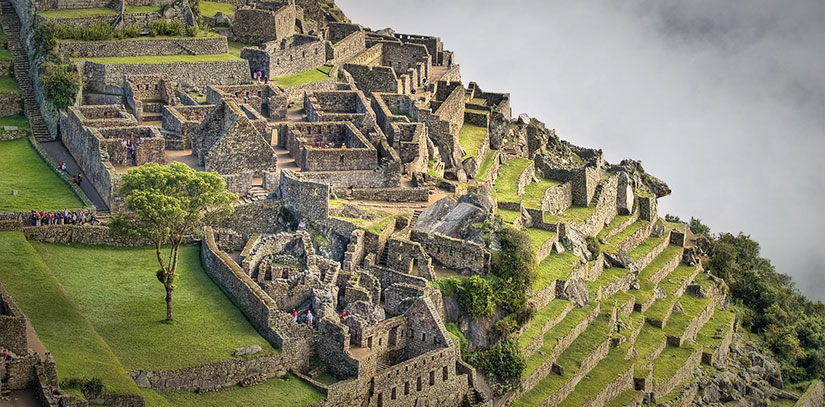
Before the construction of Machu Picchu began, they surveyed the mountaintop site. They built canals to carry freshwater to different sectors of the city. Incredibly, the Inca didn’t use steel or iron tools, nor the wheel, to make the temples, living quarters, and stone steps. Instead, they utilized simple materials such as stone, wood, and bronze. Rows of terraces were also constructed along the mountainsides for support. Without them, Machu Picchu would have tumbled down, unable to withstand centuries existing in a region prone to earthquakes and annual heavy rain.
Less than one hundred years after the construction of Machu Picchu began, during the 1530s, the city was abandoned in the aftermath of the Spanish Conquest. Widespread knowledge of the city was lost to official memory over the centuries except for some locals.
In 1911, Yale history professor Hiram Bingham chanced upon Machu Picchu while looking for the legendary city of Vilcabamba where resistance rebel leader Manco Inca retreated to safety from Spanish troops. After years of silent existence, Machu Picchu had been rediscovered and was flung into the international spotlight.
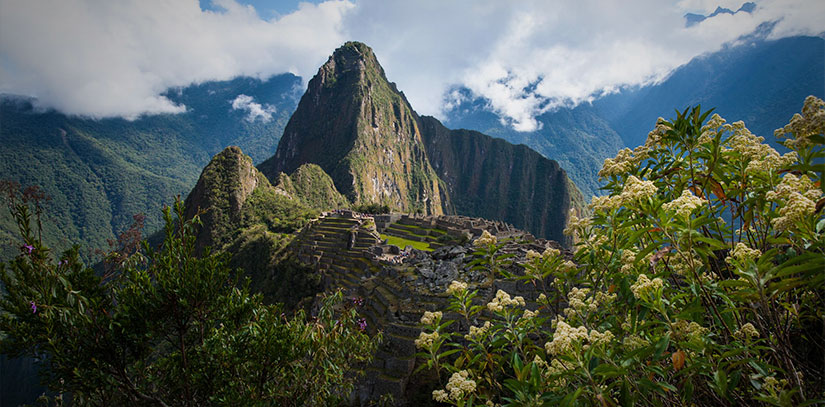
Today, Machu Picchu is a UNESCO World Heritage Sanctuary and the most visited attraction in Peru. The Ministry of Foreign Trade and Tourism counted 800,200 visitors to Machu Picchu in 2007, when the attraction was named one of the New Seven Wonders of the World, and since then that number has nearly doubled. In 2019, the famous Inca ruins were visited by 1,585,300 people from around the world.
Things to Do
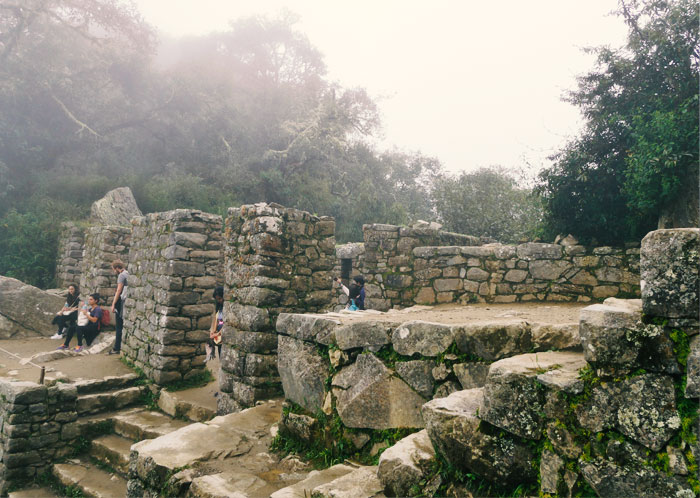
Passengers can board the train in Cusco at the Poroy Station (a 20-minute taxi ride from the city plaza) or in the Sacred Valley at the train station in Ollantaytambo and then continue along the tracks to Aguas Calientes. Upon arrival at Machu Picchu Station, the final leg of your journey is a 20-minute shuttle bus (ticket required) or uphill walk to the main entrance of Machu Picchu.
Routes & Travel Times:
- The train from Cusco to Machu Picchu is 4 hours
- The train from Ollantaytambo to Machu Picchu is 2 hours
- The train from Urubamba to Machu Picchu is 3 hours (*limited weekly departures)
Train Luggage Restrictions:
You have to travel light when you take the train to Machu Picchu because storage room onboard is limited. Each passenger is only allowed one carry-on luggage that weighs no more than 11 lbs (5kg). Many hotels in Cusco and the Sacred Valley offer free luggage storage, where you can leave a separate bag filled with belongings you won’t need for this leg of your trip.
Aguas Calientes to Machu Picchu
Aguas Calientes town is located 5.5 mi (9 km) from the Machu Picchu archeological site and 1,310 ft (400 m) of altitude lower. From the bus stop located only 3 to 5 minutes walking from the train station in Aguas Calientes, buses ferry passengers between the town and the ruins, using a zigzagging switchback road to go up and down the steep mountainside. Most tours to Machu Picchu include the bus tickets in the total price of the package. Tickets for the bus can also be purchased in Cusco or in Aguas Calientes in front of the bus stop.
The first buses depart at 5:30 am, arriving at the entrance of Machu Picchu just before the gates open at 6:00 am. Lines are usually the longest in the morning between 5:30 am and 6:15 am and when the mid-morning trains arrive from Cusco and the Sacred Valley between 9:00 am to 10:00 am.
Trekking to Machu Picchu
Adventurous travelers should trek to Machu Picchu! Trekking packages are organized so you trek to the famous archaeological site and return by train on the return leg of your journey.
The iconic 4-day Inca Trail to Machu Picchu is the most popular trek in South America. The journey takes you through high Andean passes, past lesser-known Inca sites, and culminates with a memorable entrance to Machu Picchu through the Sun Gate. There’s also the 2-day Inca Trail if you are on a tight schedule or prefer a less demanding walk.
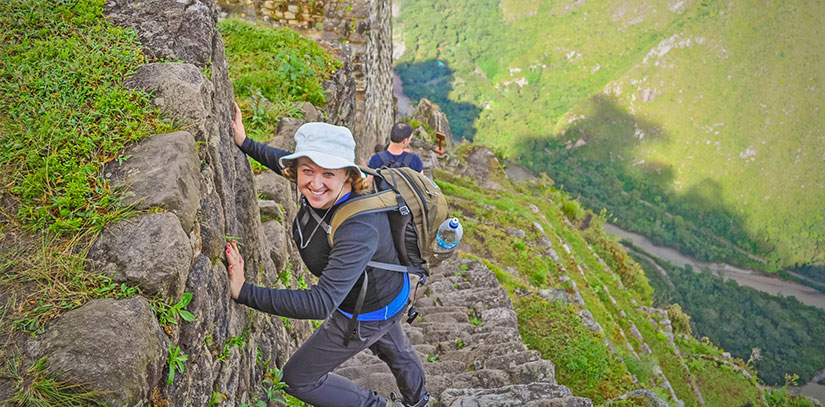
To hike the Inca Trail, you must reserve a permit in advance. There are wonderful alternative treks to Machu Picchu that don’t require a permit if Inca Trail permits are already sold out.
The 5-day Salkantay Trek is an excellent alternative trek to Machu Picchu for travelers who appreciate nature. This Andean trail passes by the imposing snow-capped Salkantay mountain, for which the trek is named, and crosses highland pampas before dropping down into a river valley cloud forest and then onto Machu Picchu. Read more about the Salkantay Trek.
The 4-day Lares Trek is another alternative recommended for trekkers whose interest lies in cultural immersion. Follow a route through the Lares Valley, passing remote villages with rich Andean traditions, beautiful mountain scenery, and lesser-known Inca ruins before touring Machu Picchu on the final day. Read more about the Lares Trek.
Visitor Guidelines
Machu Picchu Tickets
Tickets to Machu Picchu are limited and must be purchased in advance. There are general entry tickets and ones that include the hikes for Huayna Picchu (only 400 daily available) or Machu Picchu Mountain (only 400 daily available). Demand for Huayna Picchu and Machu Picchu Mountain is especially high during the peak June, July, and August dates. Advanced planning - sometimes 4 months in advance - is a must. Reserve your spot at the time you book your Machu Picchu tickets.
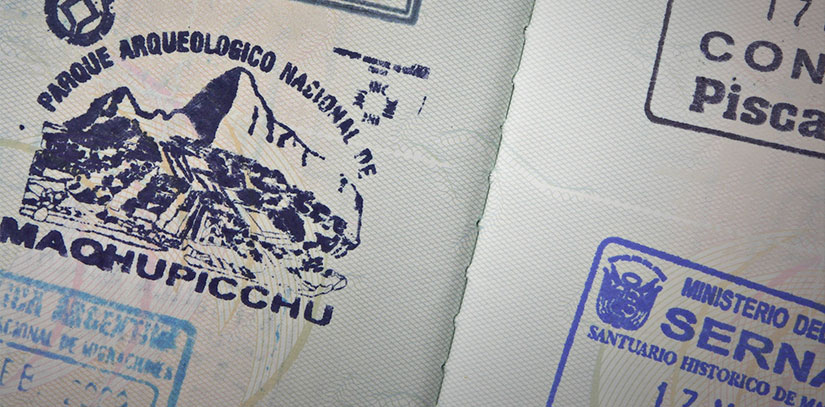
Tickets are not sold at the main entrance. If you’ve waited until the last minute, your final opportunity is at the National Cultural Institute (INC) office on the main plaza in Aguas Calientes.
Time in Machu Picchu
The time designated for you to enter Machu Picchu is selected when you buy your tickets in advance. For whichever assigned time indicated on your ticket, you have the full hour to enter the archaeological site. We suggest you arrive at the bus stop in Aguas Calientes at least one hour before your entrance time at the Machu Picchu ruins.
- An entry ticket to Machu Picchu is valid for 4 hours.
- An entry with a Huayna Picchu ticket gives you 6 hours to go on a Machu Picchu tour and do the hike.
- An entry with Machu Picchu Mountain ticket gives you 7 hours to take a guided tour and do the hike. This hike is longer than Huayna Picchu hence why you have more time in Machu Picchu.
Walking circuits around Machu Picchu help control foot traffic. Routes 1 and 2 (indicated in green and red on the map) pass similar attractions but explore different sections of the agricultural zone near the main entrance gate. Route 3 in blue is an alternative walking route so visitors with hiking permits can do Huayna Picchu or Machu Picchu Mountain.
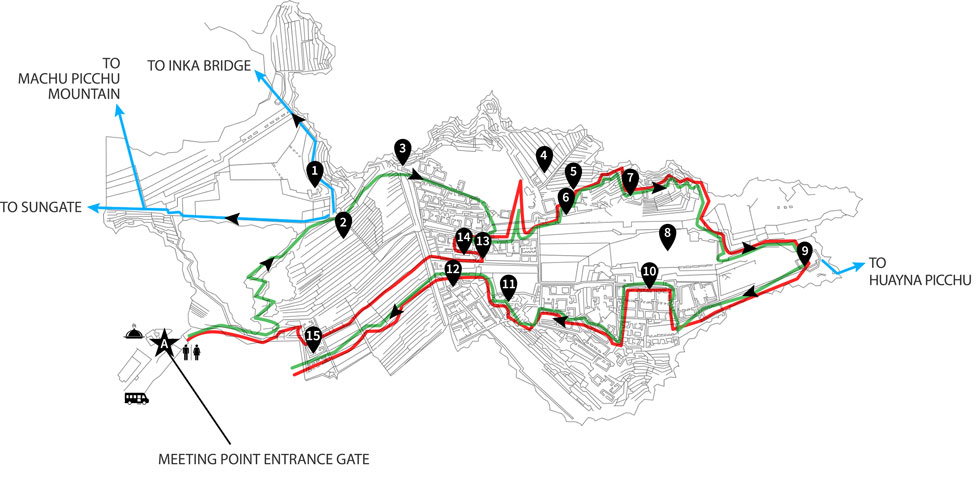
Points of interest:
- Guardhouse.
- Agricultural Zone.
- West Agricultural Zone.
- Temple Zone.
- Temple of The Three Windows.
- Astronomical Observatory.
- Main Square.
- Sacred Rock.
- Group of the Three Doorways.
- Royal Enclosures.
- Temple of The Condor.
Walking Circuits:
- Alternative Routes (hikes)
Options for Machu Picchu hotels range from 5-star luxury resorts to budget dorms and everything in between. Machu Picchu Sanctuary Lodge is the only hotel up on the mountain next to the main entrance of the archaeological complex. All other accommodations are in Aguas Calientes and walking distance from the train station.
It’s possible to make a whirlwind Machu Picchu trip in one day. Still, we recommend enjoying this highlight of your trip at a slower pace, if possible. Staying a night or two in Aguas Calientes spaces out the legs of transport to and from Machu Picchu and helps you stay rested for an active day of touring. The following are our Top Pick Hotels for travel to Machu Picchu.
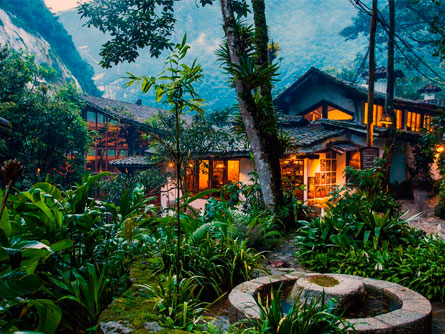
Inkaterra Machu Picchu Pueblo Hotel
Kilometer 110 Via Ferrea, Aguas Calientes, Machu Picchu
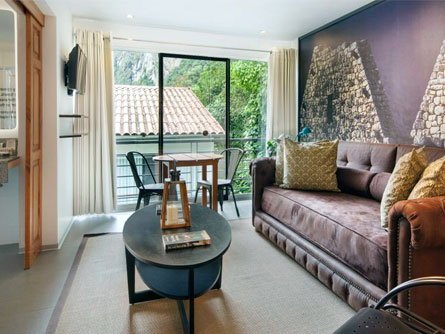
Av. Pachacutec 109, Aguas Calientes, Machu Picchu
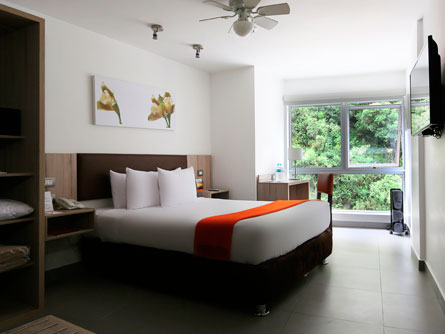
Casa Andina Standard Machu Picchu
Prolongacion Imperio de Los Incas E - 34, Aguas Calientes, Machu Picchu
Waman Hotel
Calle Wiracocha 202, Aguas Calientes, Machu Picchu
See all Machu Picchu Hotels
Restaurants
Eating options outside the entrance to Machu Picchu are convenient, though limited. You can take a pre-made box lunch with you to Machu Picchu (available options depend on your itinerary), eat a buffet lunch at Belmond Sanctuary Lodge, or grab a quick bite at the Machu Picchu Snack Bar.
Down the hill in Aguas Calientes the restaurant selection is far more varied. Enjoy a casual sitdown meal in Machu Picchu’s gateway town at one of the following restaurants:
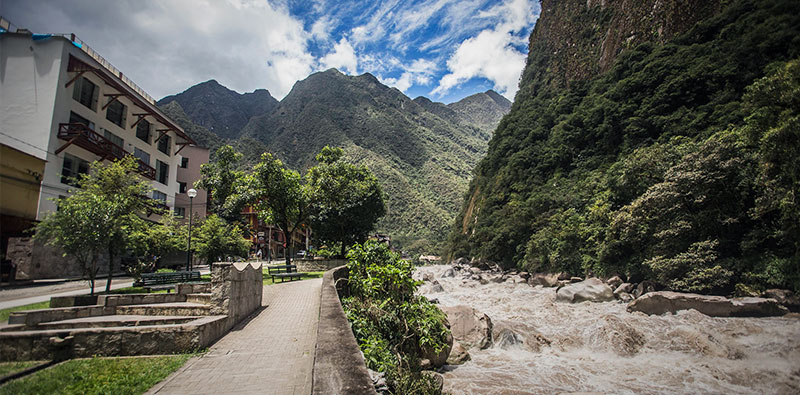
Chullpi Machu Picchu
Chullpi serves mouth-watering Peruvian fusion dishes, including trout ceviche, perfectly grilled chicken breast, and delicious salads, and tasty appetizers. If you’ve got room for dessert, go for the Tres Leches cake. 140 Av. Imperio de Los Incas, Aguas Calientes| website
Incontri del Pueblo Viejo
Incontri del Pueblo Viejo will satisfy your craving for carbs with homemade pasta and wood-fired pizzas featuring fresh toppings and real mozzarella. Wash it all down with a craft beer or an Italian or South American wine. Av. Pachacutec, block 6 (no number), Aguas Calientes| website
Indio Feliz Restaurant Bistro
Indio Feliz is a perennial favorite among travelers for its menu of Peruvian classics with a French twist. Try the river trout or the grilled chicken, each prepared with seasonal Andean ingredients. Check out the quirky Captain’s Bar before or after dinner. Calle Lloque Yupanqui 103, Aguas Calientes | website
The Tree House Restaurant
The Tree House is a few steps above the rest, in both the culinary and the literal sense. Located up a steep alleyway on the edge of town, this excellent restaurant serves a menu of Peruvian fusion cuisine shaped by Andean, Italian, Asian, and Latin American influences. Try the mushroom and goat cheese ravioli, pork ribs in sweet elderberry sauce, or alpaca tenderloin topped with blue cheese. Calle Huanacaure 105, Aguas Calientes | website
Toto’s House
Toto's House is ideal for large groups, serving an all-you-can-eat buffet as well as an extensive a la carte menu. A convenient location close to the train station, views over the river, and live music in the evenings round out Toto’s offer. Av. Imperio de Los Incas 600, Aguas Calientes | website
Tour Packages

Machu Picchu, Cusco, Sacred Valley 4 Days / from $989
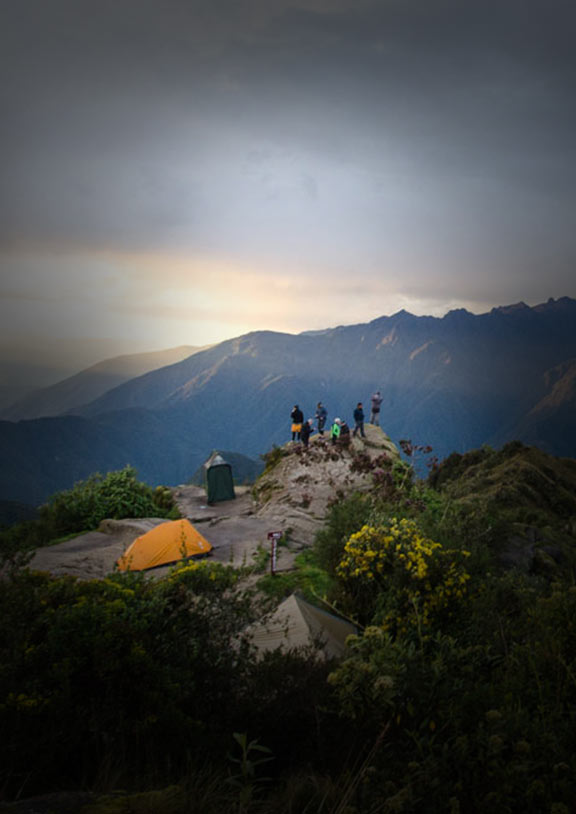
My 4 Hiking Options at Machu Picchu
Decide what Machu Picchu hiking option is the best for you. Take the Sun Gate or Inca Bridge trails. Other options are the climbs up Huayna Picchu or Machu Picchu Mountain.
Read more »
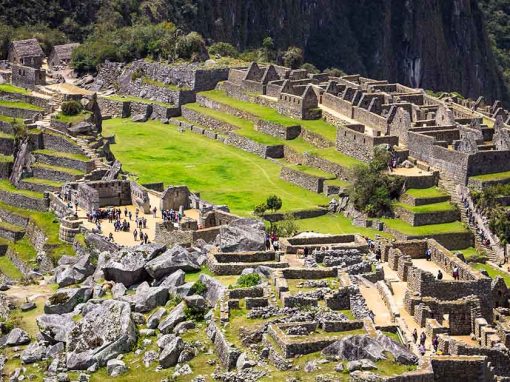
20 Machu Picchu Facts to Know Before Your Trip!
Have a trip to Peru coming up? Well, it’s time to brush up on your Machu Picchu facts! Machu Picchu

Book With Confidence
We're flexible! Postpone your tour with zero cost up to 30 days prior to departure.
By submitting this form, you agree to receive recurring customer care text messages from Peru for Less at the number used when signing up. Msg frequency varies. Msg and data rates may apply. View Terms & Privacy .
The following preferences are optional , but will help enhance your trip's customization.
Are you interested in visiting the best restaurants in Latin America?
TIP: Tell us the destinations you have in mind.
Galapagos Tours
Amazon Rainforest
Galapagos Islands
Sacred Valley
Lake Titicaca
5000+ Testimonials
+1 817 230 4971
Personalized Service
Handpicked hotels.
Get Daily Travel Tips & Deals!
By proceeding, you agree to our Privacy Policy and Terms of Use .
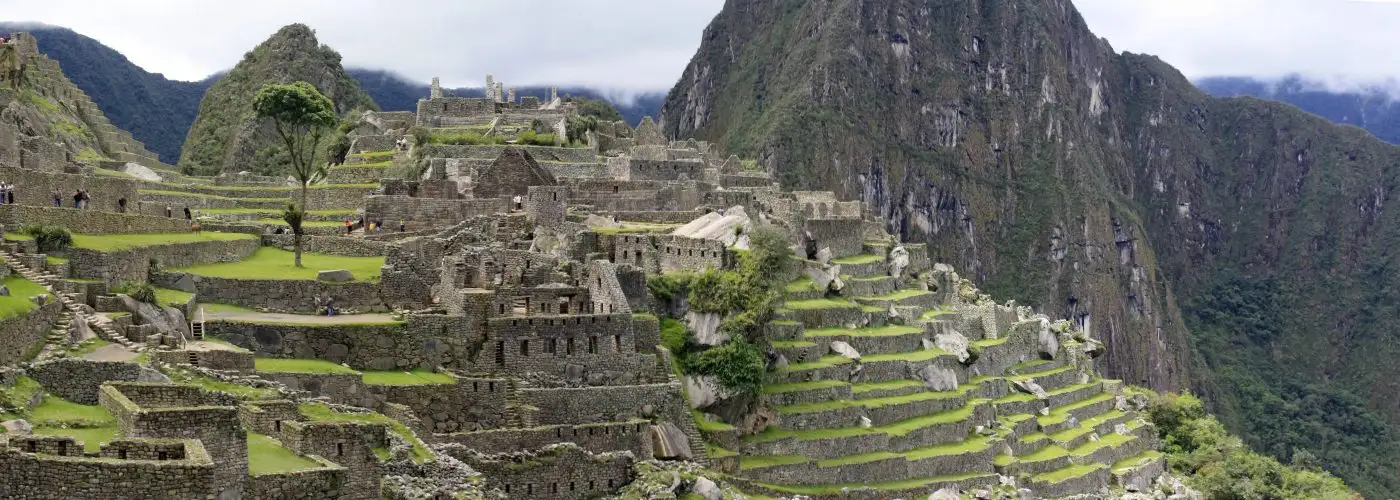
Machu Picchu Travel: Everything You Need to Know
Sarah Schlichter
Deputy Executive Editor Sarah Schlichter's idea of a perfect trip includes spotting exotic animals, hiking through pristine landscapes, exploring new neighborhoods on foot, and soaking up as much art as she can. She often attempts to recreate recipes from her international travels after she gets home (which has twice resulted in accidental kitchen fires—no humans or animals were harmed).
Sarah joined the SmarterTravel team in 2017 after more than a decade at the helm of IndependentTraveler.com. Sarah's practical travel advice has been featured in dozens of news outlets including the New York Times, the Chicago Tribune, USA Today, Budget Travel, and Peter Greenberg Worldwide Radio. Follow her on Twitter @TravelEditor .
The Handy Item I Always Pack: "A journal. Even years later, reading my notes from a trip can bring back incredibly vivid memories."
Ultimate Bucket List Experience: "Road tripping and hiking through the rugged mountains of Patagonia."
Travel Motto: "'To awaken quite alone in a strange town is one of the pleasantest sensations in the world.'—Freya Stark"
Aisle, Window, or Middle Seat: "Aisle. I get restless on long flights and like to be able to move around without disturbing anyone else."
Email Sarah at [email protected] .
Travel Smarter! Sign up for our free newsletter.
Hidden away for centuries in the mountainous cloud forests of Peru, the well-preserved Incan ruins of Machu Picchu are a must for any traveler’s bucket list. Though the UNESCO World Heritage site’s origins remain mysterious—was it a royal retreat? A religious site? The famed lost city of the Incas?—Machu Picchu travel has become a booming business, with upwards of 1.1 million visitors flocking to it each year.
[viator_tour destination=”937″ tours=”32188P3,18940P3,19945P3″]
Machu Picchu Travel Tips
To make the most of your trip, you’ll want to know the best time to visit Machu Picchu in order to avoid crowds, plus the best way to get there, and which type of ticket you should buy. For help planning a trip to Machu Picchu, use these comprehensive tips.
The Best Time to Visit Machu Picchu
The busiest time of year to visit Machu Picchu is between July and October, when the weather is typically dry and pleasant. If you’re planning your Machu Picchu travel for this time period, prepare for crowds and make sure to book tickets and tours well in advance.
The rainy season runs from November through March or early April, with downpours (and muddy trails) at their peak between January and March. The Inca Trail is closed each February for maintenance.
If you’re looking to avoid the worst of the crowds without risking too much rain, visit Machu Picchu during the months of April, May, and June.
The Inca Trail and Alternative Machu Picchu Treks
The most popular way for adventurous travelers to reach Machu Picchu is the famous Inca Trail, which takes you on a four-day trek through the mountains and directly to the ruins. For those who don’t have the time and/or fitness to conquer the full trail, there’s a two-day version of the Inca Trail that’s shorter and easier. Note that access to the trail is restricted to just 500 people per day (including support staff—you can’t hike the Inca Trail without a guide), and permits sell out months in advance.
Fortunately, there are less crowded alternative hikes to choose from. Consider the strenuous five-day Salkantay trek for incredible high-altitude scenery, or the four-day Lares trek for stops in local Andean communities. If you’re really up for a challenge, consider the Choquequirao trek , which takes you to hidden Incan ruins that most visitors to Peru never get to see.
Companies such as SAS Travel and Llama Path offer organized trips for these and other Machu Picchu treks.
Machu Picchu Package Tours
It’s nearly impossible to book a group tour of Peru that doesn’t include a stop at Machu Picchu. G Adventures , Intrepid Travel , and National Geographic Expeditions are among the many companies that offer package tours of Peru.
You can also book a shorter tour of Machu Picchu as part of an independent vacation. Just about every travel agent in Cusco can book a day or overnight trip from there to Machu Picchu, or you can reserve one in advance on SmarterTravel’s sister site, Viator . If you have the time, we’d recommend an overnight stay in the Machu Picchu area; driving to and from Cusco makes for a long, grueling day trip, starting as early as 4:00 a.m.
Planning an Independent Visit to Machu Picchu
Not a fan of traveling with groups? It’s easy enough to arrange your own visit to Machu Picchu. Most travelers arrive at Machu Picchu Pueblo (also known as Aguas Calientes) via a train from Cusco, Urubamba, or Ollantaytambo. Peru Rail and Inca Rail are the two main providers; you can buy tickets on their websites or at their ticket offices around Peru.
To get to the ruins, most visitors take a 20-minute bus ride up a winding mountain road. You can buy tickets to do so from the booths next to the bus station in downtown Machu Picchu Pueblo. Alternatively, you can walk from the pueblo to the ruins, which takes about 90 minutes and is mostly uphill.
You must buy your ticket to Machu Picchu in advance, through either the official government website or a travel agency: You can’t buy Machu Picchu tickets on arrival. Note that the government website only accepts bookings with a Visa credit card ( not Mastercard or American Express), and can be a bit confusing to use, especially if you don’t speak Spanish. You can use a Google Chrome browser to translate the site into English.
Machu Picchu recently made changes to its ticketing policy in an effort to manage the flow of crowds. Now you buy your ticket based on hourly entrance times, and although you can enter after the time stamped on your ticket, you won’t be able to get in before, though your ticket might have a more specific time table that you would need to adhere to. You’ll take a guided tour, which takes two to three hours, and if you exit, you won’t be able to get back in.
If you don’t use your ticket on the specified date and time, you won’t get a refund, and you won’t be able to use your ticket to enter Machu Picchu at any other day or time. The most popular entry time into the archaeological wonder is as early in the morning as possible: 6:00 a.m. If you want this time slot (or any other), book it on Machu Picchu’s official website (run by Peru’s Ministry of Culture) as soon as possible, as there are only 5,600 tickets sold each day. The site closes, and all visitors must be out, by 5:30 p.m.
Huayna Picchu and Machu Picchu Mountain
There are two optional hiking areas within the Machu Picchu ruins that require special tickets to access.
Huayna Picchu is the more popular of the two, involving a climb up the famous peak that appears in the background of most classic Machu Picchu photographs. At the trail checkpoint, you’ll see signs for both Huchuy Picchu and Wayna Picchu. Don’t be confused: Wayna is an alternate spelling of Huayna. Huchuy Picchu is the small mountain in front of Huayna Picchu.
The trip to the top of Huchuy Picchu and back takes only about 45 minutes. For more spectacular views, hike to the top of Wayna Picchu, which takes about two hours roundtrip. From this path you can also take a detour to see the Temple of the Moon, part of the Gran Caverna , or Great Cave, complex. This adds another hour or two to your total trekking time.
Hiking Machu Picchu Mountain is also an option, and is more rigorous and less crowded than the Huayna Picchu trail. Located on the opposite side of the ruins, Machu Picchu Mountain is higher than Huayna Picchu (it tops out at more than 10,000 feet, compared to Huayna Picchu’s 8,900 feet), so some travelers may be affected by the altitude. This hike takes an hour longer than Huayna Picchu, but the views are similarly spectacular.
Both the Huayna Picchu and Machu Picchu Mountain hikes are restricted to 200 visitors for each entry period: between 7:00 and 8:00 a.m., or between 10:00 and 11:00 a.m.
Machu Picchu Hotels
If you want to sleep right next to the ruins and be the first in line when they open at sunrise, you have one very expensive option: The luxe Belmond Sanctuary Lodge is located steps from the main entrance.
Most visitors stay in nearby Machu Picchu Pueblo, a small but bustling town with lodging options for every price point. One of the most indulgent is the Inkaterra Machu Picchu Pueblo , which is within walking distance of restaurants and the train station but feels like a remote resort, complete with bubbling fountains and lush landscaping. Guests stay in private casitas with colonial-style furniture, and many feature fireplaces or private plunge pools.
More moderately priced options in Machu Picchu Pueblo include the Casa Andina Standard and the Tierra Viva Machu Picchu , both of which offer comfortable rooms with river views.
Need-to-Know Machu Picchu Travel Tips
First and foremost, wear comfortable shoes : Machu Picchu is a large site with lots of hills and stairs, and there are few places to sit and rest. Walking sticks are prohibited except for “elderly and incapacitated” visitors, according to the official ticket. If you do need to use a stick or cane, make sure it has a rubber tip to protect the ruins. Visitors with wheelchairs can access the site with an operator called Wheel the World .
The weather can change quickly in the mountains, so you’ll want to pack sunscreen, a wide-brimmed hat, and rain gear . Throw in some insect repellent to fend off pesky mosquitoes.
The only toilets on site are right outside the entry gates. Bring change; there’s a small fee to use them.
Food options near the main gates are limited to a pricey buffet at the Belmond Sanctuary Lodge and a mediocre snack bar. Note that eating is technically forbidden within the ruins, though we spotted fellow hikers refueling with granola bars at the top of Wayna Picchu—just be sure to take any trash out with you.
To learn more about the history of Machu Picchu, stop at the Museo de Sitio Manuel Chavez Ballon , a small museum with information about the ruins. It’s located about a 30-minute walk from Machu Picchu Pueblo.
More from SmarterTravel:
- Machu Picchu: How to Plan a Perfect Trip to the Lost City of the Incas
- Machu Picchu Is Overrated, Go to Choquequirao Instead
- Sacred Valley, Peru: How to Plan the Perfect Trip
[viator_tour destination=”927″ type=”3-mod” tours=”14086P20,5243P120,65921P14″]
Sarah Schlichter recently spent the night in Machu Picchu Pueblo courtesy of Inkaterra Machu Picchu Pueblo. Follow her on Twitter @TravelEditor for more travel tips and inspiration.
Editor’s note: This story was originally published in 2018. It has been updated to reflect the most current information.
We hand-pick everything we recommend and select items through testing and reviews. Some products are sent to us free of charge with no incentive to offer a favorable review. We offer our unbiased opinions and do not accept compensation to review products. All items are in stock and prices are accurate at the time of publication. If you buy something through our links, we may earn a commission.
Top Fares From

Don't see a fare you like? View all flight deals from your city.
Today's top travel deals.
Brought to you by ShermansTravel
Porto to Lisbon: 7-Nt, Small-Group Portugal...
Indus Travels

Greenland: Luxe, All-Incl. 11-Nt Exploration Small-Ship...
Swan Hellenic
Ohio: Daily Car Rentals from Cincinnati

Trending on SmarterTravel
Protect Your Trip »
Machu picchu tours: how to get there and tips for visiting.
Here is everything you need to know to plan a trip to Machu Picchu.
How to Get to Machu Picchu

Getty Images
A hike around Machu Picchu is a must-do if you're visiting Cusco, Peru.
Note: Some of the below destinations may be affected by the civil unrest in Peru. Check with the U.S. Department of State before traveling.
Machu Picchu is thought to be one of the largest and most impressive Incan cities of its time. Today a UNESCO World Heritage Site with expansive ruins open to visitors, it sits high on a peak in the Peruvian Andes and is accessed via train or on foot. Here are some tips to help you navigate a visit to this incredible archeological site.
What is Machu Picchu? Machu Picchu is a 15th-century Incan city that was abandoned by the Incas after the Spanish conquest. The ruins feature about 200 structures that were used for religious, agricultural, astronomical and ceremonial purposes, though exactly how remains a mystery. It's believed that between 300 and 1,000 people inhabited the city and the area was devoted to the worship of the sun god.
Where is Machu Picchu? Machu Picchu is located in the Peruvian Andes within a tropical mountain forest at nearly 8,000 feet above sea level. Cusco , the nearest major city, is less than 50 miles southeast of Machu Picchu.
When was Machu Picchu built? Historians believe that Machu Picchu was built in the 15th century.
How do you get to Machu Picchu? Machu Picchu can be reached a variety of ways, including hiking the Inca Trail with a tour company, by train or by bus.
When is the best time to visit Machu Picchu? The site is located in the Amazon rainforest in Peru, where the rainy season runs from November to March. To avoid rain, travelers may want to visit during its dry season from April to October. Travelers say that June through August tends to be the busiest, so opting for shoulder months like May or October may help avoid crowds.
Know Before You Go
- What: Machu Picchu tours
- When: Machu Picchu is accessible daily with entrances from 6 a.m. to noon or noon to 5:30 p.m. During the month of February, the Inca Trail is closed for maintenance and is inaccessible to visitors.
- Cost: Entrance tickets cost approximately 152 Peruvian soles (about $45) for adults; 77 soles (around $23) for students.
- Must-know tip: To tour Machu Picchu, you must purchase your ticket online in advance and print it out as no tickets are sold at the site. Experts and fellow travelers recommend purchasing your ticket several months in advance as there only 2,500 visitors allowed per day. If you choose to visit with an organized tour company, the company will take care of reserving and purchasing the ticket for you.
- Website: https://www.machupicchu.gob.pe/inicio
When visiting Machu Picchu, you will be given a specific time you can enter the site. Key attractions include the Temple of the Sun, the Room of the Three Windows, the water irrigation system and the Royal Mausoleum. There is an additional fee to visit the mountains of Machu Picchu and Huayna Picchu, which surround the old city, should you want to hike trails there. After you purchase your ticket – either to Machu Picchu or the site with one of the mountains – be sure to print your ticket and bring it with you along with identification, such as a passport.
Restrooms are located outside the entrance and cost about 2 soles (around 60 cents) to use; there are no restrooms within Machu Picchu. There's no visitor center, but Peru's Ministry of Culture does have an office in Aguas Calientes, a town that acts as the gateway to Machu Picchu. There are also a variety of restaurants in Aguas Calienties to refuel after your trip. Be aware, you also may not be allowed to bring single-use plastics (like sandwich bags) or large bags into the site. If you do bring a large bag, there is a bag storage facility near the site's entrance where you can leave your bag for a small fee as you explore the site.
Machu Picchu is located less than 50 miles northwest of Cusco, a Peruvian city which is also a UNESCO World Heritage Site. Cusco can make a great base for your visit to Machu Picchu as many organized tours to the site begin here.
Since Machu Picchu and Cusco sit at high elevations, almost 8,000 feet above sea level, travelers should prepare for altitude sickness. Talk to your doctor before your trip to make sure your body can handle the altitude change. When you arrive, help your body adjust by getting plenty of rest for the first few days, avoiding alcoholic beverages and drinking lots of water to remain hydrated. You should also plan to wear insect repellent and plenty of sunscreen for the trek. Travelers also recommend dressing in layers and wearing pants and long sleeves, even if the weather is warm, as the mosquitos are known to be relentless.
Tour Options
Though you can opt to visit Machu Picchu (and make the necessary travel arrangements) by yourself, a guided tour can help streamline the process. Multiple tour operators offer daytrips to Machu Picchu. The majority of these tours originate in Cusco and leave early in the morning (at or before 5 a.m.). You'll be taken via bus to the town of Ollantaytambo, where groups board trains to Aguas Calientes. From Aguas Calientes, groups board a bus to Machu Picchu. Travelers generally spend approximately two hours at the site before they begin the trip back to Cusco. Exact tour prices vary, though you can expect to spend approximately $300 per person (including train tickets, bus fare and a guided tour of the site). Travelers generally enjoy the tours, extolling the knowledgeable guides, and appreciate the ease by which they could see Machu Picchu. Others caution selecting your tour company carefully as experiences can vary wildly from company to company.
Travelers can also opt to hike from Aguas Calientes to Machu Picchu on their own via the Carretera Hiram Bingham. The approximately 4-mile journey is a steep climb and can be completed in around 90 minutes. Though an option, most travelers say the walk is long, difficult and lacking in scenery.
Tourists who have ample time, or have a true adventure streak, can hike the Inca Trail to Machu Picchu. The approximately 25-mile trail takes about four days to hike and ends at Machu Picchu. To hike the Inca Trail, you must go with a tour company or hire a guide, as it is no longer permitted to hike the trail on your own. Keep in mind that the trail closes each February for maintenance. Tours can last as little as two days (for an abbreviated journey along the trail) or more than a week to experience additional Peruvian sites.
There are a variety of other attractions and ancient sites nearby Machu Picchu that you may want to add to your itinerary. Titicaca Lake, located at more than 12,000 feet above sea level, is the largest lake by volume in South America. The town of Cusco also has much to see, including cathedrals , temples and a plaza used in Incan times , along with many archeological sites. Take advantage of the Cusco Tourist Ticket (also known as Boleto Turistico del Cusco), which grants access to many of Cusco's attractions for one fee.
Getting There
You can reach Machu Picchu by foot, train or bus, though if arriving by train, your ride will end in Aguas Calientes and you will need to ride a bus or hike approximately 4 miles to access the site. You can take a train from one of several stations near Cusco to the city of Aguas Calientes and then ride a bus to Machu Picchu. (Note: Since these train stations are outside Cusco city proper, you'll need to take a bus to get to them). The train ride via Peru Rail takes about four hours and you can choose from a variety of train types, each with a different price point to accommodate any travel budget. Tickets for Peru Rail are available at PeruRail.com.
You can buy bus tickets from Aguas Calientes to Machu Picchu in advance in Cusco at the Consettur offices, which helps you avoid lines at the actual bus stop. Buses depart from Aguas Calientes approximately every 15 minutes beginning at 5:30 a.m. daily until 3:30 p.m. Visitors recommend getting in line for the bus several hours before your scheduled entrance time at Machu Picchu as lines can be extremely long. Some travelers report getting in line three hours before their scheduled entrance time. You'll also likely encounter lines to take the bus from Machu Picchu back to Aguas Calientes.
Additional tour options:
- CuscoPeru : Full-Day Private Machu Picchu Guided Tour from Cusco. View & Book Tickets »
- Viajes Pacifico : Machu Picchu Day Trip. View & Book Tickets »
- Viajes Peru : Day Tour to Machu Picchu The Inca City. View & Book Tickets »
- Machupicchu Latin America : 2-Day Tour: Sacred Valley and Machu Picchu by Train. View & Book Tickets »
- Inkayni Peru Tours : Full day. View & Book Tickets »
Looking for more information on Machu Picchu? Check out the U.S. News Travel Cusco guide .
Tags: Tours , Travel , Vacations , Peru
World's Best Places To Visit
- # 1 South Island, New Zealand
- # 4 Bora Bora
If you make a purchase from our site, we may earn a commission. This does not affect the quality or independence of our editorial content.
You May Also Like
The best east coast beaches.
April 19, 2024

The Best Carry-on Luggage
Erin Evans , Rachael Hood , Catriona Kendall , Amanda Norcross and Leilani Osmundson April 17, 2024

The Best Hard-sided Luggage Picks

The Best Luggage Brands
Rachael Hood April 17, 2024

The Best Yellowstone National Park Tours
John Rodwan April 17, 2024

The Best Rome Colosseum Tours
Laura Itzkowitz April 17, 2024

Best Alaska Tours
Lyn Mettler April 16, 2024

The Best Fredericksburg Wine Tours

The Best Personal Item Bags
Rachael Hood April 16, 2024

The 17 Best Costa Rica Tours
Lyn Mettler April 12, 2024


- Peru Tour Packages
- Customized Tours
- Destinations
- EN EN ES DE
- +51932671370
Machu Picchu Tours
- Inca Trail Tours
Salkantay Trek
- Amazon Jungle Tours
- Machu Picchu
- Sacred Valley
- Rainbow Mountain
- Humantay Lake
- Huacachina Oasis
- Huacachina & Paracas
- Lake Titicaca
- Amazon Jungle
- Machu Picchu Guide
- Peru Travel Tips
- Things to do in Cusco
- Things to do in Lima
- Peru Amazon Guide
Home » The Ultimate Machu Picchu Travel Guide
The Ultimate Machu Picchu Travel Guide
- 23 January, 2022
- by Konsti Sobon
- Reading time: 9 minutes

The Lost City of Machu Picchu is one of the most iconic archeological treasures in all of South America. Tucked away in the cloud forests of the Andes, Machu Picchu is believed to have been a royal estate or sacred religious site for Inca leaders.
Today, its mountain top location, finely crafted stonework, and ancient history make Machu Picchu Peru’s most sought-after destination.
Ready for an adventure? Here’s a rundown of everything you need to know before you head off to one of the world’s most famous man-made wonders.
Plan Your Visit
Machu Picchu is the most popular Inca site in Peru, which means that you need to plan your visit well in advance.
When planning for Machu Picchu, there are some key milestones to hit before you start packing. For an enjoyable adventure, your first steps should be focused on deciding on the best time to go and how to best adjust to the altitude difference.
Here are some pointers to help you kick-start your planning.
The ancient citadel of Machu Picchu is open all year round. Before booking, though, it’s sensible to note how much rain (and slippery paths) you are willing to handle.
Peru has two main seasons: dry and wet. The peak travel season coincides with the region’s dry season – from April to September. During this time, the Machu Picchu weather is usually milder, making it easier and more comfortable to walk the ancient paths of the Incas.

Our travelers enjoying their time at Machu Picchu and making use of our guide’s great photography skills.
During Peru’s wet season (October/November to March), Machu Picchu, and the trails leading to it, are typically less crowded. During those months, rainfall and storms can be unpredictable and heavy, so this might not be the best time to hike to the site.
That said, rain at Machu Picchu rarely lasts for more than 2 hours, so whenever you choose to go, you’re unlikely to be covered in rain during your entire visit.
Note: When planning your itinerary, remember that the trails to Machu Picchu are closed during the entire month of February due to restoration work.
How To Get Acclimated
Altitude sickness is triggered by a rapid change in elevation. At higher altitude destinations, such as Machu Picchu, the oxygen is less dense and, if not properly acclimated, your body will have a tough time adapting to the lower air pressure and oxygen levels.
Because altitude sickness symptoms include shortness of breath, nausea, fatigue, and vomiting, you’re going to want to acclimate before you embark on any adventure in Peru.
To let your body adjust, be sure to acclimate in Cusco (a captivating city near Machu Picchu) for at least a couple of days. Other tips to help you with high elevation include:
- Drinking plenty of fluids (before and during your stay in Peru)
- Stocking up on coca leaves and coca products
- Eating lightly, but including a sufficient amount of carbohydrates and vegetables
- Consulting your doctor/pharmacist on suitable altitude sickness medication
Top Sights to Visit
Machu Picchu is an archaeological gem and a fantastic example of the architecture, agriculture, and engineering of the Incas. Adding to that, the site is located atop a mountain ridge, between the two peaks of Machu Picchu Mountain and Huayna Picchu.
Apart from the ancient citadel, those peaks are among the best sights to visit during the Machu Picchu day tour and witness the site from above.

This picture offers great overview of where Machu Picchu Mountain, Huayna Picchu and the actual Machu Picchu site is located.
Machu Picchu Mountain
At Machu Picchu, you can opt for an additional hike to Huayna Picchu or Machu Picchu Mountain (the two mountains situated in front and behind the site). Some of the main differences between Machu Picchu Mountain and Huayna Picchu include the elevation level and the duration of the hike.
Machu Picchu Mountain sits at an elevation of around 3,082m (10,111ft) and climbing up to the top and back will take you around 2.5 – 3 hours. Huayna Picchu, on the other hand, has an elevation of 2,693m (8,835ft) and the hike takes 1.5 – 2 hours to complete.
Although you’ll need to purchase an extra ticket, hiking up Machu Picchu Mountain (as pictured below) offers an unforgettable view of the surrounding landscape.
Huayna Picchu
The Huayna Picchu Mountain rises in the northern area of Machu Picchu. It is also featured in the background of some of the most famous photographs of the site. Many historians believe that this mountain was a sacred place for performing religious ceremonies and giving offerings to the gods.
Just like the Machu Picchu Mountain, climbing up the Huayna Picchu Mountain will require a separate entrance ticket.
To get to the top, you will need to follow a strenuous trail with some narrow and steep sections. The panoramic view of the ancient Incan ruins, however, is something that you’re unlikely to forget.
The Sun Gate
The Sun Gate, also known as Inti Punku, is another site that deserves a visit. Offering a fantastic view over the whole of Machu Picchu, the Sun Gate hike is a fantastic alternative to Machu Picchu Mountain and Huayna Picchu.
The viewpoint is located to the side of Machu Picchu Mountain at an elevation of 2,720m (8,924ft).

The Sun Gate is the only additional hike at Machu Picchu that is free and it’s absolutely worth it.
If you’ve embarked on one of the Inca Trail hikes, you will enter Machu Picchu through the Sun Gate, where you’ll also get your first glimpse of the mysterious Lost City of the Incas.
If you’re coming from Aguas Calientes, you can get to Inti Punku once you’ve entered the site. From the Guardhouse at Machu Picchu, you can climb to the viewpoint in about 1,5 hours.
Trails to Machu Picchu
Some of the most mesmerizing scenery in the world can only be reached by foot, and Machu Picchu is no exception.
Undoubtedly, two of the most mesmerizing Machu Picchu treks are the Inca Trail and the Salkantay Trek. Here are some things you should know before booking your hike.
The Inca Trail is by far the most popular way of how to get to Machu Picchu .
The classic Inca Trail tours follow the route the ancient Incas took. As you hike your way to the ancient site, you’ll notice that a big portion of the original stonework along the way is still in place. You will also pass through mesmerizing mountains, alpine tundra, and cloud forests.
The Salkantay Trek is an excellent alternative to the Inca Trail tour. Although the Inca Trail offers more ruins along the road, the 5-day Salkantay Trek tour is often less crowded and offers nature-rich experiences with a wide variety of breathtaking scenery.

Hiking past the majestic Salkantay mountain and sleeping in the sky domes are some of the things that make this trip really unique.
Not for the faint of heart, the Salkantay Trek will take you to altitudes above 4,600m (15,091ft), the flora and fauna of the Andean jungle, and the sacred Salkantay Mountain before reaching Machu Picchu. Before hopping on your trip to Machu Picchu, check out which trail could be the best for you !
Food and Lodging
Whether you’re going on a day trip or a multi-day hike in the Salkantay Mountain, an overnight stay at Aguas Calientes is highly recommended if you want to experience Machu Picchu early in the morning.
Because of its proximity to Machu Picchu, Aguas Calientes has a whole range of hotels, restaurants, cafes, and small shops.
It’s also good to know that food is not allowed inside the archaeological site of Machu Picchu. Be sure to have a good breakfast before heading off.
Expert Tips
- Because Machu Picchu is a very popular destination, it’s best to book your tour as far in advance as possible.
- For additional hikes (such as the Machu Picchu Mountain and Huayna Picchu), there is a limited number of tickets sold per day. Remember to book on time as spots aren’t guaranteed.
- If you plan to hike to Machu Picchu or visit the sites around it, wear proper trekking shoes to help avoid accidents.
- The weather in the Peruvian Andes can be unpredictable. Be sure to pack sunscreen, a hat, and rain gear.
- Water is not available inside Machu Picchu. You can buy bottled water just outside the site or bring your own water bottle.
Which Tour Should I Choose?
Overall, your hike experience will depend on a number of factors, such as your fitness level, hiking experience, and your hike group’s approach.
To help you figure out the best itinerary for you, here’s our rundown of the most popular tours to Machu Picchu.

The train to Machu Picchu is one of the most special train rides ever for many travelers.
Day Tour to Machu Picchu
The day tour to Machu Picchu is the fastest way to get to the site. The tour starts at Cusco and a big portion of it is done by train. While this trip makes for a long day, the amazing sites that you’ll see are well worth the effort.
The main benefit of the day tour is that it gives travelers who want to visit just Machu Picchu – or are not up for a hike – a chance to explore and learn more about the site with an experienced tour guide.
With this in mind, there is a lot of traveling involved in a single day and you’ll need to leave your hotel as early as 2:45 am.
2-Day Tour: Overnight in Aguas Calientes
If you’re a little short on time, but still want to see the most important highlights of the area, we recommend the 2-day tour to Machu Picchu. Check out our post about why combining Sacred Valley and Machu Picchu is a must before planning your tours.
This is the perfect way to pack in a mini adventure, during which you will get to soak into the local Inca culture and get the right context before visiting the ancient citadel.
At the end of your tour to the awe-inspiring Sacred Valley on day 1, you will get to take the train to Aguas Calientes, where you can have a good night’s rest before heading off to Machu Picchu. Also, the cost of a Machu Picchu trip in 2022 with us will be much better!

Combining the Sacred Valley with Machu Picchu is one of the best tour combinations you can do.
Multi-Day Tours
The amount of breathtaking scenery and ruins accessible from Cusco leaves adventurers with no shortage of options. If you want to explore more of the area and local Peruvian culture and traditions , you should definitely consider a multi-day tour.
The Best of Cusco in 3 days is a tour that features trips to three different destinations – the Sacred Valley, Machu Picchu, and the Rainbow Mountain (Palccoyo or Vinicunca). The tour allows you to choose the order of the trips as you see fit and, if preferred, take a day off in between.
The Best of Cusco in 4 days tour features all the trips and benefits of the 3-day tour plus a day trip to the mystical Humantay lake. With glistening turquoise waters set in front of a snowy mountain, the Humantay Lake is a perfect place to experience nature at its finest.
If you have some time to spare, the Best of Cusco in 5 days is an excellent choice. The tour includes all trips featured in the 4-day tour, as well as a Cusco City tour. During the Cusco City tour, you will explore Cusco’s must-visit sites without being rushed. Together with a professional guide, you’ll get to discover the city’s best spots and hidden gems.
Ready to Explore the Lost City of the Incas?
Whether you hike your way up to Machu Picchu through one of the ancient Incan trails or hop on a bus from Aguas Calientes, first impressions of the site rarely disappoint.
Taking a guided tour is a great way to bring the place to life, learn more about its history and the incredible Machu Picchu facts , and take a peek at the Inca’s astonishing ingenuity.
Feeling adventurous? Check out our Machu Picchu tours and find the best itinerary for your journey.
Related Tour
Private machu picchu 1-day tour by train from cusco.
A tour to Machu Picchu is what many people call their most beautiful experience in Perú…
- Machu Picchu expert guide with great photography skills.
- Reach the ruins before the crowds.
“Our Machu Picchu tour was absolutely perfect. No delays in the pickup, a proper organisation & communication prior to the tour, a competent & happy guide and of course a stunning site: Machu Picchu itself”
Omar Asif 5 May, 2022 at 10:22 am
This is very compact and useful! Thanks for the interesting insights and that will help us to plan our Peru trip.
Oliver from Exploor 5 May, 2022 at 1:30 pm
Thank you Omar, we’re happy to hear that the content helps! If there’s anything else you need, feel free to shoot us a message! 🙂
Jennifer Morley 13 March, 2022 at 5:26 pm
Which train company do you guys recommend, Peru Rail or Inka Rail?
Oliver from Exploor 14 March, 2022 at 9:35 pm
Hey Jennifer! We’d recommend and mainly work with Peru Rail! Feel free to check our post about the different train options . Hope this helps 🙂
Carol 28 February, 2022 at 12:33 pm
We are short on time and have around 4-6 days to visit Lima&Cusco.
Any tour recommendations or what would be the best tour itinerary for us?
Konsti from Exploor Peru 1 March, 2022 at 6:45 am
Hello Carol, thanks for reaching out to exploor! In case you are staying for only 4-6 days in Peru I would highly recommend you the following itinerary: 1. Arrival in Lima (probably afternoon) 2. Flight to Cusco (get used to the altitude) and discovering during our Cusco City tour the best sites such as San Pedro Market, San Blas neighborhood, Sacsayhuaman etc. 3. Sacred Valley 4. Machu Picchu 5. Rainbow Mountain Palccoyo or Vinicunca 6. Flight back In case you are interested to learn more about this adventure feel free to visit the tour page: https://www.exploorperu.com/tour/3-day-trips-from-cusco-sacred-valley-tour-machu-picchu-tour-alternative-rainbow-mountain-trek/ in addition to that you can request our guided Cusco City tour.
Let me know if you have any further questions. Best, team exploor
Josh 27 January, 2022 at 10:18 am
Veryyy interesting! This complete guide is really helpful for our trip to Peru in May. Is it possible to get assistance with finding the right hotels for Cusco and Lima?
Oliver from Exploor 28 January, 2022 at 5:52 pm
Hey Josh, glad the content is useful for you guys! Yes of course, feel free to send us an e-mail to [email protected] and we’d be happy to help you out. 🙂
Leave a comment
Related posts, the 3 best multi-day trips from cusco.
- 20 December, 2021
- by Oliver Eberlein
Machu Picchu Weather – All You Need to Know
- 10 April, 2019
- by Erik Krause
10 Things Not To Miss In the Sacred Valley of the Incas
- 28 September, 2021

Let’s plan your dream trip to Peru
All of our tour itineraries are 100% customizable . Just let us know your preferences below and we’ll get back to you within 24-48 hours.
- First name* Last name*
- Starting Date* Number of travelers* 1 2 3 4 5 6 7 8 9 10
- Hotels (Optional, multiple choices possible) Luxury Superior Best Value
- Trip Length 3-5 Days 6-8 Days 9-11 Days 12-15 Days 16+ Days Not sure yet
- Comments* 2500 characters remaining
- Send a Message

- Machu Picchu
Machu Picchu: A Comprehensive Guide to Planning Your Visit

Machu Picchu, the iconic Inca citadel perched high in the Andes, is a UNESCO World Heritage Site and one of the New Seven Wonders of the World. Planning a visit to this archaeological marvel requires careful consideration to ensure a smooth and enjoyable experience. Here’s a comprehensive list of things to consider when planning your trip to Machu Picchu.
1. Entry Tickets and Reservations: Securing your entry tickets to Machu Picchu is paramount. The number of visitors is limited each day, and tickets can sell out quickly, especially during peak seasons. Reserve your tickets well in advance, and consider the type of entry you prefer, such as morning or afternoon.
2. Inca Trail Permits: If you plan to trek the iconic Inca Trail to reach Machu Picchu, obtain the necessary permits. These permits are also limited, and it’s advisable to book them months in advance. Check with a reputable tour operator for availability and to ensure a well-organized trek.
3. Train Reservations: Most visitors reach Aguas Calientes, the town at the base of Machu Picchu, by train. Make train reservations in advance to secure your preferred time and class. The train journey itself offers stunning views of the Peruvian landscape.
4. Accommodations: Whether you stay in Aguas Calientes the night before your Machu Picchu visit or in nearby towns like Ollantaytambo, ensure you have accommodations booked. Lodging options vary from budget to luxury, so choose according to your preferences and budget.
5. Weather Considerations: Machu Picchu’s weather can be unpredictable, with a mix of sunshine, rain, and mist. Dress in layers, wear comfortable walking shoes, and pack a rain jacket or poncho. Check the weather forecast before your visit to be prepared.
6. Altitude Adjustment: Machu Picchu sits at a high altitude, and some visitors may experience altitude-related symptoms. Spend a day or two in Cusco or the Sacred Valley to acclimate before ascending to Machu Picchu. Stay hydrated, avoid excessive physical exertion, and consider medications for altitude sickness if needed.
7. Guided Tour vs. Independent Exploration: Decide whether you prefer to explore Machu Picchu independently or with a guided tour. A knowledgeable guide can provide historical insights and enhance your understanding of the site. Alternatively, if you prefer solitude, exploring on your own allows for a more self-paced experience.
8. Huayna Picchu or Machu Picchu Mountain: If you’re seeking panoramic views, consider adding an extra hike to either Huayna Picchu or Machu Picchu Mountain. Both offer breathtaking vistas of Machu Picchu, but entry is limited, so secure tickets for these climbs in advance.
9. Sustainable Travel Practices: Adhere to sustainable travel practices to minimize your environmental impact. Stay on designated paths, avoid littering, and respect the rules and regulations set by the authorities. Machu Picchu is a fragile site, and responsible tourism ensures its preservation for future generations.
10. Photography and Equipment: Bring a camera or smartphone to capture the stunning scenery, but be mindful of photography regulations. Commercial or professional equipment may require special permits. Ensure your devices are fully charged, as there are limited charging facilities at the site.
11. Time Management: Plan your visit to Machu Picchu strategically to make the most of your time. The site is expansive, and exploring it thoroughly can take several hours. Consider arriving early to avoid crowds and have ample time to soak in the history and beauty.
12. COVID-19 Guidelines: Check the latest COVID-19 guidelines and travel restrictions before your trip. Verify any testing or vaccination requirements and follow health and safety protocols implemented at Machu Picchu to ensure a safe visit.
In conclusion, a visit to Machu Picchu requires careful planning and consideration of various factors. By addressing these key aspects, you can enhance your experience and create lasting memories at this extraordinary archaeological site. Whether you’re a history enthusiast, nature lover, or adventure seeker, Machu Picchu offers a unique and awe-inspiring journey through time and culture.
book here .
lacuentaprincipal
Comment (0), leave a reply cancel reply.
Your email address will not be published. Required fields are marked *
Services Available
Get by email a list of times of departure and arrival of all services available.
People say about us

Good fast service. We booked last minutes tickets for the Machu Picchu and mountain without issues
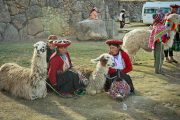
Pick from the hotel to transport terminal and then directly to Ollantaytambo. Perfect service
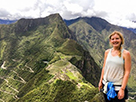
Transport from Cusco to Machu Picchu within our budget, and met nice people. Jose the driver is amazing.

Change location
- UK / International
- Call toll-free tomorrow from 9am EDT 617-223-4521 617-223-4920 or
- REQUEST A QUOTE
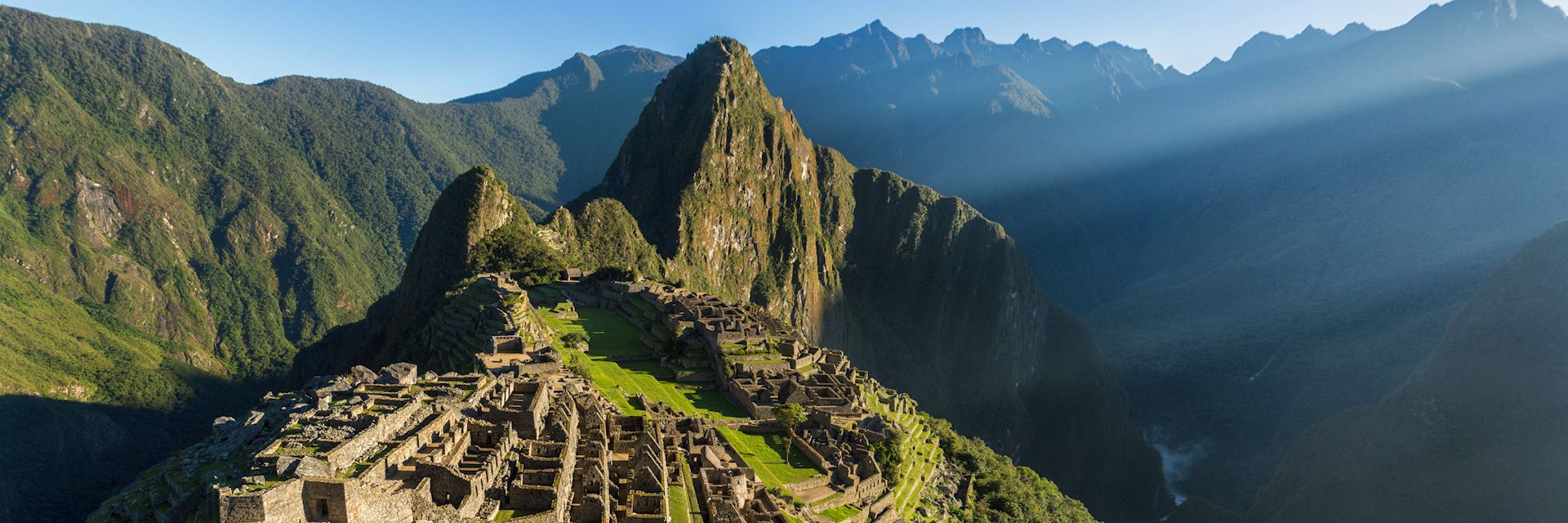
Visit Machu Picchu: A first timer's guide
- Machu Picchu
By Peru specialist Nik
Just shy of 600 years ago, a small plateau between two lushly forested peaks high in the Andes became a building site for the Inca Empire’s greatest city.
This citadel in the clouds was abandoned only 100 years later but Spanish invaders never found Machu Picchu. It was left to nature before explorer Hiram Bingham caught wind of it on an expedition in 1911 and decided to investigate. A hidden city protected by the mountains, and still wonderfully inaccessible other than by foot or train, Machu Picchu is now a New Seven Wonders of the World .
My Machu Picchu highlights
I’m often asked if Machu Picchu really lives up to its name. The emphatic answer is yes, and for two reasons.
Firstly, its buildings — the temples, palaces and houses — are in a remarkable preserved state. The Spanish never ventured up the mountains and so left it untouched.
Moreover, each time I visit Machu Picchu I’m bowled over by the setting. Out of view from the valley, you hear the roar and churn of the Urubamba River 500 m below. A protective wall of mountains surrounds you, which fades in and out of view as the mist falls and lifts. You have the distinct feeling of being high up in the world and part of a very well-kept secret.
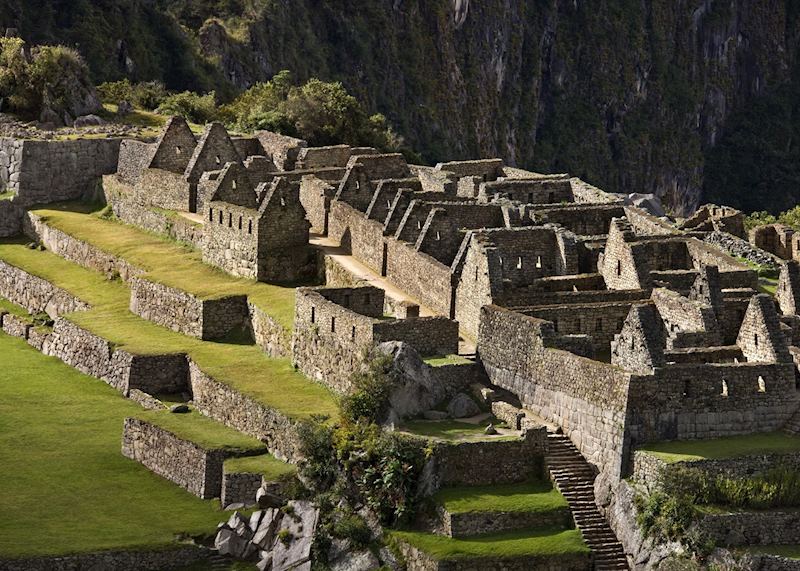
Three of my stand-out highlights
The intihuatana stone.
This carved pillar on a square stone base remains a testament to the Incas ’ knowledge and skill as astronomers. The name translates to the 'hitching post of the sun'. The corners point to the four cardinal points, and the stone still accurately indicates the positioning of the sun. If you happen to be watching at noon on either equinox, you’ll notice the stone’s shadow disappear for just a moment, as designed by its creators.
The Royal Tomb
This cave-like building is thought to be where sacrificial or burial rituals were performed, and there have been more than 100 skeletons excavated here. Just to the left of the tomb lies a series of ceremonial baths fed by a sophisticated aqueduct system — another reminder of the impressive masonry skill of the Incas.
Climb Huayna Picchu
You can climb Huayna Picchu, the witch’s hat of a mountain that stands guard behind Machu Picchu, as long as you book it well in advance as part of your admission ticket. Your ticket will show your allocated time slot to start the walk, and it takes about an hour to reach the top.
I wouldn’t recommend it if you don’t like heights — the last stretch of path narrows with no barrier to separate you from the edge. The reward comes from the view at the top, which our guides generally agree is the best place to see Machu Picchu from above. You could opt to climb part of the way to still get the knock-out view, albeit from a lower level.
Video: Our expert tips for visiting Machu Picchu

Machu Picchu: a first timer's guide
A first timer's guide to Machu Picchu.
Where to stay in Machu Picchu
I’d highly recommend an overnight stay at Machu Picchu or Aguas Calientes if you want to get up to experience the ruins early the next morning.
The Machu Picchu Sanctuary Lodge is the only hotel close to the entrance of Machu Picchu, a mere stroll away. Staying here ensures you’re best placed to avoid traveling time at the start and the end of the day, though this convenience comes at a considerable price tag.
Aguas Calientes has a good range of hotels. The buses start to roll out of town up to Machu Picchu early enough for you to arrive just after the gates open, and well ahead of visitors coming by train. Staying locally also is helpful if you want to visit the site more than once. Mist clinging to the peaks can be completely bewitching, but visibility can be changeable 2,450 m above sea level. A second visit can give you a completely different set of conditions to enjoy as you explore the architecture, and time to climb Huayna Picchu.
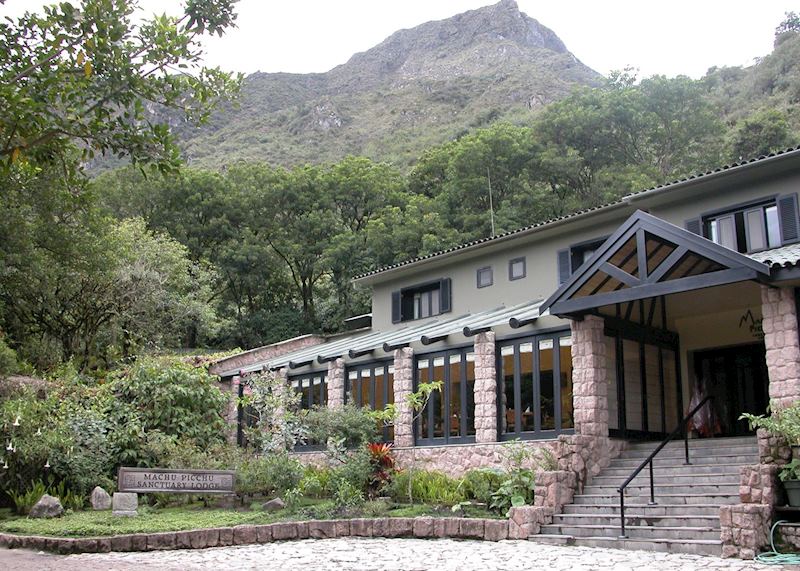
How to get to Machu Picchu
Your most common route to Machu Picchu is flying into Peru’s capital city, Lima , before transferring to an internal 1h 15m flight to Cuzco .
Cuzco sits at the base of the Andes in the southeast of Peru. It was the capital of the Incas and is the leaping-off point for Machu Picchu and the Sacred Valley , the one-time heartland of the Inca Empire. You can reach Machu Picchu from Cuzco on the train or by trekking.
A small town, Aguas Calientes, has sprung up in the valley below Machu Picchu. It serves as the disembarking point for the train or a gathering place after you’ve completed the Inca Trail and descended from Machu Picchu.
From as early as 5am buses leave here to travel up the windy road cut into the mountainside to the entry gates of Machu Picchu.
When is the best time of day to visit?
Machu Picchu is often busiest between 11am and 3pm when most train and bus visitors arrive, so the opportunity to see the site in the morning or at dusk could allow you to have a more meditative experience and better light for photography.
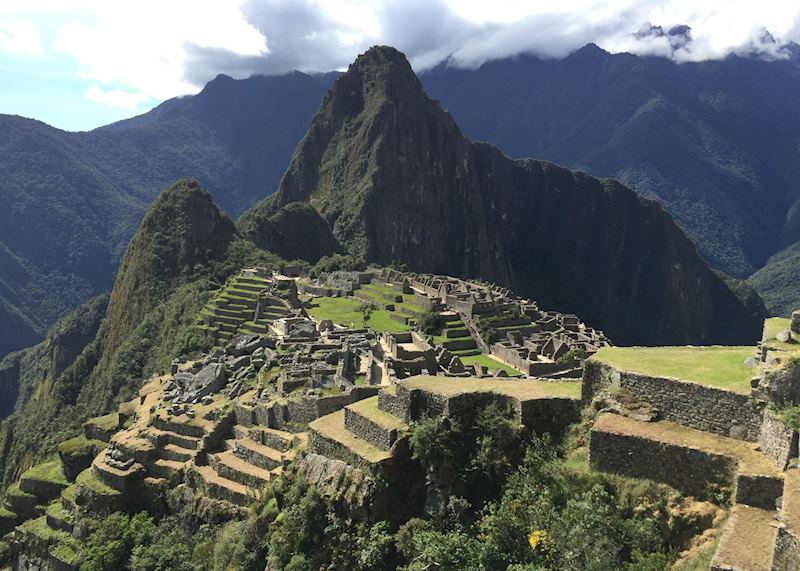
Machu Picchu by rail
The train journey from Cuzco to Aguas Calientes offers you the chance to see dramatic, natural scenery as you make your way through lush valleys and past rugged peaks, following the course of the Urubamba River.
There’s a variety of rail services, from regular carriages with comfortable seating, Vistadome services with panoramic windows through to the luxury Hiram Bingham train with fine dining and entertainment.
You can break up your journey mid-point by stopping or staying overnight at Ollantaytambo in the Sacred Valley, once an important administrative center for the Incas. The remnants of a sturdy fortress, complete with terraces, dominates the town. You would travel into the valley by road and then take the train from Ollantaytambo to Machu Picchu.
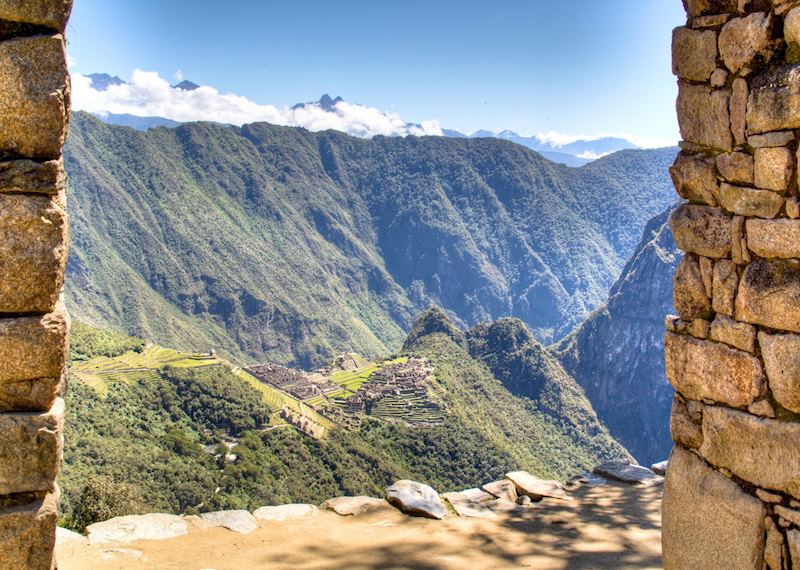
Machu Picchu by foot
Trekking vacations to Machu Picchu are ideal if you want to immerse yourself fully in the hugely varied landscape of snow-capped mountains, sapphire lakes, terraced fields and emerald-forested slopes.
Our guide on trekking vacations in Peru introduces a range of routes and distances so you can find a trip that’s tailored to your fitness level, the number of days you have available to explore and your preferred accommodation.
With group and private treks ranging from 1 to 12 days, you can cover the Inca Trail, Salkantay (known as the ‘alternative Inca Trail') or the Mountain Lodges of Peru route at a pace that suits you once you’ve had time to acclimatize to the altitude.
There are regulations restricting the number of walkers allowed on the Inca Trail. Only 500 people are allowed to start the Inca Trail trek to Machu Picchu each day, and this includes the porters. Permits sell out notoriously far in advance, so it’s essential to plan your trip as early as possible if you want to walk the Inca Trail.
A little note on altitude
Machu Picchu stands at around 2,450 m above sea level, and Cuzco at 3,400 m. At these heights, there’s 20 per cent less oxygen in the air. In the vast majority of cases, symptoms of altitude sickness are very mild (a little sleepiness or a slight fuggy head) and wear off after a day or two, but it can make doing anything energetic feel like a struggle.
Our Peru specialists can give you personalized recommendations about how to acclimatize ahead of your trek and combat any altitude sickness during it.
Travel insurance for Machu Picchu treks
It’s important to check whether your travel insurance will cover you for treks at altitude, especially if you’ve previously bought a policy to cover you for a number of trips throughout the year. It’s possible to buy specialist trekking travel insurance, and this tends to fall into pricing categories based on the altitude and length of the trek you wish to take on.
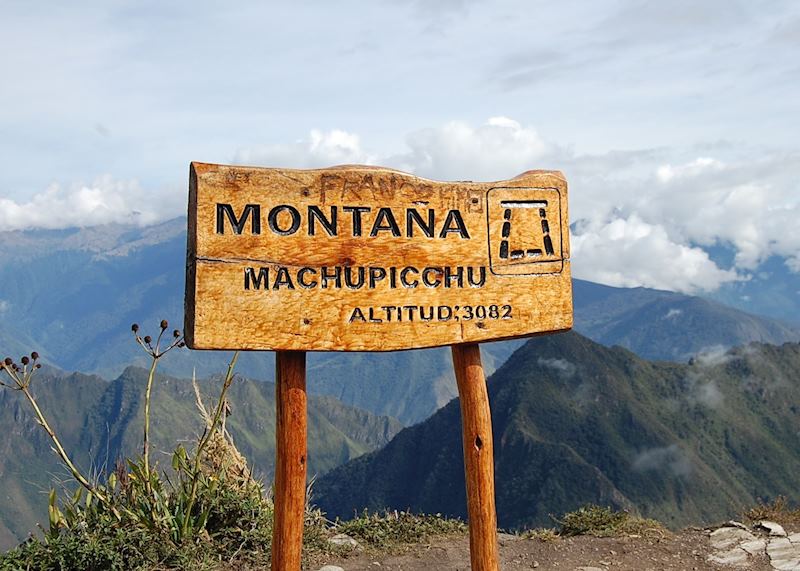
Where to eat at Machu Picchu
Aguas Calientes has a plentiful selection of restaurants to suit your tastes and wallet. One of our current favorites is Indio Feliz, an award-winning restaurant serving Peruvian dishes with a French twist tucked away in a side street.
You can also try Peruvian street food if you time it right. Every Sunday, slow cooked chicharrones (hog roast) is sold until it’s all gone. I tried it on a recent trip and the meat was amazingly succulent, with the best crackling I’ve ever tasted.
The best time to visit Machu Picchu
July and August is peak season, when the highest number of visitors are taking on the Inca Trail or wandering around Machu Picchu.
The Andean foothills are at their driest at this time of year too, with the rainy season taking place between November and March.
We favor visiting throughout the dry months of April to October, but it’s worth avoiding the July and August peak period if you’re not tied to traveling at this time.
It should be noted that the Inca Trail is closed to walkers during the month of February so restoration work can take place.
Trips to Machu Picchu
We’ve created a selection of itineraries that visit Machu Picchu as well as some of Peru's other highlights.
I’d suggest you need at least 9 days in Peru to take in Machu Picchu and the surrounding Incan ruins, with time to explore Cuzco before or after.
With a little extra traveling time you can extend your journey to cover time in the Peruvian Amazon , Lake Titicaca or the Colca Valley.
Tailor-make your trip to Peru
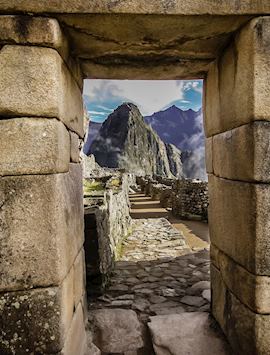
Discover Machu Picchu
8 days from $7,500pp

Luxury Peru tour
13 days from $12,750pp

Icons of South America: Cuzco, Machu Picchu, Iguaçu Falls & Rio
11 days from $13,450pp
Start thinking about your experience. These itineraries are simply suggestions for how you could enjoy some of the same experiences as our specialists. They’re just for inspiration, because your trip will be created around your particular tastes.
Further reading
- Trekking to and around Machu Picchu
- Peru’s Inca wonders beyond Machu Picchu
- Machu Picchu plus one: tried-and-tested South American combinations
- Video: Helen's travels in Peru
- Trekking vacations in Peru: the best hikes (that aren’t the Inca Trail)
Plan your trip
Tell us about your plans and one of our specialists will plan a unique trip for you...
Request our brochure, The World Your Way

Order your digital copy via email.
Machu Picchu: get to know Peru's icon of Inca civilization

Sep 16, 2020 • 6 min read
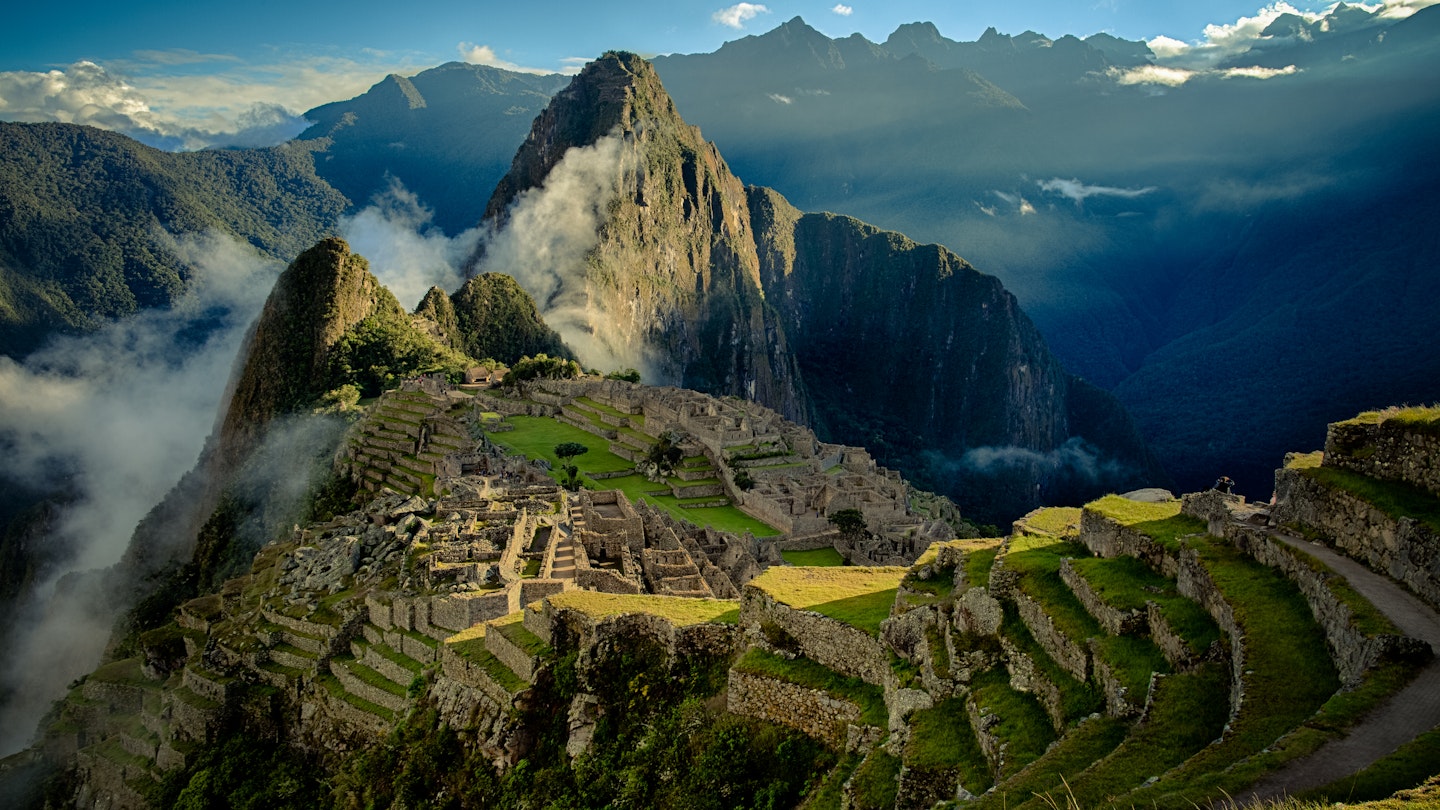
Machu Picchu is more than just a pretty picture © Bérenger Zyla / 500px Images
In the past decade, Peru has remained on the radar of adventurous and mindful travelers thanks to the Latin American country’s incredibly diverse ecosystems, terrain and cultures – not to mention award-winning restaurants and a mouthwatering street food scene – that supply endless explorations.
To top it off, there’s that ancient mountain, Machu Picchu , in the Sacred Valley, once the heart of the Inca Empire, that never seems to go out of style. Located at an altitude of nearly 8000 ft (some 2430m) above sea level, at the nexus of the Peruvian Andes and the Amazon Basin, Machu Picchu has only continued to gain international interest since its rediscovery in 1911. In fact, it is one of the most sought-after archaeological sites in all of South America .
Understanding the appeal and majestic quality of the high-altitude site however requires more than swiping through Instagrammable images: we must first uncover the meaning, history and importance of Machu Picchu.
Editor's note: check local travel restrictions before booking any trip and always follow government health advice.


What is Machu Picchu?
Meaning "ancient mountain" in Quechua, one of Peru’s many indigenous languages, Machu Picchu transformed from a simple summit to a sacred site during the rule of the Inca Empire in the mid 15th century. Located about 45 miles (75km) northwest of Cuzco city , the trek to Machu Picchu is a big draw for travelers, though it was this countryside setting that allowed the Incas to hide from potential invaders.
Thousands of steps – some of which were cut into over 100 staggered terraces – lead up to an expansive stone citadel complete with plazas, ritualistic and sacrificial areas, and an elaborate irrigation system. There were also living quarters for Inca royalty and a fleet of guardsmen, servants and about a thousand people more. While it is uncertain if Machu Picchu served as a seasonal retreat or long-term residency for the Inca elite, the site managed to incorporate all of the ancient culture’s core elements: agriculture, astronomy, spirituality and a harmonic society.

Though restoration has been an ongoing task for the past half a century, it is undeniably impressive that any of the structures have remained after a lifetime of heavy rains and frequent earthquakes – not to mention, the footsteps of thousands of daily tourists. Such a feat is owed to the ingenious Inca engineers and architects who not only insisted in building a sturdy underground foundation and tiered cropland to prevent landslides, but had also directed stonemasons to carve and smooth massive granite stone in such a precise manner that they could be pieced together without the use of mortar or any sort of melding agent.
Incredibly advanced and organized, the Inca civilization continues to be a topic of marvel for modern archaeologists and history buffs – and Machu Picchu, specifically, has been a revealing portal to help us understand the ancient culture and history of Peru.
History of Machu Picchu
An icon of Inca civilization, Machu Picchu in its prime was truly fit for a king – or, more accurately, an emperor. While there remains some speculation, it is commonly believed the citadel was built for Inca Pachacuti (also referred to as Pachacutec) who ruled from 1438 until his death in the early 1470s. The ninth Inca ruler, Pachacuti would begin an era of conquest that marked the development of the Inca Empire (or Tawantinsuyu), the largest empire in pre-Columbian America.
Archaeologists estimate that the construction of the mystical mountain city began around 1450 and took decades to complete. Not even a century after the first stone wall had been erected, however, Spanish conquerors began to gain ground in what is today considered the Cuzco region. Remote and off the radar, the tropical mountain top was safe from unknowing Spanish intruders yet was nonetheless abandoned by its people who sought safer ground.
Would Machu Picchu then be completely forgotten? Not necessarily. In 1911, American explorer Hiram Bingham arrived in the Sacred Valley and was guided along the Urubamba River and up the now famous mountainside to the citadel (which he mistook for Vilcabamba ) by a duo of local peasant farmers. Though quite overgrown with dense jungle, Machu Picchu had not been a secret to locals – it was, however, a delightful surprise for curious internationals who, having read of Bingham’s so-called discovery in his 1913 book, would begin a longstanding wanderlust tradition of dreaming of Peru.
In the past half a century of its modern history, Machu Picchu has garnered titles such as Peruvian Historical Sanctuary (since 1981), Unesco World Heritage Site (1983), and one of the New Seven Wonders of the World (2007).
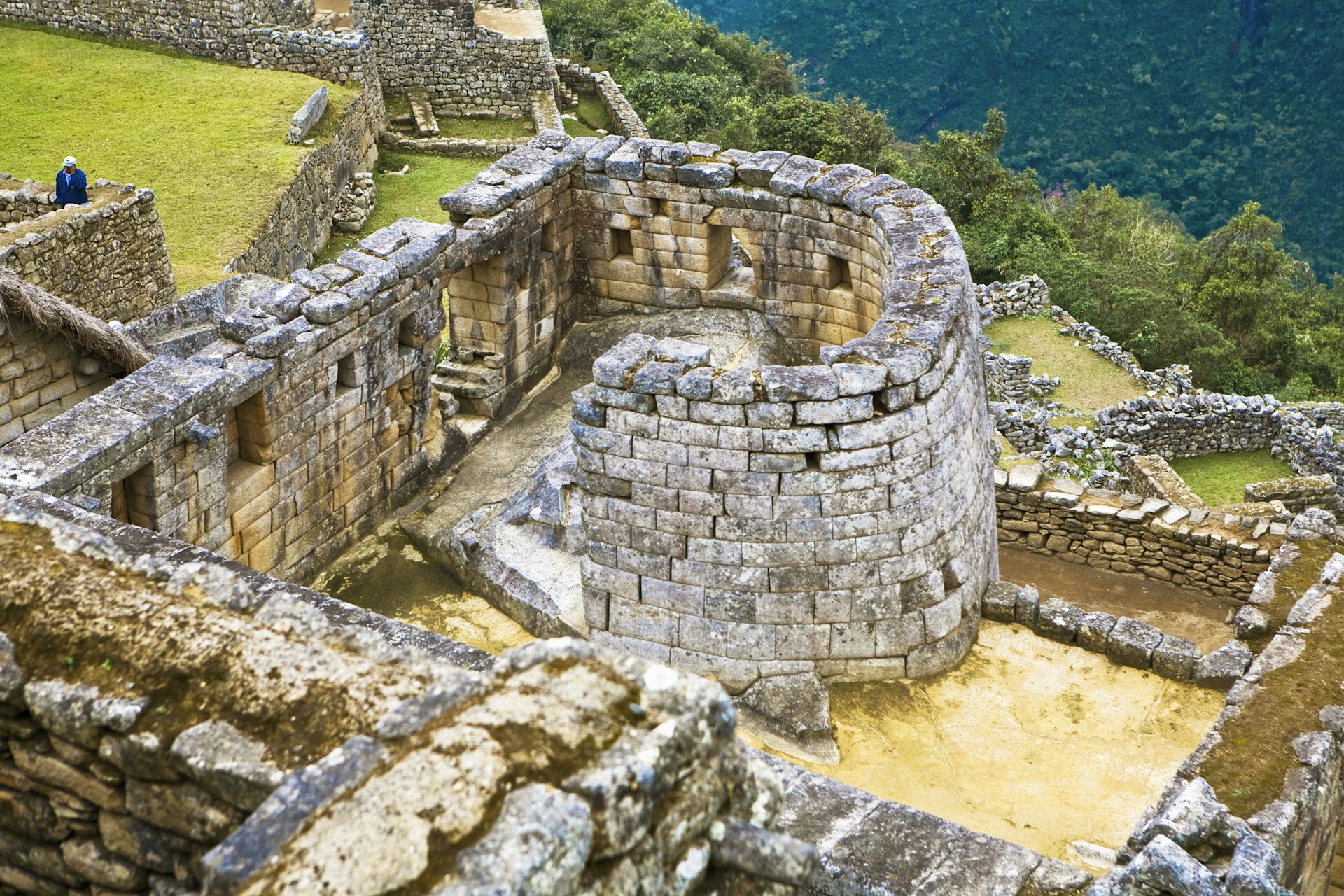
Special features of Machu Picchu
● Temple of the Sun The curved wall of this temple’s tower was built upon and integrates a large ceremonial stone that rests at the base, forming a cave-like area. This temple was used to honor Inti, god of the Sun, and light pours in through the eastern-facing windows during both winter and summer solstice. It is one of many great examples of the Inca dominance in astrology, religion and design.

● Inti Watana Also spelled "Intihuatana", the Quechua name of this peculiar-shaped ritual stone means “hitching post of the sun” and is set in what has been designated as the "Urban Sector" of the citadel. Likely used as a sundial or astronomic calendar, the 2-m-high slab is marked by a protruding tab pointing to the magnetic north. With this tool, the Incas would have been able to track the movement of the sun and the seasons. For example, the longest shadow appears during winter solstice (June 21, in the southern hemisphere), allowing them to project agricultural and ritualistic activities.
● Museo de Sitio Manuel Chávez Ballón This museum may be small but it’s not to be missed, even though many visitors are unaware of its existence. A 20-minute walk from Aguas Calientes , the small town at the base of Machu Picchu, it has a dynamic display to better understand the building methods used by the Incas and the excavations that took place centuries later. Afterwards, stroll through the museum’s Botanical Garden.
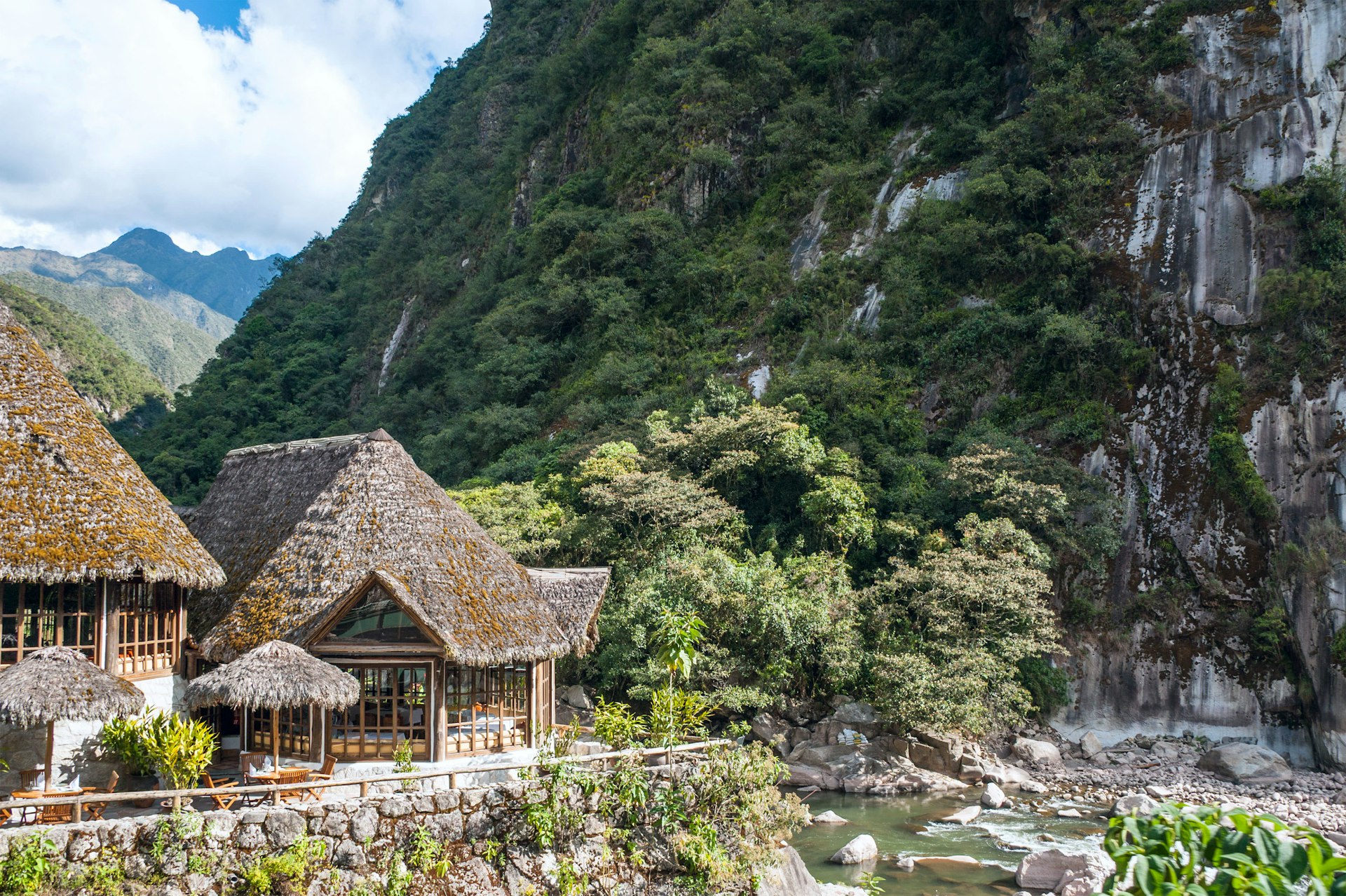
● Huayna Picchu While its name is lesser known by international standards, Huayna Picchu is commonly mistaken in photos for its more famous sister peak (it is the one towering over the leveled areas filled with stone ruins). Though a steeper and riskier hike, the physically fit should not skip the opportunity to trek a bit further and catch an incredible view of Machu Picchu and the entire land of the Incas from the top of Huayna Picchu.
Planning your trip to Machu Picchu
Machu Picchu is currently closed due to COVID-19 restrictions . While the reopening date has yet to be confirmed, new protocols will be put in place to ensure the safety of travelers as well as the conservation of the historical site. The new social distancing rules – smaller tour groups, fewer visitors allotted per hour, trains and buses at 50% capacity – mean the typically crowded site will provide travelers with a greater opportunity to connect to the natural and spiritual world that surrounds, just as the Incas would have wanted.
You might also like:
Responsible trekking in Peru: what you should know about workers' rights for porters Peru's top 10 adventures Offbeat adventures in Cuzco and Peru's Sacred Valley
Explore related stories

Art and Culture
Jan 2, 2024 • 7 min read
Visit these shows at museums around the country to get fresh takes on old masters, see exciting new work, learn about history and more.
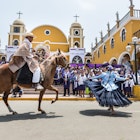
Nov 15, 2023 • 4 min read
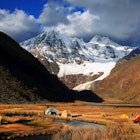
Nov 10, 2023 • 9 min read

Nov 8, 2023 • 6 min read
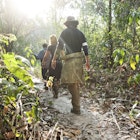
Nov 6, 2023 • 5 min read
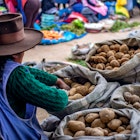
Sep 1, 2023 • 6 min read
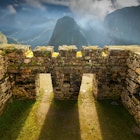
Sep 1, 2023 • 7 min read

Aug 30, 2023 • 4 min read
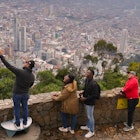
Aug 17, 2023 • 11 min read

Aug 11, 2023 • 8 min read

How to Experience Machu Picchu
Traveling to peru’s famed inca citadel is an epic trip worth taking at least once in your life. here’s how to make the most of it, whether you’re hiking or arriving in style on a luxury train..
- Copy Link copied

Machu Picchu can only be accessed now via timed entry tickets purchased in advance.
Photo by Lyndsey Matthews
One of the New Seven Wonders of the World and a UNESCO World Heritage site, Machu Picchu is practically synonymous with Peru. Built during the 15th century, this Inca citadel was abandoned sometime after the Spanish invasion and remained unexplored until 1911 when American scholar Hiram Bingham III and a team of Peruvian explorers stumbled upon it in the cloud forest about 50 miles northwest of Cusco. Why it was built and why it was abandoned are still mysteries. Here’s what you need to know for your visit, including when to go, where to stay, and how to get there.
Best time to visit Machu Picchu
High season for Machu Picchu is its dry winter months from June to August. Since hotels in Aguas Calientes—the town at the base of Machu Picchu—book up months in advance and a limited number of tickets are available to enter the archeological site each day, it’s smart to consider the shoulder season months of April, May, September, and October when there are fewer crowds and temperatures average in the 60s Fahrenheit.
Low season coincides with Machu Picchu’s rainy summer season, which runs from November to March each year. Though the archeological site remains open year round, if you’re planning a hiking trip, keep in mind the entire Inca Trail is closed each February due to harsh weather, safety issues, and planned annual maintenance work.

Rainy season is no joke at Machu Picchu—plan accordingly.
Photo by Stock for you/Shutterstock
Getting acclimated to Machu Picchu’s elevation
Machu Picchu is located at 7,972 feet above sea level and Cusco is located even higher (just over 11,000 feet). To avoid the effects of altitude sickness, which can include nausea and bad headaches, follow these tips:
- Consider flying into Cusco and heading straight to Aguas Calientes, since it’s located around 6,700 feet, for a night or two to adjust to the high altitutde before visiting Machu Picchu.
- Stay as hydrated as possible.
- Avoid alcohol and heavy exercise the first few days.
How to get from Cusco to Machu Picchu
Though Machu Picchu is only 50 miles from Cusco, there’s no direct road between the two locations. The easiest way to get from Cusco to Machu Picchu is by taking a train from the San Pedro, Wánchaq, or Poroy stations in Cusco to the Machu Picchu Pueblo Station in Aguas Calientes. It takes just under four hours.
The main operators are PeruRail and Inka Rail , which offer a variety of luxury and budget options. For example, PeruRail operates the luxury Hiram Bingham, a Belmond Train every Tuesday, Wednesday, Thursday, Saturday, and Sunday between the Poroy Station in Cusco, Ollantaytambo Station, and Machu Picchu Pueblo Station. Expect 1920s Pullman carriages with wood details and polished brass, an observatory car, plus live music and pisco sours in the bar car. Prices are steep—starting around $1,000 for a round-trip ticket—but include the entrance ticket to Machu Picchu (with a guide), lunch and dinner on the train, and more.
If you choose to explore the Sacred Valley before heading to Machu Picchu, it’s possible to get a train from Ollantaytambo (a small town with original houses, streets, and waterways preserved from Incan times) to Aguas Calientes, which takes about two hours. (Many trains from Cusco offer bimodal options, as well, which include a bus from Cusco to Ollantaytambo and the train from there to Aguas Calientes.)
From Aguas Calientes, Machu Picchu is a 30-minute bus-ride up the hill. Tickets cost $15 round-trip for adults online , but many tour operators include the price of the bus ticket and entrance to Machu Picchu in their package. (It’s also possible to hike up to Machu Picchu from Aguas Calientes and back down, but it’s very steep and takes 90 minutes each way.)

Located in Peru’s Sacred Valley, Ollantaytambo is the starting point for most Inca Trail hikes and has ruins of its own worth visiting.
How to hike to Machu Picchu
For an extra challenge, active travelers can also hike to Machu Picchu on a multi-day trek or a shorter day hike. (Whichever route you take, be sure to take a few days to acclimate to the elevation before setting out.)
The most famous trek is the Inca Trail , a centuries-old route that leads from the Sacred Valley up into the Andes Mountains to elevations over 13,000 feet. A permit and an official guide are required to hike the trail, so it’s easiest to book both through a tour operator. The most classic route is a four-day/three-night trek that departs from Ollantaytambo and includes porters to carry packs and set up camp, as well as cooks who prepare three meals a day.
The Peruvian government limits Inca Trail access to 500 people per day, including porters. This regulation protects the local ecosystem and the delicate ruins, and it ensures that the trail won’t be too crowded. However, if permits for the peak summer season sell out, never fear: Various other trails lead to Machu Picchu. Here are some recommendations for classic Inca Trail trips to book, plus a few lesser-known treks that also include visits to Machu Picchu.

The classic Inca Trail route takes four days and three nights to reach Machu Picchu.
Luxury Inca Trail with Alpaca Expeditions
Book now: from $2,695, alpacaexpeditions.com
Alpaca Expeditions is a 100 percent Peruvian Indigenous-owned company. It offers a classic four-day/three-night trek on the Inca Trail to Machu Picchu starting at $750 per person, but the luxury version of this trip includes, among other things, upgraded tents with air mattresses and camping cots outfitted with feather duvets and cotton sheets (no BYO sleeping bag here).
Alpaca Expeditions will arrange for transport from Cusco, Urubamba, or Ollantaytambo to the Km 82 trailhead on the first day. For the return trip to Cusco, it also includes tickets on the luxury Hiram Bingham, a Belmond Train, from Aguas Calientes.
Peru Inca Trail Trekking Tour with Mountain Travel Sobek
Book now: from $3,795, mtsobek.com
Before setting off on a four-day, three-night trek on the Inca Trail, MT Sobek’s tour begins with two nights in the Sacred Valley at the new Las Qolqas eco-resort, set in a beautiful garden complex just outside the town of Ollantaytambo. Once travelers are acclimatized to the elevation, they’ll cross the Urubamba River to begin the Inca Trail hike starting at Km 88 instead of the Km 82, where most groups begin, for a more isolated experience. After three nights of tent camping, the trip culminates with sunrise views of Machu Picchu, plus another full day at the archaeological site before returning to Cusco.
Day Hike on the Inca Trail with Modern Adventure
Book now: from $8,000, modernadventure.com
For less ambitious hikers, Modern Adventure’s food-focused tours of Peru offer an optional day hike on a 6.8-mile portion of the Inca Trail as part of its larger seven-day trip. After taking the train from Ollantaytambo part of the way to Aguas Calientes in the morning, hikers disembark along the Urubamba River and start their journey up into the Andes past archaeological sites like Chachabamba and Winaywayna before descending to Machu Picchu through the Sun Gate in the late afternoon. Guests who opt out of the hike will take the train directly to Aguas Calientes and visit Machu Picchu the following day.
>> Read more: What It’s Like to Go on a Modern Adventure Tour of Machu Picchu

The sights along the Salkantay Trek rival the views at Machu Picchu, dare we say.
Photo by Andrew Clifforth/Shutterstock
The Salkantay Trek to Machu Picchu with Mountain Lodges of Peru
Book now: from $3,300, mountainlodgesofperu.com
Though the 50-mile Salkantay Trek is considered to be a more challenging alternative to the Inca Trail, it’s a little easier to take on knowing that each day of luxury outfitter Mountain Lodges of Peru (MLP)’s seven-day lodge-to-lodge trip culminates with a night at its proprietary hotels—the Salkantay Lodge, Wayra Lodge, Colpa Lodge, and Lucma Lodge. After days of exploring archaeological sites like Quillarumiyoc and crossing the Salkantay Pass (15,213 feet elevation), travelers get to enjoy a gourmet dinner, a soak in a Jacuzzi, and possibly spa treatments, too. The final day of the trek includes a morning at Machu Picchu before heading back to Cusco in the afternoon.
The Vilcabamba Trail with Kandoo Adventures
Book now: from $1,685, kandooadventures.com
When Hiram Bingham and a team of Peruvian explorers stumbled upon Machu Picchu, they were actually looking for the city of Vilcabamba. With Kandoo Adventures, hikers will spend two days in Cusco to acclimate, then head out on a five-day trek into the Sacred Valley. One of the most scenic and remote routes, the Vilcabamba Trail follows the Cordillera de Vilcabamba and promises solitude and a serious workout before ending with a visit to Machu Picchu on the last day.
The Huchuy Qosqo Trek with Llama Path
Book now: from $599, llamapath.com
The first two days of this three-day trek that begins in Cusco are dedicated to visiting the historic Inca site of Huchuy Qosco and to getting to know the history and some of the people who live in the area. The last night is spent in the town of Aguas Calientes before the Llama Path team takes you up to Machu Picchu.
Of course, plenty of tours to Machu Picchu don’t require multi-day hikes. Though tour operators like G Adventures and Intrepid both offer Inca Trail treks, travelers can also book trips through them that skip the trails and include a visit to Machu Picchu by the train and bus combo described earlier.

Llamas are allowed to roam freely around Machu Picchu, but humans aren’t, so it’s important to obey the rules.
Machu Picchu tickets (and other tips for visiting the site)
Machu Picchu is open every day from 6 a.m. to 5:30 p.m., and tickets for international adults start at 152 Peruvian soles (about US$42). Most treks and tours include entrance tickets to Machu Picchu itself in their cost. If you’re traveling independently from a group tour, keep in mind that advance timed entry tickets are required and you must hire a certified guide. (Guides are available at the entrance.) Also, don’t forget your passport, which you’ll need to verify the name on your ticket.
In addition to establishing five one-way circuits to help with crowd control, Machu Picchu has added strict limits to the number of visitors it allows each day. (You’ll want to choose circuit one or circuit two if you want to snap that classic postcard view of Machu Picchu.) Currently, just under 3,000 tickets are available for the main citadel each day, so be sure to purchase your ticket as early as possible. There’s even less availability if you want to hike Huayna Picchu, the peak in that signature view of Machu Picchu. (Only 200 people are allowed to hike each day.)
The best time of day to visit Machu Picchu: Arrive the night before to Aguas Calientes, and get on the first bus that leaves at 5:30 a.m. so you can be one of the first people on site. Similarly, if you visit in the late afternoon before it closes, you’ll encounter fewer crowds.
What to wear (and what to leave at home): The sun is also very strong at altitude, so hats and sunscreen are a must. But no matter how sunny it is, it’s also smart to bring a rain jacket in case of rogue showers since umbrellas aren’t allowed into the site.
Rules to follow: After a German tourist fell to his death in 2016 , the park now forbids jumping photos and strictly enforces it. Other big no-nos include eating in nondesignated food areas, sitting on the sacred ruins, and touching their stone surfaces.
Where to stay near Machu Picchu
The Sanctuary Lodge, a Belmond Hotel , is located right at the gate to Machu Picchu, allowing the best access to the site. The 31 rooms and suites come with comfy beds and marble bathrooms, and some have terraces and mountain views. There’s not much to do other than eat and drink at the hotel itself—unless you want to take the 30-minute bus ride down to Aguas Calientes—but after a long train ride or hike, relaxation might be all that’s on your mind before an early bedtime.
For those planning on staying more than one night, it’s best to book in Aguas Calientes for easy access to the markets and restaurants located there. One of the best—and most beautiful—options in town is the Inkaterra Machu Picchu Pueblo Hotel . It has 83 rustic adobe casitas set among 12 acres within a cloud forest next to the Urubamba River that’s home to 214 bird species and even more varieties of native orchids.


- Meet the Team
- Work With Us
- Itineraries
- Italy Travel Guide
- Hawaii Travel Guide
- Travel Tips
Attractions
How to plan a trip to machu picchu for first timers.
Visiting Machu Picchu, the ancient Inca city, high up in the Andes of Peru , has always been at the very top of my travel list. Who wouldn’t want to experience the almost mystical “Lost City of the Incas”, situated so high up in the jagged Andes Mountains that it’s unimaginable how it was even built, much less how they survived, and thrived, in such an isolated environment.
It holds the same mysterious appeal as far off ancient civilizations like Egypt and Jerusalem. Machu Picchu is, of course, a UNESCO World Heritage site . A trip to Machu Picchu is much more than just a vacation. It’s a journey. There are many ways that this will be one of the most exciting and fulfilling journeys you’ll ever embark upon.

That’s why we’ve put together these tips for visiting Machu Picchu. You’ll likely fly into Lima from the U.S. and have an overnight stay in the capital city of Lima before going onward to Cuzcu. The stopover is a blessing, because once you reach Cuzco, you’ll need time to acclimate to the altitude, and this task is harder while also dealing with jetlag.
Don’t go in thinking that the journey to Machu Picchu will be an easy one. It can be a very tiring and long journey, all told, with flights, train, bus and walking distance. But don’t be discouraged, because the end goal is well worth it.
Also be aware that the Machu Picchu park administration has made significant changes to the way they deal with tickets and visitors in 2023 moving forward for the preservation and conservation of this UNESCO World Heritage Site. If you’ve been before, things are different now. We’ll explain the changes below.
» Start planning a trip today with this Perfect 10-Day Peru Itinerary: What to See & Do.
Planning your trip to Machu Picchu?
- Rent a car from Cuzco through Discover Cars .
Where to Stay in Machu Picchu:
- Belmond Sanctuary Lodge – The only hotel located right next to Machu Picchu. A great experience! Read more about it in this review .
- Sumaq Machu Picchu – Located on the river at the base of Machu Picchu. Great location, great experience.
Best Tours and Experiences in Machu Picchu
- Machu Picchu All-Inclusive Day Trip – Includes train, entrance tickets, guide, shuttle bus & private transport.
- Visit Machu Picchu and Machu Picchu Mountain in 2 Days – Discover the history, culture, and energy of the area with roundtrip transfers.
» If you’re planning to see other parts of the country, be sure to check out this backpacking travel guide to Peru for tips and inspiration.
Table of Contents
Changes to Tourist Policy
Machu Picchu has new visiting rules starting in 2023 , including the following:
- The introduction of 5 different circuits to visit the Inca site.
- There are only 4,500 tickets available per day for Machu Picchu.
- All tourists must be led by a tour guide in order to preserve the site.
- Tourist groups can have a maximum of 10 people per guide.
- Reentry to the site is prohibited.
- The guided tour duration is 2 hours in order to free up room for more groups.

Getting Tickets to Machu Picchu
Pro Tip: No tickets are sold at the entrance, so you must secure them in advance. If you’re traveling during high season, I would purchase tickets a month or more in advance, to avoid disappointment.
The easiest possible way to see Machu Picchu is to book a tour from Cuzco. I recommend this tour by ExploorPeru that includes train, entrance tickets, guide, shuttle bus & private transport. You can go from Cuzco all in one day, or go to Agua Calientes to stay the night before, so it’s very flexible.
If you’d rather plan it all yourself, you can buy tickets online through the official government website or authorized agencies. As of 2023, tickets cost 152 soles ($40USD) for adults and 70 soles ($19USD) for children under 18. You’ll be charged a %5 fee to book online.
If you’re looking to hike up Huayna Picchu or Machu Picchu Mountain (Montana), you’ll need a special combination ticket that’s 200 soles for adults (includes Machu Picchu ticket). The Montana ticket allows re-entry to the main citadel, while the Huayna Picchu one doesn’t. If you want tickets for the Huayna Picchu mountain climb, try to buy them at least 3 months in advance because tickets are limited to 200 per day.
Machu Picchu Circuits
The Machu Picchu authorities have implemented specific circuits (or routes) for visitors to follow, aimed at safeguarding the archaeological site for years to come. The path you’ll take depends on the type of ticket you purchase.
Options include a standard Machu Picchu ticket, as well as combo tickets that add on attractions like Huchuy Picchu or the Inca Bridge (same cost), Huayna Picchu Machu or Picchu Mountain (for an extra cost) .
Which Circuit is Best for First-Time Visitors?
We recommendation getting a ‘Machu Picchu only’ ticket and following Circuit 2. This route allows you to tour the upper and lower parts of the archaeological site and includes the main parts of the Inca citadel. It takes about 2 hours and 30 minutes. If this is a return trip, consider doing the ‘Machupicchu with Huayna Picchu’ ticket and taking Circuit 4. If you choose the Huayna Picchu tickets, you can only do Circuit 4.
Here is a really extensive guide on all the circuits if you’re not sure which one to choose.
The Machu Picchu Experience – Start to Finish
Starting out in cuzco.

Cuzco, a UNESCO World Heritage site, is a city located at just over 11,000 ft above sea level in the Peruvian Andes — once the capital of the Inca Empire. It is the main launching point for visits to Machu Picchu. And it’s an authentic and vibrant city.
There is plenty to do in Cuzco, including hiking and adventure tours to nearby archeological ruins, such as the Sacred Valley of the Incas , and the Ollantaytambo ruins you’ll find in the valley, learning about the culture and customs of the Incas, shopping and exploring the ancient city, and dining on new and exciting local cuisine.
» Try this tour: If you’re interested in spending more time in Cuzco and the surrounding area, book one of these tours with ExploorPeru.
- The Best of Cusco in 3 Days : Sacred Valley, Machu Picchu, and Rainbow Valley (from $459/pp)
- The Best of Cusco in 4 Days : Adds on Humantay Lake (from $839/pp)
- The Best of Cusco in 5 Days : Adds on Cusco City (from $879/pp)
» Read more about Cuzco .

Once you land in Cuzco, catch a bus or taxi to the town center and find your accommodations, you’ll want to settle into a routine and get as much rest as possible in order to acclimate to the elevation.
If you’re planning to hike the Inca trail to Machu Picchu, you’ll need to arrive a few days in advance to prepare yourself. The elevation is no joke and symptoms can sneak up on you, so get plenty of rest and drink lots of water and the local remedy, Coca tea.
You can also get altitude sickness pills from your doctor before leaving home or from a local pharmacy, which will help. Really, the best way to acclimate is to slow down. Take it easy and build in time to relax.
» Read about what to eat while you’re in Peru, land of delicious food!
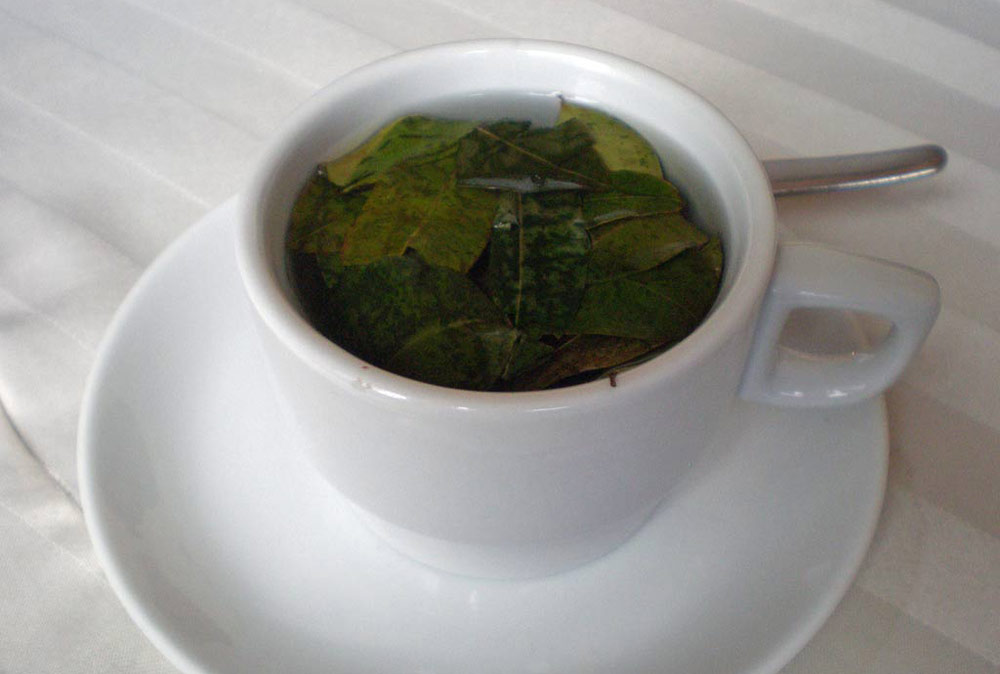
Getting to Machu Picchu from Cuzco
There are several ways to get to Machu Picchu from Cuzco.
- You can book this tour that arranges all the transportation for you (easiest possible way!).
- You can hike the Inca trail, following the route the Incas themselves took to reach the capital city. If you choose to hike, the trail is 26 miles long and trips range in length from one to four days, depending on what side trips are included. Only 200 visitors are allowed passes each day, so plan ahead, and be aware that this is a strenuous hike through a very mountainous region.
- You can buy your own tickets and take the train.

The train is perhaps the easiest way of getting there. When I went, knowing that I didn’t need to spend an enormous amount of time exploring, I chose the day trip option. The train leaves San Pedro station at 6:40am and takes about 4 hours to lumber up the mountain arriving at 10:52am in Aguas Calientes, the town at the base of Machu Picchu, where you’ll catch the bus.
You’ll arrive around 11am at Machu Picchu and have the entire day to explore before returning on the train to Cuzco in the late afternoon. If you’re the type who likes to explore every nook and cranny, you may want to arrive in Aguas Calientes the night before and stay the night to get an early start up to the ruins, which open at 6am.
Another option is from Poroy station, which is a bit further north, which leaves at 6:40am and arrives at 9:54am. The ExploorPeru tour we recommend leaves from this station (saving you an hour on the train!)
Just be sure to plan ahead if you’re visiting in high season, as tickets are limited and you wouldn’t want to be disappointed after having traveled so far. Here’s where to book the train tickets.

Arriving in Aguas Calientes
Once you’ve arrived in Aguas Calientes, the journey up to Machu Picchu begins. You’ll need to catch a bus up to the top, which involves a whole lot of switchbacks and may not be pleasant for anyone who gets car sick. Another option is to walk up, but that is reserved for only the most fit, and it will take about an hour, while the bus takes only 20 minutes.
In high season (July & August), pre-book your bus trip , or risk waiting in an atrocious line (like 2-3 hours long) or being turned away altogether. Once you’ve reached the top, you can embark on a tour of the ancient city.

» Read more: “ That Time We Had Machu Picchu (Almost) To Ourselves ” by Television of Nomads
Book a Tour
What to see in machu picchu.
NOTE: Be aware that there are no toilets in the historic area, so you should go before you enter (there’s one at the gate). If you have to leave to use the bathroom, you will not be able to get back in!
Machu Picchu Sanctuary is the designated area surrounding the famous Inca citadel of Machu Picchu in Peru. Nestled among the peaks of the Andes, this sanctuary serves as both a historical and a natural reserve, covering approximately 32,592 hectares.
It’s not just the stone structures that captivate visitors; the surrounding cloud forest is a biological paradise, hosting a variety of flora and fauna that contribute to the area’s unique biodiversity.

Though the main attraction is, of course, the ancient citadel itself, the surrounding area has a ton to explore. With the new circuits, you will be limited in what you can see based on which circuit you’ve chosen.
- Circuit 1 allows you to visit the upper and lower parts of the archaeological site. This tour goes through the main buildings as well as the area of the terraces, plus the higher up terraces where you can get an iconic photo.
- Circuit 2 includes the main buildings on the citadel, plus the upper and lower parts of the archaeological site.
- Circuit 3 allows you to visit the lower main plaza of Machu Picchu, plus a visit to the Inka House, the Temple of the Sun, the Water Mirrors and the agricultural area.
- Circuit 4 includes the lower main plaza of Machu Picchu, plus a visit to the Inka House, the Temple of the Sun, the Water Mirrors, the agricultural area, and the Sacred Rock.
Main Attractions
- The Temple of the Sun : One of the most important structures, this rounded building served astronomical and religious purposes. You’ll notice its intricate stonework, as well as windows perfectly aligned with the solstices.
- Intihuatana Stone : Also known as the “Hitching Post of the Sun,” this carved rock was used for astronomical observations. It’s situated on a small hill and offers a panoramic view of the entire complex.
- Room of the Three Windows : This structure, part of the Sacred Plaza, showcases the Inca’s mastery of masonry with its trapezoidal windows and massive stones.
- The Main Plaza : This central courtyard is surrounded by temples, residences, and storehouses. It was likely a social or ceremonial gathering place and offers some of the best photo ops.
- Temple of the Condor : This fascinating temple is designed to represent a condor, a sacred bird in Inca culture. The stone “wings” and “head” are immediately recognizable, making it a must-see.
- Agricultural Terraces : These are not just for show. The terraces were a functional part of Inca agriculture but now add to the breathtaking visual geometry of the site.
- The Watchman’s Hut : Right after you enter, you’ll find this small structure offering a classic, postcard-worthy view of the whole Machu Picchu complex. Most people stop here first for that iconic photo.
- Royal Tomb : Located near the Temple of the Sun, this area features a series of caves that were likely used for mummification or other ceremonial practices.
- House of the High Priest : This is a two-story building that might have been the residence for the spiritual leader or high priest of Machu Picchu.
- Temple of the Three Doors : Another part of the Sacred Plaza, this temple features a three-door entrance and showcases fine Inca craftsmanship.
Just remember, Machu Picchu isn’t just about ticking off the major sights; it’s about taking in the atmosphere and pondering the mysteries.
Where to Stay in Cusco
Cuzco welcomes many visitors every year, so they know how to do it right. You have a tremendous amount of choices for where to stay in this lovely city, including some pretty nice hostels. However, our days of hosteling are over, so we’re looking for an affordable luxury stay in Cuzco.
Here are our top choices, all right in the center of town for easy walking to the square, the market, and the bus/train station. You can check out prices, read reviews, or book directly through the links below.
- JW Marriott El Convento – this is a beautiful property really close to the main square and cathedral – Check prices on Expedia | Read reviews on TripAdvisor .
- Palacio del Inka – This is a Luxury Collection Hotel. It’s in the perfect location, and it’s very beautiful inside, with incredibly comfortable beds – Check prices on Expedia | Read reviews on TripAdvisor .
Where to Stay Near Machu Picchu
There are quite a few advantages to staying near Machu Picchu. You’ll have more time to explore and look around, and you’ll beat the crowds who are coming from Cuzco. Take advantage of this by booking a room for a night or two.
We recommend the following nearby hotels. If you’re adopting a “once-in-a-lifetime-experience” attitude about your trip to Machu Picchu, then you should stay at one of these two hotels:
- Belmond Sanctuary Lodge – The only hotel located right next to Machu Picchu. A great experience! Book on Expedia. Read more about it in this review .
- Sumaq Machu Picchu – Located on the river at the base of Machu Picchu. Great location, great experience. Book on Expedia
These are equally great hotels, but you won’t have to spend quite as much:
- Casa del Sol Machu Picchu – Beautiful property, very close to the train station Book on Expedia
- Inkaterra – Hotel offers eco tours. Breakfast and dinner are included in the price Book on Expedia
Pro Tip: If you choose a hotel near the train tracks (which is most of them) be sure to ask for a room on the opposite side of the hotel from the train, or you’ll hear and feel the trains lumbering by until the early morning.
Useful Tips for Visiting Machu Picchu
Here are some useful tips and things to expect once you arrive at Machu Picchu:
- Pack a sweater and/or rain jacket. The weather can change quickly from sunshine to fog, wind and rain. Choosing the best time to go to Machu Picchu can be a challenge, as you need to consider factors such as weather, crowds, and overall travel experience.
- You technically can’t take drinks or food into the site, but do take water and a snack in your bag anyway. They often don’t check your pack.
- Plan to skip lunch. Eat a big breakfast so you can avoid eating an expensive lunch on site or wasting time going back to Aguas Calientes in the middle of your day.
- Buy your train tickets and Machu Picchu tickets in advance online to avoid disappointment, especially during high season (April – August).
- You can get your passport stamped at the tourist office once you arrive at Machu Picchu, not far from where the bus drops off.
- Don’t underestimate altitude sickness. Take it easy, don’t overexert yourself.
Frequently Asked Questions
Can you visit machu picchu on your own.
Yes, it is possible to visit Machu Picchu on your own. While having a guided tour to enter Machu Picchu is not mandatory, it’s highly recommended. Guides provide valuable insights into the history and significance of the site. Guided tours can be arranged in advance or hired on the spot at the entrance. Remember to purchase your tickets in advance and check current rules and regulations, as respect for the environment and historical site is essential.
How many days do you need to visit Machu Picchu?
Ultimately, the duration of your visit to Machu Picchu depends on your interests, the type of experience you want, and how much time you have available. Remember that it’s a UNESCO World Heritage site, and many visitors find that spending more time in the area allows for a richer and more enjoyable experience. That being said, most visitors go for just one day.
How difficult is it to visit Machu Picchu?
Visiting Machu Picchu can be as easy or as challenging as you choose to make it. You can choose train and bus transportation if you prefer a more comfortable and straightforward experience. However, if you enjoy trekking and are physically prepared, you can choose one of the trekking routes. Regardless of your choice, it’s essential to plan ahead, be aware of the altitude.
What is the best month to go to Machu Picchu?
If you prioritize good weather and are okay with crowds, the dry season from May to September is the best bet for your trip. However, if you prefer quieter visits, you might consider the shoulder or rainy seasons if you’re prepared for wetter conditions. Keep in mind that weather patterns can vary from year to year, so it’s a good idea to check the latest weather forecasts and travel advisories before planning your trip.
Visiting Sacred Valley, Peru
Most visitors to Cusco and Machu Picchu like to also visit the Sacred Valley on their trip. It’s an essential experience if you’re intrigued by Inca history or just looking to witness some of the most stunning landscapes in Peru.
The Sacred Valley of the Incas is located in the Andean Highlands of Peru, not far from the ancient city of Cusco. This valley stretches approximately 60 kilometers and is framed by steep, terraced mountains.
It’s a region rich in history and culture, dotted with archaeological sites like Ollantaytambo, a well-preserved Inca urban center with a massive fortress with huge stone terraces, and Pisac, known for its impressive Inca ruins and vibrant market..
Getting to the Sacred Valley from Cusco is fairly straightforward. You’ve got several options: you could go by taxi, take a colectivo (shared van), or opt for a guided tour. Taxis offer the most flexibility, but colectivos are more budget-friendly. Guided tours usually provide comprehensive packages including transportation, guides, and sometimes meals.
Traveling in Peru is a very rewarding experience, and getting the opportunity to see Machu Picchu is one of the highlights. Take your time, look around, discover something new. Most of all, have fun!
Be Prepared For Travel Planning is the most important part of any successful trip. Do it the easy way:
🧳 Travel Packing List | ✔️ Why You Need Travel Insurance | ✈️ What to Do Before You Leave Home
- Find and book the best hotel (our favorite booking site is Expedia)
- Research flight options (our favorite tool is Skyscanner )
- Book a tour (we always use Viator to find the best tours)
- Rent a car through Discover Cars (they search the best deals for you!)
YOU MIGHT ALSO LIKE

13 Essential Foods to Try in Peru

Americans Traveling to Cuba – Your One-Stop Travel Guide

9 Food and Drinks You Must Try in Brazil

3-Day Mexico City Itinerary for Food Lovers
Like this post? Why not save it on your Pinterest board?
Quick. Check these necessities off your prep list!
- There’s no one-size-fits-all travel insurance . Get a personalized quote from Yonder .
- The right luggage can make or break your trip. These hard-sided suitcases make traveling a breeze.
- Find your rental car on DiscoverCars.com . They search all major rental companies to find the best deal.

Laura Lynch, creator and writer of Savored Journeys, is an avid world traveler, certified wine expert, and international food specialist. She has written about travel and food for over 20 years and has visited over 75 countries. Her work has been published in numerous guidebooks, websites, and magazines.
5 thoughts on “ How to Plan a Trip to Machu Picchu For First Timers ”
Great tips and awesome pictures! Thanks for sharing!
Great post and photos. My husband and I were also at Machu Picchu earlier this year. Good tips about the altitude sickness, glad we read about that before hand, we got some meds that worked like a charm. I was, just looking around to find some other opinions, glad I found your blog. Check me out too: http://www.cameraandcarryon.com
It’s a great idea to go with some meds that will help with the altitude sickness, especially if you know you don’t adapt well. We were able to pick up some from a pharmacy in Cuzco.
Great article! In my opinion the best way into Machu Picchu is via Ollantaytambo. Skipping the ruins there is a big mistake in my opinion. Train tickets from Ollantaytambo are cheaper as well! 😀 As far as I am concerned, altitude sickness should be no problem in Machu Picchu itself (tho Cusco is 1,000 meters higher and there u will need it).
I never considered the altitude sickness, and I think that not overexerting myself is a good tip. My sister and I are planning to visit Machu Picchu for the first time, and we want a unique experience. I suffer from asthma so we will need to contact a travel guide to help us customize our experience.
Leave a Reply Cancel reply
Your email address will not be published. Required fields are marked *
Save my name, email, and website in this browser for the next time I comment.
- Travel Resources
Are you sure you want to close the session?
La cuenta ya se encuentra activa
Or enter your e-mail:
Recover your offer
We will send you a 4-digit code shortly
Enter the 4-digit code and your new password
Enter your search here
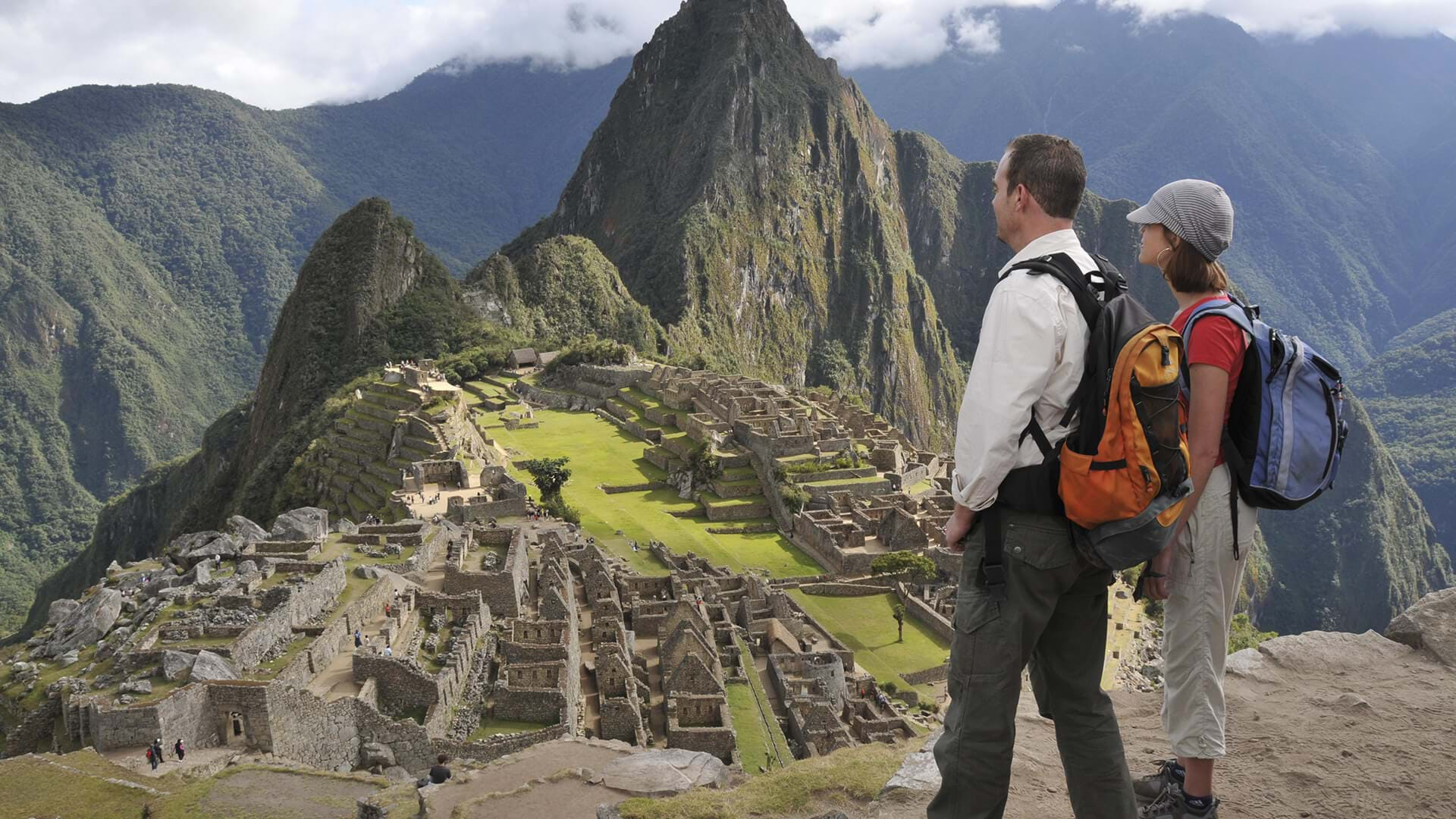
- Machu Picchu: complete guide to fully enjoy your trip
Take this recommendations so that you have an unforgettable experience.
Machupicchu, Cusco Credit: Eduardo Cayo / PromPerú
peru.travel
Reaching the most important tourist destination in Peru is not an easy task. Its special geographical location, added to the large number of people it receives daily, require some planning, and also, a a series of recommendations so that the experience is totally pleasant, without going over for any kind of setbacks.
The reason: this destination presents a wide variety of offers and packages that include all kinds of routes, accommodation and timetables, so a precise search is essential in order to choose the best option. To do this, we invite you to take a look this guide with useful tips so that you can enjoy this archaeological sanctuary to its fullest.
When to visit?
Many tourists who arrive in Machu Picchu usually coincide with sudden rains and a cloudy climate that sometimes prevents them from enjoying the wonderful view that the valley presents. To avoid this happening to you, the ideal time to visit the Inca citadel is between April and October, given that during these months the Cusco region goes through a dry season full of sunny days with temperatures ranging from 20° C during the day and 10° C at night.
However, if you go between November and March, it doesn’t mean that you’ll have a negative experience. During these months you could take advantage of a smaller presence of visitors and also enjoy a great green landscape often accompanied by a shimmering rainbow.
How to get there?
There are two ways to get to Machu Picchu. The fastest and most comfortable is by train with an approximate travel time of three hours. The trains depart every morning from Ollantaytambo and arrives in Aguas Calientes (closest town to the citadel), offering all kinds of services and amenities. If you wish to acclimatize before leaving, Aguas Calientes has multiple lodgings and a craft market for those who choose to take a day of rest. Otherwise, there are minivans that would take you to Machu Picchu if you prefer to continue.
Another alternative is going on foot along the road. Many tourists reserve this route in advance for everything it represents. If you are a lover of trekking and adventure, this experience will undoubtedly leave you ecstatic. It’s about a three to five-day excursion that will demand your maximum effort but it will be worth it because of the beautiful landscapes you will enjoy.
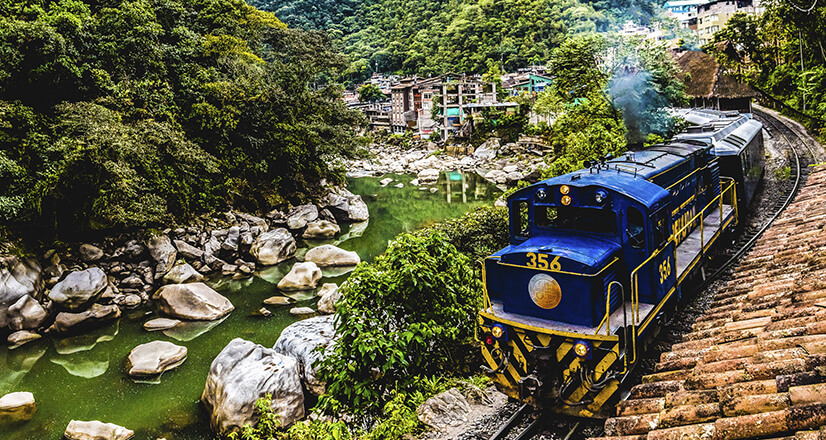
The fastest and most comfortable way to get to Machu Picchu is by train, with an approximate travel time of three hours. Credit: Shakedown Team / PromPerú.
How to hire a tour guide?
Due to the extension of Machu Picchu and in order to safeguard its integrity for visitors, it is mandatory to hire the service of a tour guide. This person not only will provide you with information you may did not know about the history of the Incas and the enigmatic origin of the citadel, but will assist you under any unforeseen event that may occur.
What to include in your backpack?
To enjoy a walk through the sanctuary, you need to take your passport or identity card with you and pack some comfortable items such as lightweight trekking shoes, a raincoat (in case of rain), sunscreen, a camera, repellent and a bottle of water that will help you cool down during and after the tour.
Be a responsible tourist
Finally, the most important recommendation for all visitors is to take care and preserve this complex. When visiting this sacred and historical place, try to comply with all the disposals and security measures without violating the warnings and prohibitions. Visitors must be aware of the cultural value that Machu Picchu represents so that future generations can enjoy and learn from its history.
Sources: El País / La Nación / Peru.com / El Mundo Ok / Boleto Machu Picchu / Guia de viajes
Follow us on social media Facebook | Instagram | Twitter | TikTok | YouTube

Find out more
6 places you can visit before arriving to Machu Picchu
Related articles
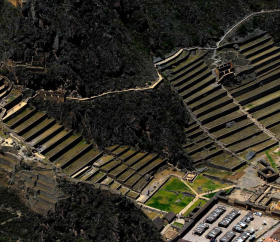
Ollantaytambo: an architectural jewel on the way to Machu Picchu
Discover this Inca fortress that impresses with its perfection.
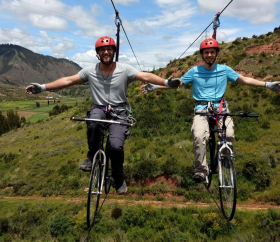
What adventure sports can you practice in Cusco?
Live the most extreme experiences in the impressive Sacred Valley.
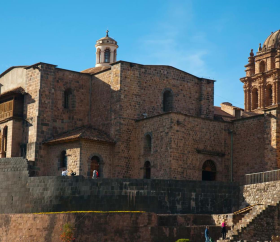
5 museums in Cusco that you should visit
Plan your trip to Cusco and start a cultural tour that will surprise you.
Machu Picchu Tours & Treks

As the mist lifts off the mountains and over the Inca ruins, Machu Picchu evokes an otherworldly feeling
It’s one of the world’s most incredible archaeological sites, with a breathtaking location to match. With all that Machu Picchu has to offer, it’s easy to understand why so many are drawn to the visitor heartland of Peru . The ultimate decision is how to get there. Choose a trek or take the train? You could hike through cloud forests along the classic Inca Trail, fulfill your Andes experience on the Quarry Trail or challenge yourself on the Choquequirao trek – it's up to you. We don’t need to tell you why the adventure is worth your while. Our local leaders will keep you safe, informed and inspired every step of the way.
Our Machu Picchu trips
Let's create an exclusive trip for your group.
Machu Picchu highlights
Which route is right for you.
With its spectacular natural scenery and profound cultural encounters, the Inca Trail is an international beacon for trekking. Attracting thousands of hikers each year, it's a challenging yet rewarding hike that stays with you for a lifetime. Although rated moderate, the relentless uphill (and downhill) hiking is tough - the fitter you are, the more you’ll enjoy it.
For an impressive hike off the beaten path, consider the Inca Quarry Trail. This lesser-known trek offers the same magical scenery of the Andes mountains, passing through local villages and visiting three smaller archaeological sites the other trails don’t. Another bonus is that the hike doesn’t require a permit – so once you book, you’re set.
Take your boots further with a challenging eight-day hike moving through high-altitude cloud forests, over mega mountain passes and along an ancient trail leading to the well-preserved Inca city ruins of Choquequirao. This trail might be secluded and not for the faint-hearted but it's also one adventure you'll never forget, and that's a promise.
Meet our team
Why choose us.
All our guides are certified local tour guides and trained in-house on Intrepid Safety Policies. Each trekking guide also receives exclusive Intrepid training, provided by mountain rescue experts in the field.
All our guides and trek leaders have been trained by medical specialists in handling altitude illness and are proficient in first aid. Our team carries oxygen cylinders on all treks for emergency use.
Our team members live and work in the Andean region, which means revenue from all our treks benefit the local economy.
We take care of the details, so you can focus more on enjoying the journey. Our tours include all meals, with essential camping equipment and the option to hire additional hiking equipment if needed.
We are proud to have the tick of approval from the Rainforest Alliance indicating that we meet and operate at the highest standards in environmental, social and economic sustainability.
We strive to use travel as a force for good. That’s why we choose to give back to the communities we visit, carbon offset all our trips and take our social and environmental responsibilities seriously. We’ve been officially certified as the world’s largest travel B Corp, which means when you choose Intrepid Travel, you can rest assured you’re traveling to improve the planet.
Machu Picchu tour reviews
Filter by rating
Inca Trail Express
Machu Picchu or Chichen Itza? Which historical site should you visit?
What I wish I knew before hiking to Machu Picchu
An open thank you letter from blind athlete, Dan Berlin, to his local leader
Inca Trail permits for 2020 are about to go on sale. Here’s everything you need to know.
Behind the scenes on the hardest physical challenge of my life: the Inca Trail
Why trekking the Inca Trail was the best way to celebrate turning 50
10 things you’ll only know if you’ve travelled in Peru
What to see at Machu Picchu? A guide to Peru’s ancient ruins
Learn more about Machu Picchu
Similar destinations.
Thinking about a trip to Peru but need help comparing it with other ancient sites? Check out our blog:
Machu Picchu or Chichen Itza
Machu Picchu travel FAQs
Do i need a covid-19 vaccine to join an intrepid trip.
Trips from 1 January 2023 onwards
From 1 January 2023, Intrepid will no longer require travelers to provide proof of vaccination against COVID-19 (excluding all Polar trips and select adventure cruises).
However, we continue to strongly recommend that all Intrepid travelers and leaders get vaccinated to protect themselves and others.
Specific proof of testing or vaccination may still be required by your destination or airline. Please ensure you check travel and entry requirements carefully.
What is Machu Picchu?
Machu Picchu is a magnificent reminder of the power and ingenuity of the Inca civilization.
The ancient citadel, built in the 15th century, was abandoned only 100 years later, and many mysteries remain.
Listed by UNESCO as a World Heritage site in 1983 and announced as one of the Seven Wonders of the World in 2007, Machu Picchu makes a lasting impression.
Where is Machu Picchu?
Overlooking the Urubamba River, the site of Machu Picchu sits above the Sacred Valley – located in the Cusco region of Peru.
How can I get to Machu Picchu?
Many travellers fly into the capital of Cusco before taking the train or choosing a hiking tour. The stepping stone to Machu Picchu is Ollantaytambo, about 1.5 hours away from Cusco by bus.
From Ollantaytambo, the most common ways to get to Machu Picchu are:
- Hiking the Inca Trail (one way to Machu Picchu)
- Taking the equally scenic and rewarding Quarry Trail
- Trekking the challenging 8-day Choquequirao Trail
Can I still hike if I take the train?
So, you want to experience the Inca Trail but aren't quite up for the entire hike?
The one-day option takes you by train part of the way where you hop off and trek the trade highway of the ancient Inca empire.
You will arrive at the Sun Gate in the afternoon to take in the views of Machu Picchu.
Is hiking the only way to get to Machu Picchu?
On all of our trips that visit Machu Picchu, you can choose the rail journey instead of the hike – simply specify while booking that you’d prefer the train option. There's no extra cost for this, though please note fees may apply if you decide to change to the train option after your Inca Trail permit has already been purchased.
Learn more about taking the train to Machu Picchu
When is the best time to visit Machu Picchu?
You can visit Machu Picchu all year round. The most popular time, and therefore the most crowded, is in June and July.
Low cloud cover during the dry season from April to October also means cold nights on hiking trails, so you'll need thermals for a good night’s sleep.
The wet season is from November to March. Temperatures rise and the region receives heavy rainfall, so waterproofs are essential if you're hiking. If you don't mind a bit of rain, the plus side is that crowds are smaller. If you want to hike the Inca Trail, note that it closes every year in February for maintenance.
Can you get to Machu Picchu in a day?
Yes, you can. Starting with an early rise in the morning, take a 1.5-hour bus ride to Ollantaytambo, then a 2.5-hour train to Aguas Calientes, followed by a 30-minute bus to Machu Picchu.
You will have a couple of hours to visit Machu Picchu and then return to Cusco the same way.
None of our trips visit Machu Picchu this way, as we believe it doesn’t allow enough time to explore (and really enjoy) the site and the Sacred Valley area.
How high is Machu Picchu?
Machu Picchu is found deep in the cloud forest at 2440 m (7972 ft) above sea level, sitting at 1000 m (3280 ft) lower than Cusco.
What does this mean for you? In terms of altitude, you're unlikely to experience any altitude issues at Machu Picchu itself.
But be aware, trekking to Machu Picchu involves walking up and down several steep stairs, ramps and terraces at various altitudes, which can be strenuous.
Will the altitude affect me?
Most people start to feel the effects of altitude at over 2000 m (6561 ft) regardless of age, gender or fitness level. While our leaders have basic first aid training and are aware of the closest medical facilities, it is very important that you make yourself aware of the causes and effects of traveling at altitude. Monitor your health and seek assistance accordingly.
It is essential to take it easy, drink plenty of water and speak to your group leader immediately if you feel unwell.
We recommend seeing your doctor if you have health concerns before the trip, especially if you have a pre-existing medical condition or are taking any medication.
Do I need a permit to hike to Machu Picchu?
Everyone hiking to Machu Picchu via the iconic Inca Trail or the shorter Inca Trail Express requires a permit. You don't need a permit to trek via the Quarry or Choquequirao trails.
If you do the Inca Trail with Intrepid, our adventure consultants secure your permit for you so you can focus on getting excited – just make sure you have your passport details handy at the time of booking.
Permits are available on a first-come, first-served basis, so booking well in advance is critical.
We endeavor to purchase your permit within two working days of receiving all necessary information.
What should I pack for Machu Picchu?
For a day trip exploring Machu Picchu, we recommended taking a small backpack with the essentials: sunscreen, hat, water bottle (filled before departing), a few snacks and mosquito repellent. It helps to wear breathable pants, a long shirt and a waterproof jacket – since the UV index is higher in the Andes and the site is prone to rainfall.
If you plan to trek before visiting Machu Picchu, read our detailed packing instructions in your Essential Trip Information.
What is Wayna Picchu?
Wayna Picchu (also known also as Huayna Pichu or Wayna Pikchu) means ‘young peak’ in Quechua – although the mountain appears anything but young, towering behind Machu Picchu.
Known as the ‘stairs of death’, the hair-raising climb takes about three hours to return. More recently, a cap of 400 people a day has been introduced on the number of visitors allowed to climb.
Can I climb Wayna Picchu with Intrepid Travel?
We have performed risk assessments on all our optional activities, and unfortunately, we don't consider climbing Wayna Picchu a safe activity at this stage.
Reaching Wayna Picchu involves climbing steep, narrow and exposed sets of stairs, and we just can't guarantee your safety.
Our leaders are specifically prohibited from assisting you in visiting Wayna Picchu.
What are the toilet facilities like at Machu Picchu?
There are public toilets located at the main entrance of Machu Picchu and none after entering the site – so make sure you time your stop before heading off to explore.
Take some coins with you as there is a small fee to use the toilet facilities.
What does the Rainforest Alliance tick of approval mean?
The Rainforest Alliance is a non-profit organization. It is working to build strong forests, healthy agricultural landscapes and thriving communities.
The green frog seal shows that an enterprise has been audited to meet environmental, social, and economic sustainability standards.
The Rainforest Alliance recognizes Intrepid as one of Peru's top certified tourism businesses.
Can I visit Machu Picchu if I have a disability?
Yes, but of course it will depend on your level of disability, fitness and what support will be available to you.
People who are visually impaired have completed the Inca Trail (with the right support crew, of course).
Contact us to discuss your particular circumstances and we can assess it from there.
Does my trip support The Intrepid Foundation?
Yes, all Intrepid trips support the Intrepid Foundation. Trips to this country directly support our global Intrepid Foundation partners, Eden Reforestation Projects and World Bicycle Relief. Intrepid will double the impact by dollar-matching all post-trip donations made to The Intrepid Foundation.
Eden Reforestation Projects
Eden Reforestation Projects are helping to mitigate climate change by restoring forests worldwide; they also hire locally and create job opportunities within vulnerable communities. Donations from our trips support restoration across planting sites in 10 countries around the globe. Find out more or make a donation World Bicycle Relief
World Bicycle Relief provides people in low-income communities with bicycles to mobilize school kids, health workers, and farmers in far-out areas – giving them access to vital education, healthcare, and income. Donations help provide Buffalo Bicycles – specifically designed to withstand the rugged terrain and harsh environment of rural regions – to those who need them most. Find out more or make a donation
APRIL SALE: Discover and book at up to 60% off!
Best Machu Picchu Tours & Trips
Find the right tour package for you through Machu Picchu. We've got 607 trips going to Machu Picchu, starting from just 2 days in length, and the longest tour is 65 days. The most popular month to go is August, which has the most tour departures.
Filters applied
Best 250+ machu picchu tours with 5,970 reviews.
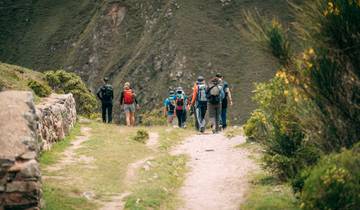
- Hiking & Trekking
- Sightseeing
- Christmas & New Year
Classic Inca Trail to Machu Picchu 4 Days
Manolo was a perfect guide
- Book With Flexibility This operator allows you to rebook your dates or tours with them for free, waiving change fees.

- In-depth Cultural
Machu Picchu Adventure
Great tour and amazing guide. Awesome group of people to travel with and would highly recommend.
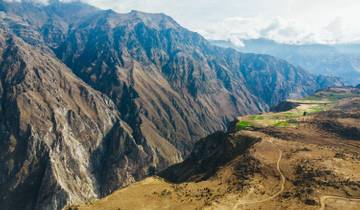
Absolute Peru
Did this tour in September / October 2015 and it was fantastic! Our guide Alex was excellent, he really understood that sorts of things we wanted to know and was always looking for ways to add value. For example, on our long drive across the Altiplano to Puno he arranged for us to stop at a llama and alpaca farm. For a few soles for the farmer were were able to get really close, take photos etc. Also really interesting to talk to him about Peruvian politics and so on. The group tended to always eat together and he always had recommendations for restaurants. Some of these were perhaps more expensive than others we might have chosen but still much cheaper than it would cost at home and the food was always good. Local guides were also of a high standard. Accommodation was pretty decent although the room in Paracas wasn't up to the standard of the rest. It was only one night though and it's a small place with limited choice. It did have a very nice roof terrace for breakfast. Transport was better than expected - the public buses are comfortable and spacious and the mininbuses and the like which were used just for our group were the same. The tour has lots of variety and there are plenty of things I'll remember for a lifetime - sandboarding at Huachachina, swimming in Lake Titicaca (absolutely freezing), playing football against locals at the homestay, spotting monkeys at our jungle lodge and of course, the first sight of Machu Picchu through the fog. If you have the time and money, this is the Peru trip to take.
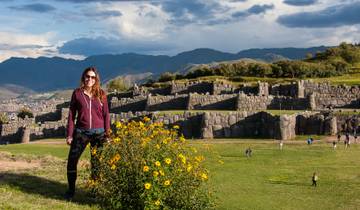
7 Day Cusco Travel Package: Cusco, Sacred Valley, Machu Picchu, Humantay Lake, and Rainbow Mountain.
The best way to explore Cusco and the surrounding area. Let TourRadar handle all your itineraries if you want the most valued stress free experiences.

INCA ADVENTURES - 7 Days (Lima and Cusco) with Domestic Flights
For my first time visit in the amazing Peru, it was an unexpectedly beautiful experience. The tour was perfectly organized, starting with airport pick-up, up to accommodation and guides. They were very friendly and helpful persons, well documented, providing a lot of information and facts about all the great places we’ve seen. Communication with Leoned, was like a swiss watch- impecable. The interaction with Ronald Sotalero, was a big plus for the trip; he made us feel like his family! His passion for history and promoting the Andean culture made me wanna be a little bit Peruvian too. Thank you WAMAN ADVETURES for the wonderful experience and excellent organization of this trip! ARRIBA PERU!
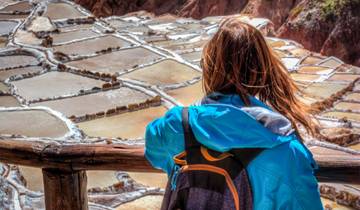
5 Day Cusco Travel Package: Cusco, Sacred Valley, Machu Picchu, and Maras Moray.
Test yttedsjdksdljsldjlds

Premium Peru
Loved Peru. I found the people take great pride in their cities, culture and history and it shows in how clean the streets are, how great the food is and how wonderful the guides are. Loved the wildlife, the scenery and archeological sites too. My only downside was the airport.. Delayed flights and when trying to return home, no signage to show the directions from domestic (Cusco to Lima) to international section of airport. When I asked for help, I was told to go out the door, come back in the door next to it, only to find out that I needed to go outside, go to section adjacent and then go upstairs to departures which also had no sign there for "international departures". The LATAM staff gave me the run around on my luggage. One person said it would go automatically to Newark another said pick up your luggage in Lima and transfer to United. My luggage never arrived in Lima nor in Newark. When I arrived in Newark the United people said that LATAM was lying as it is never sent on directly and had to be collected and transferred by hand in Lima. I had to file a lost baggage claim upon final arrival in Canada . Still waiting for news.
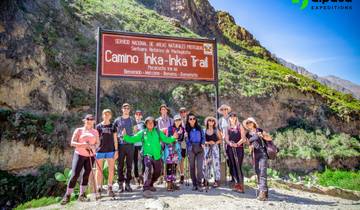
Classic Inca Trail Trek 4D/3N to Machu Picchu (Group service )
We highly recommend this Inca tour company. They are locally owned and employ local people. The guides spoke excellent English, they were very kind and encouraging and put a lot of humour into our trek. Nothing was too much trouble. The food was amazing and camping equipment clean and warm. Do not hesitate to use Alpaca expeditions
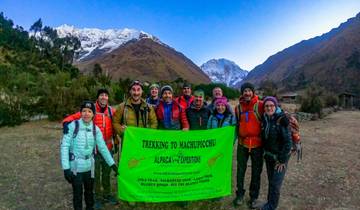
Ultimate Salkantay Trek 5D/5N with glass cabañas & hobbit house + hot tub jacuzzi.
Ivan and the team were super. I already miss them

06 Days Cusco Machu Picchu - Humantay Lake And Rainbow Mountain
Love tour guide, knowledgeable, good English.
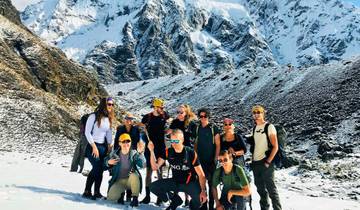
Ultimate Salkantay Trek to Machu Picchu - 5 Days
Our guide Carlos was amazing and the porters took great care of us!
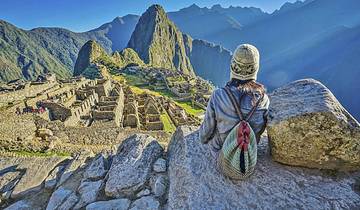
- Mountain Hikes
04 Day Classic Inca Trail to Machu Picchu - Small Group Service
My family and I have just returned from the Inca Trial. Everything from start to finish was excellent, our guide Raul was extremely knowledgeable about the trail, the history of the Incas and his experience was invaluable in making everything run smoothly. Since the previous conversations throught emails they took note of our dietary requirements. They will happily accommodate if you are vegetarian or have any other dietary restrictions. Overall the food was better than what we had in some restaurants in Cusco. After an exhausted day the food was everything! Having completed the classic inca trail (4 days), we had no complaints and honestly everything was amazing. We highly recommend the Inkayni team, you won’t regret I promise <3
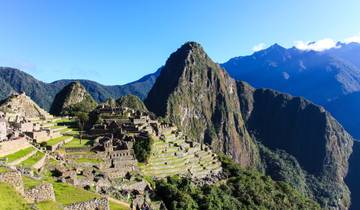
Hiking The Classic Inca Trail to Machu Picchu & Sacred Valley
We had a fantastic time together with our guide Richard! He was a nice and helpful guy who knows a lot about the Inca and their buildings. The 4 day Inca trail was an unforgetable experience for us. Having known the archeological sites like Ollantaytambo and Chinchero of the Sacred valley was amazing, and Machu Picchu is simply magic. We highly recommend Inkayni Peru Tours as they want to deliver 'quality' first before 'quantity' meaning, they offer top services with a reasonable cost.
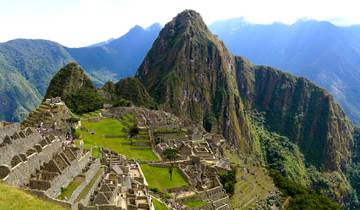
Explore Machu Picchu National Geographic Journeys
Fantastic tour, lovely food and great guide. Had enough time everywhere except Cusco..could have done with an extra day or two there, so it's worth adding extra days to your tour to do more activities around Cusco.
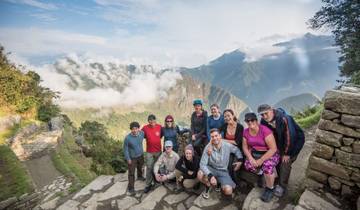
Inca Trail Express
Angela and Jose were great and took excellent care of us. We went at a pace that was accommodable for everyone.
Best Machu Picchu Tours Reviews
The tour was overall fantastic, the tour guides were incredible and the work that the porters and the chef do are unmatched. Highly recommend
Amazing experience! The tour moves quickly so you see a lot in a short amount of time, which is exactly why I love these types of tours. I couldn't of asked for a better guide or group.
great guide, great sites to visit topped with Inka trail
Machu Picchu Destinations:
- Salkantay Trek (24)
- Lares Trek (17)
Machu Picchu Tours starting in:
- Cusco (314)
- Group (501)
- Fully Guided (385)
- Family (349)
- Hiking & Trekking (267)
- Explorer (238)
- Personalized (216)
- Partially Guided (194)
- Active (191)
- In-depth Cultural (160)
- Private (93)
- Self-Guided (30)
- Custom (26)
- Ocean Cruise (11)
- Coach / Bus (9)
- River Cruise (8)
- Food & Culinary (6)
- 3 Day Tours (47)
- 7 Day Tours (252)
- 10 Day Tours (96)
- 2 Week Tours (43)
- 3 Week Tours (35)
- 4 Week Tours (5)
- 1 Month+ Tours (6)
- Spring 2024 (378)
- Summer 2024 (454)
- Fall / Autumn 2024 (461)
- Winter 2024 / 2025 (416)
- Spring 2025 (276)
- Summer 2025 (255)
- Fall / Autumn 2025 (246)
- Winter 2025 / 2026 (219)
- April 2024 (315)
- May 2024 (392)
- June 2024 (413)
- July 2024 (431)
- August 2024 (443)
- September 2024 (441)
- October 2024 (442)
- November 2024 (433)
- December 2024 (407)
- January 2025 (254)
- February 2025 (199)
- March 2025 (253)
- April 2025 (255)
- May 2025 (250)
- June 2025 (253)
- July 2025 (241)
- August 2025 (241)
- September 2025 (241)
- October 2025 (232)
- November 2025 (227)
Other Regions in Peru
- Peruvian Amazon (56)
- Tambopata (50)
- Peruvian Coast (45)
- Colca Canyon (29)
- Iquitos (29)
- Rainbow Mountain (23)
- Huascaran National Park (17)
- Huaraz (14)
- Arequipa (12)
- Machu Picchu and the Sacred Valley: Hike, Cost & Difficulty
- How to get to Machu Picchu
- Machu Picchu & Peru tickets, permits, vaccinations, and visa
- Do I need a guide for visiting Machu Picchu?
- Machu Picchu Packing List (Tried and Tested)
- Training for Machu Picchu & How to Prepare (Updated 2024)
- Best time to visit Machu Picchu (Peru) in 2024/2025
- Weather in Machu Picchu in 2024/2025
Travel Styles
- Budget (78)
- Luxury (25)
- Singles and Solo (351)
- For Couples (119)
- Young Adults (15)
- Seniors (273)
- History Classics
- Your Profile
- Find History on Facebook (Opens in a new window)
- Find History on Twitter (Opens in a new window)
- Find History on YouTube (Opens in a new window)
- Find History on Instagram (Opens in a new window)
- Find History on TikTok (Opens in a new window)
- This Day In History
- History Podcasts
- History Vault
Machu Picchu
By: History.com Editors
Updated: June 29, 2023 | Original: June 13, 2011

Tucked away in the rocky countryside northwest of Cuzco, Peru, Machu Picchu is believed to have been a royal estate or sacred religious site for Inca leaders, whose civilization was virtually wiped out by Spanish invaders in the 16th century. For hundreds of years, until the American archaeologist Hiram Bingham stumbled upon it in 1911, the abandoned citadel’s existence was a secret known only to peasants living in the region.
The site stretches over an impressive 5-mile distance, featuring more than 3,000 stone steps that link its many different levels. Today, hundreds of thousands of people tramp through Machu Picchu every year, braving crowds and landslides to see the sunset over its towering stone monuments and marvel at the mysterious splendor of one of the world’s most famous manmade wonders.
Machu Picchu’s Inca Past
Historians believe Machu Picchu was built at the height of the Inca Empire, which dominated western South America in the 15th and 16th centuries. It was abandoned an estimated 100 years after its construction, probably around the time the Spanish began their conquest of the mighty pre-Columbian civilization in the 1530s. There is no evidence that the conquistadors ever attacked or even reached the mountaintop citadel, however; for this reason, some have suggested that the residents’ desertion occurred because of a smallpox epidemic.
Did you know? Machu Picchu is made up of more than 150 buildings ranging from baths and houses to temples and sanctuaries.
Many modern-day archaeologists now believe that Machu Picchu served as a royal estate for Inca emperors and nobles. Others have theorized that it was a religious site, pointing to its proximity to mountains and other geographical features that the Incas held sacred. Dozens of alternate hypotheses have cropped up in the years since Machu Picchu was first unveiled to the world, with scholars variously interpreting it as a prison, a trade hub, a station for testing new crops, a women’s retreat or a city devoted to the coronation of kings, among many examples.
Machu Picchu’s 'Discovery' by Hiram Bingham
In the summer of 1911, the American archaeologist Hiram Bingham arrived in Peru with a small team of explorers hoping to find Vilcabamba, the last Inca stronghold to fall to the Spanish. Traveling on foot and by mule, Bingham and his team made their way from Cuzco into the Urubamba Valley, where a local farmer told them of some ruins located at the top of a nearby mountain. The farmer called the mountain Machu Picchu, which translates to “old peak” in the native Quechua language.
On July 24, after a tough climb to the mountain’s ridge in cold and drizzly weather, Bingham met a small group of peasants who showed him the rest of the way. Led by an 11-year-old boy, Bingham got his first glimpse of the intricate network of stone terraces marking the entrance to Machu Picchu.
The excited Bingham spread the word about his discovery in a best-selling book, “The Lost City of the Incas,” sending hordes of eager tourists flocking to Peru to follow in his footsteps up the formerly obscure Inca Trail. He also excavated artifacts from Machu Picchu and took them to Yale University for further inspection, igniting a custody dispute that lasted nearly 100 years. It was not until the Peruvian government filed a lawsuit and lobbied President Barack Obama for the return of the items that Yale agreed to complete their repatriation.
Although he is credited with making Machu Picchu known to the world—indeed, the highway tour buses use to reach it bears his name—it is not certain that Bingham was the first outsider to visit it. There is evidence that missionaries and other explorers reached the site during the 19th and early 20th centuries but were simply less vocal about what they uncovered there.
The Site of Machu Picchu
In the midst of a tropical mountain forest on the eastern slopes of the Peruvian Andes, Machu Picchu’s walls, terraces, stairways and ramps blend seamlessly into its natural setting. The site’s finely crafted stonework, terraced fields and sophisticated irrigation system bear witness to the Inca civilization’s architectural, agricultural and engineering prowess. Its central buildings are prime examples of a masonry technique mastered by the Incas in which stones were cut to fit together without mortar.
Archaeologists have identified several distinct sectors that together comprise the city, including a farming zone, a residential neighborhood, a royal district and a sacred area. Machu Picchu’s most distinct and famous structures include the Temple of the Sun and the Intihuatana stone, a sculpted granite rock that is believed to have functioned as a solar clock or calendar.
Machu Picchu Today
A UNESCO World Heritage Site since 1983 and designated one of the New Seven Wonders of the World in 2007, Machu Picchu is Peru’s most visited attraction and South America’s most famous ruins, welcoming hundreds of thousands of people a year. Increased tourism, the development of nearby towns and environmental degradation continue to take their toll on the site, which is also home to several endangered species. As a result, the Peruvian government has taken steps to protect the ruins and prevent erosion of the mountainside in recent years.
Photo Galleries

HISTORY Vault: Ancient History
From Egypt to Greece, explore fascinating documentaries about the ancient world.

Sign up for Inside History
Get HISTORY’s most fascinating stories delivered to your inbox three times a week.
By submitting your information, you agree to receive emails from HISTORY and A+E Networks. You can opt out at any time. You must be 16 years or older and a resident of the United States.
More details : Privacy Notice | Terms of Use | Contact Us
Sign up for our Newsletter!
- Our Purpose
- Travel Agents
- Terms & Conditions
- Privacy Statement
Copyright © 2024 SA Luxury Expeditions LLC, All rights reserved | 95 Third Street, 2nd floor, San Francisco, CA, 94103 | 415-549-8049 California Registered Seller of Travel - CST 2115890-50. Registration as a seller of travel does not constitute approval by the state of California.
National Geographic content straight to your inbox—sign up for our popular newsletters here

Soak up the breathtaking view of Machu Picchu.
Discover the Mysteries of Machu Picchu
Thousands of years of history await in Peru's Lost City of the Incas.
Here’s a cool fact to share with children visiting Machu Picchu in Peru —the place probably would never have been discovered without the help of a kid just like them.
You see, after two years of research to pinpoint the location of the “Lost City of the Incas” and raise money for his expedition, intrepid American historian and explorer Hiram Bingham set off into the Peruvian jungle in 1911 with a fedora planted firmly on his head and nothing more than an educated guess as to where it might be. He eventually only found the spot with the aid of an 11-year-old Quechua Indian boy.
“It fairly took my breath away,” Bingham wrote of his first encounter with the ruins in 1911 high in the Andes. “What could this place be?”
A century later we’re still not exactly sure why this place was constructed on a spot that practically touches the sky—a mystery kids will surely find compelling. Nobody is quite sure when Machu Picchu was first built—educated guesses put it at around 1450—or why it was abandoned a century later. Researchers still aren’t sure what its original function might have been: a place of worship, a royal estate, an astronomical observatory? And nobody can say with any certainty what became of its original inhabitants.
That’s why Machu Picchu is “one of those places that overdelivers ,” says National Geographic Traveler contributing editor Barton Lewis, who has been visiting there since the 1960s. “No matter what your expectations are, it’s more than you imagined. The Inca were the end result of 5,000 years of civilization that started at the same time as Egypt and Mesopotamia. Because of conquest and disease, however, they were only around for 100 years. But they left behind this undisturbed site that is just incredible.”
About a third of the ruins have been reconstructed and it’s easy to imagine how the city must have looked in Inca times, clinging to the top of an emerald green ridge in the rain forest. A main plaza flanked by stone homes, temples, workshops, bathing areas, and a royal palace, surrounded in turn by stone terraces where maize and other crops were grown. Estimates put the population at no more than 1,000 at any given time. Although the reconstructed temples are the most impressive buildings, Machu Picchu’s most important structure is the Intihuatana or “hitching post of the sun,” a mysterious abstract stone construction that ancient priests may have used to study the heavens and make astrological predictions.
At the Temple of the Condor, show kids how the large stone in the middle of the structure has been carved to resemble the head and neck feathers of a huge Andean bird, and how the rocks behind are shaped into outspread condor wings. And gazing down on the Temple of the Sun, point out the Serpent Window, which according to legend was used to admit snakes to the shrine.
Part of the fun of Machu Picchu is getting there. Nearly everyone takes the narrow-gauge railway from Cusco to the Urubamba Valley below the ruins. You can hop off the train at the 82‑kilometer mark and walk the Inca Trail (26 miles)—the most celebrated hiking route in all of South America—or continue up to the town of Aguas Calientes, where buses shuttle you up a series of steep switchbacks to the mountaintop.
If your kids aren’t quite up to the full Inca Trail, an alternative is disembarking at the 104‑kilometer spot and hiking the last four to five hours of the route (8.75 miles).
“That is the single best way to be introduced to Machu Picchu,” says Lewis. “You come up really steep steps, almost climbing with your hands. At the crest there’s a stone arch. You look down and see the citadel below and it’s astounding.”
Due to its high and remote location, Machu Picchu requires some preparation, especially when visiting with children. If time permits, take a few days to acclimatize to the trail’s altitude that ranges between 6,700 and 12,000 feet above sea level.
“When one sees Machu Picchu for the first time you have to stop and try to gather it in,” says Lewis. “Even without knowing the background, cosmology, or history, it’s incredibly impressive. The more you observe and see, the more you wonder about it. How did these people do this? And to what purpose?”
Know Before You Go
Fast facts:.
- Machu Picchu was built on two fault lines so it is no stranger to earthquakes. When one occurs, the stones bounce like they are dancing and then fall back into place. It is because of this engineering feat that the site still stands today.
- Nat Geo Expeditions
- More than a hundred skeletons were found at the site. Today, we now know that they were close to evenly split between women and men.
- Hiram Bingham thought that he had discovered the Lost City of Vilcabamba, even though we now know it was Machu Picchu. Unbeknownst to him, he had also traveled through Vilcabamba in 1911.
Insider Tip: The entrance to Machu Picchu charges a flat rate no matter what time you arrive at the site. Be sure to get there early to get the most exploring in for your money.
Related Topics
- FAMILY TRAVEL
You May Also Like

These remote Inca ruins rival Machu Picchu

Explore Inca life beyond Machu Picchu on this South American trail
Free bonus issue.

These mummies were made … by accident?

9 travel stories our readers loved in 2023

Road-tripping in Queensland's tropical north

8 space-themed trips for families, from astronomy stays to NASA space launches

Visiting Switzerland? Here’s what the locals love
- Perpetual Planet
- Environment
- History & Culture
- Paid Content
History & Culture
- Mind, Body, Wonder
- Terms of Use
- Privacy Policy
- Your US State Privacy Rights
- Children's Online Privacy Policy
- Interest-Based Ads
- About Nielsen Measurement
- Do Not Sell or Share My Personal Information
- Nat Geo Home
- Attend a Live Event
- Book a Trip
- Inspire Your Kids
- Shop Nat Geo
- Visit the D.C. Museum
- Learn About Our Impact
- Support Our Mission
- Advertise With Us
- Customer Service
- Renew Subscription
- Manage Your Subscription
- Work at Nat Geo
- Sign Up for Our Newsletters
- Contribute to Protect the Planet
Copyright © 1996-2015 National Geographic Society Copyright © 2015-2024 National Geographic Partners, LLC. All rights reserved
What to know when planning an awe-inspiring hike on the Inca Trail
Peru's most famous trail leads to Machu Picchu
- Newsletter sign up Newsletter

While on the Inca Trail, every step — past ancient ruins, up stone staircases and over Dead Woman's Pass — brings hikers closer to their final goal: reaching Machu Picchu. Trains and buses drop thousands of visitors off here every day, but hiking in offers an unmatched experience. Hikers get to sit in sacred spaces, sleep under the stars and bond with their fellow adventurers. The promise of being able to reach the Sun Gate and take in that first view of Machu Picchu keeps them motivated.
Planning a hike on the Inca Trail takes time. There are also important factors to keep in mind, like when the dry season is and what time of year the trail is closed for maintenance. Here are some tips to ensure an epic experience.
What is the Inca Trail?
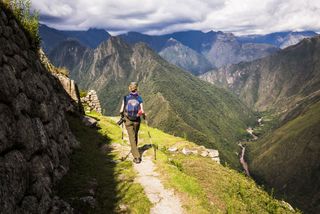
Hikers get to see stunning views from the Inca Trail
The Classic Inca Trail is a 25-mile-long hiking trail in the Andes Mountains that takes four days to complete and ends at Machu Picchu. After starting at KM 82 in the Sacred Valley, hikers will follow the stone paths that wind by sites like the Valley of Llulluchapampa, Sayacmarca ruins and Wiñay Wayna complex. On the final day of the trek, you most likely will rise well before dawn in order to arrive at the Sun Gate and Machu Picchu around sunrise.
Subscribe to The Week
Escape your echo chamber. Get the facts behind the news, plus analysis from multiple perspectives.

Sign up for The Week's Free Newsletters
From our morning news briefing to a weekly Good News Newsletter, get the best of The Week delivered directly to your inbox.
How soon should you start planning a hike?
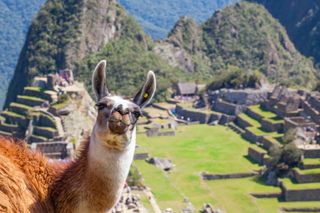
Running across alpacas is another highlight of the Inca Trail
If possible, think about booking six to nine months in advance. The peak season to visit is June through August, and with the Inca Trail being a popular hike, permits are snapped up quickly.
What is the best time of year to hit the trail?
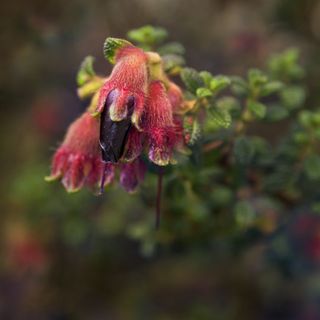
One of the many types of flowers that grow along the trail
The trail is open year-round except in February, when it is closed for maintenance. Dry season is May through September, "where temperatures are milder and you can expect bright, sunny days, making for great visibility along the hike," Krissy Concannon, an independent affiliate of Travellustre in Boston, told The Week. The Inca Trail is one direction only, and when the adventure is over you will leave by train or bus.
Do I need to train for the Inca Trail?
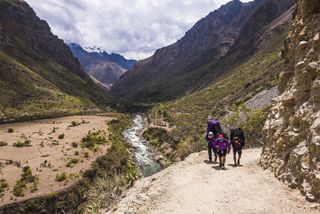
Preparation for the hike should start before you leave home
This is a strenuous hike at a high altitude, traversing different landscapes like cloud forests and grasslands. Travelers should expect to travel six to nine miles a day and can train ahead of time by hiking with a pack or getting regular exercise at home. Julie Sudderth of Vivid Getaways in Dallas told The Week she has seen "hikers from 7 to 70 years old command this trail with no problems." The Inca Trail reaches an elevation of 13,800 feet above sea level, making acclimation critical, especially for those who have experienced altitude sickness previously. Concannon recommends spending at least two or three days in Cusco prior to the hike to acclimate better to the altitude.
What kind of experiences can you have on the trail?
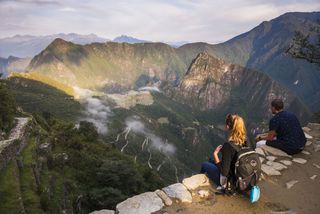
Sunrise on the trail is a beautiful experience
Every trip has one element in common: You must go with an operator and cannot hike on your own. "Normally, the best companies go with the best guides," Sudderth said. "This is invaluable." Good guides "will know when to slow down or quicken the pace as they are actively reading the client’s demeanor," she added, and also "weave the rich history, wildlife and flora and fauna into the hike" while keeping everyone "engaged and motivated. With children especially, this is priceless."
Those who want to go all out can book a private or small group hike, with an expert guide and porters, a well-stocked and clean bathroom tent, gourmet meals and high-quality camping gear, from the pillows to the tents. Midrange experiences are catered toward hikers who do not want a bare-bones trip but also aim to keep costs down, and include nice gear and good food with moderate accommodations.
Concannon warns that when opting for low-cost hiking tours, travelers "need to be cautious to ensure operators are not cutting corners that could negatively impact their experience. Hikers can expect minimal or lesser quality gear and food options to be more minimal. Campsite options could also be less than ideal, with locations lacking in view."
Sign up for Today's Best Articles in your inbox
A free daily email with the biggest news stories of the day – and the best features from TheWeek.com
Catherine Garcia is night editor for TheWeek.com . Her writing and reporting has appeared in Entertainment Weekly and EW.com , The New York Times , The Book of Jezebel , and other publications. A Southern California native, Catherine is a graduate of the University of Redlands and the Columbia University Graduate School of Journalism.
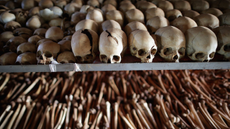
In Depth This month, world remembers one of the worst atrocities of the 20th century
By The Week UK Published 21 April 24

The Week's daily crossword
By The Week Staff Published 21 April 24

The Week's daily hard sudoku puzzle
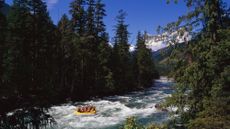
The Week Recommends Have a rip-roaring time on the water
By Catherine Garcia, The Week US Published 18 April 24

The Week Recommends This 'genre-bending' new Amazon series is set in a post-apocalyptic wilderness where survivors shelter below ground
By Adrienne Wyper, The Week UK Published 17 April 24

The Week Recommends Why more of us are choosing to go on holiday on our own
By Adrienne Wyper, The Week UK Published 16 April 24
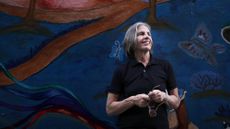
The Week Recommends April is National Poetry Month
By Scott Hocker, The Week US Published 16 April 24

The Week Recommends The trend for combining classics from two food cultures can result in dishes that are doubly delicious
By The Week UK Published 15 April 24

The Week Recommends The southwestern region pretty much has it all, from beachfront, to port metropolis, to verdant mountainside
By Scott Hocker, The Week US Published 15 April 24

The Week Recommends Mauritius, the star of the Indian Ocean, is the ultimate in relaxing destinations
By James Rampton Published 11 April 24

The Week Recommends From 'subversive' textiles to exquisite Flemish drawings, there's something for every art lover
By Adrienne Wyper, The Week UK Published 11 April 24
- Contact Future's experts
- Terms and Conditions
- Privacy Policy
- Cookie Policy
- Advertise With Us
The Week is part of Future plc, an international media group and leading digital publisher. Visit our corporate site . © Future US, Inc. Full 7th Floor, 130 West 42nd Street, New York, NY 10036.

From Machu Picchu to the Sacred Valleys: Why Peru stands out as a favorite world destination
T hanks to its cultural and natural diversity, as well as its millennia-old history and colonial landscapes, Peru has been named the best international destination by the Spanish publication Viajes National Geographic.
It was the readers of Viajes National Geographic who bestowed this prestigious recognition upon Peru in the second edition of their awards for the best tourism destinations.
Viajes National Geographic states on its website that readers and survey participants have singled out the Inca citadel of Machu Picchu, Cuzco, and the Sacred Valleys as the standout tourist attractions of this South American country.
Peru surpassed international tourism heavyweights including Egypt, Colombia, Morocco, and Uzbekistan.
In addition to the imposing and ancient Machu Picchu, Viajes National Geographic highlights the Sacred Valley of the Incas, featuring towns such as Chincheros, Pisac, Urubamba, Ollantaytambo, and Maras Moray . Similarly, the former capital of the Inca empire, Cuzco, offers travelers colonial attractions like the San Pedro Market, its Plaza de Armas, its cathedral, and countless narrow streets that reflect its diverse heritage.
Among the Viajes NG Awards 2024, readers also recognized destinations such as New York City as the best city in the world, the Anantara Palazzo Naiadi in Rome as the best hotel, and KLM as the best airline.

- Machu Picchu Tourism
- Machu Picchu Hotels
- Machu Picchu Bed and Breakfast
- Machu Picchu Vacation Rentals
- Flights to Machu Picchu
- Machu Picchu Restaurants
- Things to Do in Machu Picchu
- Machu Picchu Travel Forum
- Machu Picchu Photos
- Machu Picchu Map
- All Machu Picchu Hotels
- Machu Picchu Hotel Deals
- Last Minute Hotels in Machu Picchu
- Machu Picchu
- Things to Do
- Restaurants
- Vacation Rentals
- Travel Stories
- Rental Cars
- Add a Place
- Travel Forum
- Travelers' Choice
- Help Center
Machu Picchu mountain - Machu Picchu Forum
- South America
- Peru
- Cusco Region
- Sacred Valley
- Machu Picchu
Machu Picchu mountain
- United States Forums
- Europe Forums
- Canada Forums
- Asia Forums
- Central America Forums
- Africa Forums
- Caribbean Forums
- Mexico Forums
- South Pacific Forums
- South America Forums
- Middle East Forums
- Honeymoons and Romance
- Business Travel
- Train Travel
- Traveling With Disabilities
- Tripadvisor Support
- Solo Travel
- Bargain Travel
- Timeshares / Vacation Rentals
- Sacred Valley forums
- Machu Picchu forum

Hi, I'm planning to hike up Machu Picchu Mountain in 10 days and can't decide on what footwear to take. I have both walking shoes (more like trainers) and hiking boots with ankle support. Both have good grip. If I take the hiking boots which are slightly heavier and take up more space in my suitcase I may find myself using these on this occasion only and still having to take walking shoes/trainers for other activities. Any suggestions as to whether ankle support is vital for this hike. Thank you.
3 replies to this topic

Trainers are fine, but you just have to be careful where you step.
One thing to consider is that you shoes can get dusty or even muddy or wet particularly if you do the hike early morning when there are more chance of a light rain/drizzle.

Ok ....heres a hint for you.
> you are only issued 1 pr of feet. Screw those up on your trip for ANY REASON/EXCUSE..you wont be a happy camper.
> if you KNOW you have weak ankles or like/need the extra support...why ignore it?
> i ALWAYS bring 2 pr of CIMFORTABLE shoes on my travels and swap daily.
> if you have access to google maps and know how to use street view, use it at MP. you can get a good idea on whats ahead. You wont find nice, smooths, flat concrete sidewalks or stairs in the citadel.

I used to take hiking boots on most of our trips but then westrated travelling with carry on bags only and it wasn't practical. I now use my Keen Targhee 2 hiking shoes/trainers everywhere. I have used them on multi day treks, in deserts, up mountains and jungle trips as well as walking around cities.
It sounds as though the "walking shoes/trainers" you have in mind could be very similar? if so o think you would be fine with those as long as you are happy wearing them for extended period and they have good grip. IMHO the most important factor is comfort.
- How to get your MP ticket in person -- sharing my experience 8:07 pm
- Is 3pm entry too late? yesterday
- Machu Picchu mountain yesterday
- Montana hike with Circuit 3 Apr 19, 2024
- 21 may 24 entrance tickets? Help Apr 18, 2024
- Machu Pichu Tickets Apr 18, 2024
- Vistadome Views to/from Machu Picchu Apr 17, 2024
- Bug bites from MP Apr 16, 2024
- Another question about MP entry time Apr 16, 2024
- Machu Picchu to Cusco Recommendation Apr 15, 2024
- Machu Picchu train - departures other than Cusco Apr 14, 2024
- Confused by ticket time Inka bridge + Circuit 1,2 Apr 12, 2024
- Machu Picchu Ticket has wrong nationality Apr 10, 2024
- Machu Picchu Tickets Apr 10, 2024
- Best time to travel to Machu Picchu 9 replies
- Reviews of Tour Operators 38 replies
- altitude sickness 20 replies
- Inca Trail - Day To Day Weather and Clothing 14 replies
- Elevation history and Altitude Illness... 11 replies
- Buying tickets for MP online 51 replies
- Machu Picchu closing in 2012? 5 replies
- best time to do Inca trail 13 replies
- Inca Trail vs. Lares Trail 16 replies
- Macchu Picchu ,closing in 2012? 8 replies
Machu Picchu Hotels and Places to Stay
- Great tips for Machu Picchu - May 2016
- What are the hours of Machu Picchu?
- What if I buy tickets for the wrong date?
- Day trip to Machu Picchu
- Is Machu Picchu accessible to special needs visitors?
- Buying Consettur bus tickets to Machu Picchu
- Student Tickets for Machu Picchu
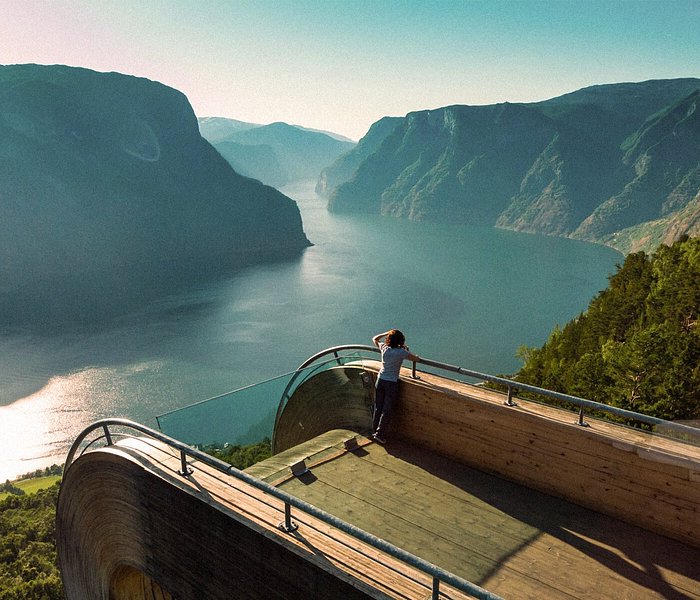
- Dina Boluarte .
- Retiro AFP .
- Jonas Brothers .
- Yape comisión .
- Resultados UNP .
- River Plate vs Boca Juniors .
- Dólar en Perú .
- Horóscopo .
- Dólar BCV .
- DolarToday .
- ÚLTIMAS NOTICIAS
- ESPECTÁCULOS
- CINE Y SERIES
- Últimas Noticias
Conoce la principal atracción turística del Perú: recibió 818.000 visitantes en 2024 y no es Machu Picchu
De acuerdo con información del mincetur, en el primer trimestre del año, un lugar situado en la capital atrajo más turistas que otros destinos. es importante precisar que esta atracción se inauguró el 26 de julio de 2007., la única colonia austro-alemana del mundo está en perú: ¿por qué cada vez más personas quieren vivir en pozuzo, world travel awards 2024: colombia con 20 nominaciones, entre ellas 'destino líder de sudamérica'.
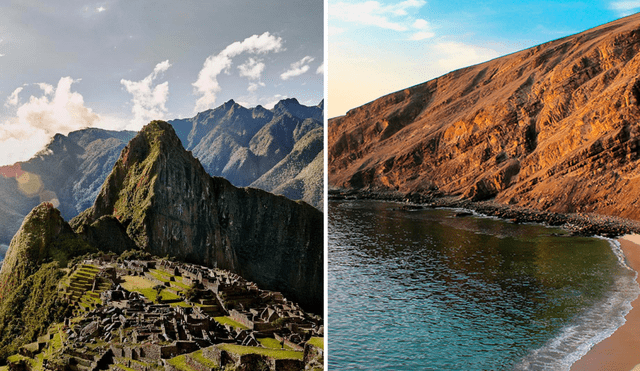
Perú se caracteriza por sus impresionantes destinos turísticos ubicados en diferentes puntos de su territorio , pero hay uno que destaca sobre todos los demás. En lo que va del año, este lugar ha alcanzado un total de 818.000 visitantes , y superó en número de turistas a otros sitios, como Machu Picchu en Cusco, la Reserva Nacional de Paracas y el Valle del Colca en Arequipa.
¿Cuál es la principal atracción turística del país?
Según información del Ministerio de Comercio Exterior y Turismo ( Mincetur ), el sitio que ha atraído más visitantes no se ubica en Cusco, sino en la capital del Perú. El Circuito Mágico del Agua encabeza la lista con 818.000 visitantes , seguido por la Reserva Nacional de Paracas con 217.000 y los baños termales de San Mateo en San Martín con 204.000.

PUEDES VER: Ernesto Pimentel: ¿a qué se dedica Miluska Jácome, la madre de su hijo, y cuántos años llevan viviendo juntos?

El Circuito Mágico del Agua, situado en el Parque de la Reserva, abrió sus puertas el 26 de julio de 2007. Foto: Lima Tour Perú
¿Cuántos visitantes tiene Machu Picchu?
Durante el primer trimestre del año, en Cusco, la explanada de Sacsayhuamán recibió a 173.000 turistas. Por su parte, el parque arqueológico de Ollantaytambo registró la llegada de 157.000 personas, y la ciudad inca de Machu Picchu , reconocida como una de las maravillas del mundo, atrajo a 112.000 visitantes .
¿En qué año se inauguró el Circuito Mágico del Agua?
Durante la Guerra del Pacífico, entre 1879 y 1884, surgió un grupo de civiles conocido como el ' Batallón de la Reserva ', que estaba conformado mayoritariamente por adultos, pero también por niños, todos unidos por un objetivo común: defender la capital.
Ellos se organizaban en un área que más tarde se conocería como el Parque de la Reserva , el cual funcionaba como campo de entrenamiento y, a su vez, fortalecía el espíritu nacional en tiempos de adversidad. En reconocimiento a su valentía, en 1929 se inauguró el Parque de la Reserva, diseñado para honrar a estos héroes civiles .

PUEDES VER: Descubre cuál es la bandera más bonita de Sudamérica, según la IA: superó a Perú y Argentina
A pesar de sufrir períodos de abandono y deterioro, este parque experimentó una revitalización significativa a principios del nuevo milenio. Estuvo bajo la dirección de la arquitecta Flor de María Valladolid desde 2003, quien con esfuerzo y dedicación culminó la creación del Circuito Mágico del Agua en el año 2007 .
¿Cuál es su horario de atención?
El Circuito Mágico del Agua invita a todos los visitantes a disfrutar de sus impresionantes espectáculos de luces y agua. Está abierto de lunes a domingo, desde las 3.00 p. m. hasta las 10.00 p. m , y los espectáculos multimedia se llevan a cabo a las 7.15 p. m., 8.15 p. m. y 9.10 p. m.
Asimismo, este lugar cuenta con 13 fuentes cibernéticas, apoyadas con la más alta tecnología, donde la música, el agua, el sonido y las luces láser se mezclan para presentarnos espectáculos únicos e increíbles.
La tarifa de entrada es de S/4, los niños menores de cuatro años tiene el acceso libre y personas con discapacidad reciben un 50% de descuento.

Egresada de la carrera de Ciencias de la Comunicación con especialidad en Periodismo en la Universidad Nacional Federico Villarreal. Experiencia como redactora en diversas áreas, y con especial interés en salud, economía y sociedad.
- Machu Picchu
Suscríbete al boletín
¡Mariposario gratis en Lima! Horario, dónde es y cómo llegar al parque interactivo
Laraos: ¿cómo llegar a este hermoso destino turístico con menos de 50 soles?
Te puede interesar.

Destinos ocultos de Colombia para 2024: conoce dónde quedan los paisajes turísticos menos visitados

Notas recomendadas

'Godzilla y Kong: El nuevo imperio': cómo VER la película de estreno GRATIS vía ONLINE

Doctor Fong: ¿En qué universidad estudió el especialista que operó a la Muñequita Milly?

Libro de Alex Brocca COMPLETO en PDF y para DESCARGAR GRATIS: TODO sobre 'Canto de dolor', memorias del ex de Ernesto Pimentel

Periodista hace un ALTO AL PROGRAMA para NARRAR EN VIVO cómo su padre y su tío abusaron sexualmente de él

EN VIVO | Alianza vs. San Martín por la FINAL de la Liga Nacional de Vóley

Con gran actuación de Advíncula, Boca venció 3-2 a River Plate

Alumno de la UNI pasa su primer ciclo y su padre le invita pollo a la brasa para celebrar: “Muy merecido"

Gallina siente el poder de la chancla 'voladora’ y usuarios de TikTok enloquecen: “Mi mamá conmigo"
Ofertas de hoy.

IMAGES
COMMENTS
Wherever you're coming from is probably much, much lower than Cusco (over 11,000 feet) or Machu Picchu (just shy of 8,000 feet). Give yourself plenty of time to get to your destination, so you can ...
Upon arrival at Machu Picchu Station, the final leg of your journey is a 20-minute shuttle bus (ticket required) or uphill walk to the main entrance of Machu Picchu. Routes & Travel Times: The train from Cusco to Machu Picchu is 4 hours. The train from Ollantaytambo to Machu Picchu is 2 hours.
Explore the most famous archaeological site on the continent, a must for all visitors to Peru. Find attractions, articles, guidebooks and activities for your trip to Machu Picchu.
Huayna Picchu. Due to its great height of 2720 meters, this mountain served as a surveillance center for Machu Picchu. From the top, the Incas had a panoramic view of the entire valley and could warn of any eventual attack. The Old Mountain, as it is known, is made up of rocks on which the Incas carved stairs that make up the long path to the ...
Learn how to plan your trip to Machu Picchu, the well-preserved Incan ruins in Peru. Find out the best time to visit, how to get there, what tickets to buy, and which treks to choose.
What: Machu Picchu tours. When: Machu Picchu is accessible daily with entrances from 6 a.m. to noon or noon to 5:30 p.m. During the month of February, the Inca Trail is closed for maintenance and ...
The Ultimate Machu Picchu Travel Guide. The Lost City of Machu Picchu is one of the most iconic archeological treasures in all of South America. Tucked away in the cloud forests of the Andes, Machu Picchu is believed to have been a royal estate or sacred religious site for Inca leaders. Today, its mountain top location, finely crafted stonework ...
A slightly longer hike, taking about an hour round-trip, is to the Sun Gate. At 2,720 m, this is the highest vantage point to view the ruins, and where trekkers from the Inca Trail first glimpse Machu Picchu. Beyond this is a 3-hour hike to the top of the actual peak, Cerro Machu Picchu (the name translates as "big mountain").
Machu Picchu, an iconic symbol of the Inca Empire's architectural and engineering prowess, straddles high in the Andes Mountains of Peru, South America.Specifically, it is situated in the Urubamba Province, in the Cusco Region, above the Sacred Valley.This location is approximately 80 kilometers (50 miles) northwest of Cusco City, the historical capital of the Inca Empire, making it a remote ...
The Belmond Hiram Bingham is a once-in-a-lifetime journey and the most carefree way to travel to Machu Picchu. The train owes its name to the explorer, Hiram Bingham, who rediscovered the citadel of Machu Picchu. Once you arrive at Poyro station in Cusco, you are immediately transported to the 1920s. The whole train is decorated in the style of ...
Adhere to sustainable travel practices to minimize your environmental impact. Stay on designated paths, avoid littering, and respect the rules and regulations set by the authorities. Machu Picchu is a fragile site, and responsible tourism ensures its preservation for future generations. 10. Photography and Equipment:
Machu Picchu is often busiest between 11am and 3pm when most train and bus visitors arrive, so the opportunity to see the site in the morning or at dusk could allow you to have a more meditative experience and better light for photography. Machu Picchu, the ancient capital of the Incas. It's best to visit Machu Picchu at dusk or dawn.
Meaning "ancient mountain" in Quechua, one of Peru's many indigenous languages, Machu Picchu transformed from a simple summit to a sacred site during the rule of the Inca Empire in the mid 15th century. Located about 45 miles (75km) northwest of Cuzco city, the trek to Machu Picchu is a big draw for travelers, though it was this countryside ...
Learn how to plan your trip to Peru's famed Inca citadel, whether you're hiking, taking a train, or exploring the Sacred Valley. Find out the best time to visit, how to get acclimated, and what tickets and permits you need.
Machu Picchu is a 15th-century Inca citadel located in the Eastern Cordillera of southern Peru on a 2,430-meter (7,970 ft) mountain ridge. Often referred to as the "Lost City of the Incas", it is the most familiar icon of the Inca Empire.It is located in the Machupicchu District within Urubamba Province above the Sacred Valley, which is 80 kilometers (50 mi) northwest of Cusco.
A comprehensive guide on Machu Picchu Travel that will take the guesswork out of planning your next trip to Machu Picchu. Essential tips and insider tricks to make it the trip of a lifetime. Machu Picchu, an Incan city of spectacular granite is thought by scholars to have been a sacred archaeological center for the nearby Incan capital of Cusco ...
There are only 4,500 tickets available per day for Machu Picchu. All tourists must be led by a tour guide in order to preserve the site. Tourist groups can have a maximum of 10 people per guide. Reentry to the site is prohibited. The guided tour duration is 2 hours in order to free up room for more groups.
The fastest and most comfortable way to get to Machu Picchu is by train, with an approximate travel time of three hours. Credit: Shakedown Team / PromPerú. How to hire a tour guide? Due to the extension of Machu Picchu and in order to safeguard its integrity for visitors, it is mandatory to hire the service of a tour guide.
Choose your own route to Machu Picchu. There is no right or wrong way to get to Machu Picchu. On most of our trips, you can choose your own adventure with three incredible ways to travel through the Sacred Valley: the Inca Trail, the Quarry Trail and the train journey. That way, if hiking's not your thing, you can still retrace the steps of ...
Find and compare 615 tours to Machu Picchu, the ancient Inca city in Peru. Choose from hiking, cultural, family, and adventure options, and read reviews from previous travelers.
Machu Picchu Today. A UNESCO World Heritage Site since 1983 and designated one of the New Seven Wonders of the World in 2007, Machu Picchu is Peru's most visited attraction and South America's ...
A Complete Travel Guide to Machu Picchu, Peru - SA Expeditions. 415-549-8049 REQUEST A QUOTE Journal Home Our Purpose The Essentials Dig Deeper The Great Inca Trail By: Facebook FOLLOW. VIEW ALL POSTS. Instagram FOLLOW.
Discover the Mysteries of Machu Picchu. Thousands of years of history await in Peru's Lost City of the Incas. Here's a cool fact to share with children visiting Machu Picchu in Peru —the place ...
The Classic Inca Trail is a 25-mile-long hiking trail in the Andes Mountains that takes four days to complete and ends at Machu Picchu. After starting at KM 82 in the Sacred Valley, hikers will ...
A stunning view of Machu Picchu as the fog and clouds clear. There are multiple ways for tourists to visit this icon of the Incan Empire. You can either book transportation straight to its entrance or follow ancient Incan footpaths. I chose the latter. I visited Machu Picchu twice, once via the 4-day Inca Trail and once via the 5-day Salkantay ...
In addition to the imposing and ancient Machu Picchu, Viajes National Geographic highlights the Sacred Valley of the Incas, featuring towns such as Chincheros, Pisac, Urubamba, Ollantaytambo, and ...
1. Re: Machu Picchu mountain. Trainers are fine, but you just have to be careful where you step. One thing to consider is that you shoes can get dusty or even muddy or wet particularly if you do the hike early morning when there are more chance of a light rain/drizzle. 2. Re: Machu Picchu mountain. Welcone.
Este año, Machu Picchu, reconocida como una de las maravillas del mundo, atrajo a 112.000 visitantes y la Reserva Nacional de Paracas, 217.000. Foto: composición LR/Peru Travel/Blog Viagens ...